Brand Leadership – WDP1 (Strategic Foundation)

The Appleton Greene Corporate Training Program (CTP) for Brand Leadership is provided by Mr. Duckler Certified Learning Provider (CLP). Program Specifications: Monthly cost USD$2,500.00; Monthly Workshops 6 hours; Monthly Support 4 hours; Program Duration 12 months; Program orders subject to ongoing availability.
If you would like to view the Client Information Hub (CIH) for this program, please Click Here
Learning Provider Profile

Mr. Duckler is founder and managing partner of a brand and marketing strategy consultancy based in Chicago, IL. He has over 30 years of line management and strategy consulting experience in branding and marketing, customer and consumer insights, and innovation. He wrote a bestselling book that guides readers on how to build a brand strategy that rises above the noise and monotony—transforming brands from indistinguishable into indispensable. In his most recent book, also a bestseller, he details how societal and technological trends—including transparency and purpose, the emergence of Gen Z, artificial intelligence, augmented/virtual reality, and Web3—will shape the future of marketing and brand-building for years to come. The book features 40+ one-on-one interviews with the world’s most influential Chief Marketing Officers.
Before founding his firm, Mr. Duckler was a senior partner in the New York office of a global brand strategy consultancy, and a partner in the Chicago office of another major global brand consultancy, where he co-led the brand strategy practice area. Over the years, he has successfully led engagements for Fortune 500 companies including ExxonMobil, Deloitte, Boeing, Hyatt Hotels, Best Buy, Carlson Companies, Cox Business, NBC Universal, Wrigley, Manpower Group, Abbott, The Home Depot, cars.com, and LexisNexis. Prior to consulting, he spent 10 years in brand management and consumer and customer marketing for Unilever and The Coca-Cola Company.
Mr. Duckler is also a frequent speaker on key topics related to brand and marketing strategy. In 2021, he delivered a TEDx talk—Define Your Differentiator—at the Cal State-Fullerton TEDx event in Orange County, CA. Over the past 20 years, he has spoken at dozens of high-profile events across five continents. He is a faculty member of the Association of National Advertisers (ANA) Marketing Training & Development Center, where he facilitates workshops for member organizations on key topics related to brand strategy. Mr. Duckler also chaired the American Marketing Association’s (AMA) Annual National Marketing Conference for four consecutive years. Additionally, he is a frequent interview guest on brand- and marketing-related podcasts, including The Backwards Hat CMO, On Branding, The MarTech Podcast, Brands On Brands, and Confessions of a Marketer.
Mr. Duckler earned a B.S. in Business from the University of Minnesota and an M.B.A. from the University of Michigan.
MOST Analysis
Mission Statement
Brands are strategic assets that provide a company with a sustainable competitive advantage in the marketplace. When thoughtfully constructed and consistently activated, strong brands enable an organization to drive short-term business performance (e.g., revenue, market share, profitability), while simultaneously building long-term, sustainable equity for the brand. The mission of this workshop is to lay the foundation for building a superior brand strategy—a strategy which will be implemented throughout the remainder of the Brand Leadership program.
To accomplish this mission, we first need to develop a deep understanding of what a brand is (and is not) and the different types of brands and levels within the organization they exist. It is also important to understand the history of brands, and how the process of managing them has evolved over the years to accommodate changing social, commercial, and technological trends. Perhaps most critical is to understand why brands are so vital to an organization (i.e., they have economic value), and what factors and characteristics tend to translate into superior brand value.
With this foundational understanding in place, we will assess the current state of brand strategy in your organization. This includes introducing the topic of brand architecture (the relationship brands within a portfolio have with one another), along with defining the important nuances that exist between corporate brands and product brands. Finally, we will demonstrate how brand strategy needs to be inextricably linked to the business strategy it is intended to serve. This entails clearly articulating your business strategy and assessing the extent to which your brand currently helps to deliver it.
By the end of this workshop, you will have a solid understanding of the most important concepts related to brand leadership, and how to apply them to your organization.
Objectives
01. To provide a historical overview of the evolution of branding.
02. To define what it means to be a brand, and how it’s much more than merely a name.
03. To demonstrate why brands are so economically valuable to a company.
04. To introduce the duality of the Brand Ecosystem—strategy and execution.
05. To explain different types of brands and how branding works at different levels.
06. To demonstrate the importance of corporate brand, and its role within the portfolio.
07. To demonstrate role of a product brand, and how it differs from a corporate brand.
08. To introduce the key components and best practices of brand architecture.
09. To define the concept of market, and the important role it plays in defining brands.
10. To demonstrate the critical link between business strategy and brand strategy.
11. To assess current brand strategy, and how it aligns with business strategy.
12. To catalog existing information for future program use, and identify gaps to be filled.
Strategies
01. Illustrate how the concept of branding was born, and how it has evolved over time.
02. Provide several definitions for brand that are common in the marketplace today.
03. Explain the concepts of brand value and brand valuation.
04. Demonstrate inter-relationship between various components of Brand Ecosystem.
05. Introduce the notion of brand hierarchy and types.
06. Illustrate the role of the corporate brand within the portfolio.
07. Illustrate the role of product brands within the portfolio.
08. Explain brand architecture, and best practices for implementing it.
09. Demonstrate the relationship between categories, segments, and brands.
10. Introduce, explain, and illustrate the seven key components of business strategy.
11. Assess current brand strategy and whether it aligns with business strategy.
12. Determine what knowledge exists internally; what new information is needed.
Tasks
01. Agree on project team members and their roles throughout the program.
02. Adopt a definition of brand that works for your organization.
03. Qualitatively evaluate the extent to which your brand has economic value.
04. Document the existence (or absence) of various Brand Ecosystem components.
05. Provide real-world examples of brand levels and brand types.
06. Articulate strengths and potential shortcomings of your corporate brand.
07. Articulate strengths and potential shortcomings of your product brand (if applicable).
08. Determine brand architecture; relationships (if any) between portfolio brands.
09. Complete the market framework tool: categories, segments and geographies.
10. Complete the 7-part business strategy framework for your organization.
11. Complete the brand strategy assessment framework for your brand.
12. Catalogue existing useful data sources/information; identify knowledge gaps.
Introduction
Welcome to the Brand Leadership program, and more specifically, to the Strategic Foundation workshop. Today marks the beginning of a comprehensive exploration into the world of branding, starting from its very origins and evolving into the modern, intricate landscape that brands inhabit today. This workshop is the first of twelve in the Brand Leadership program, and by the end, you will have established a strong conceptual framework for understanding brands—what they are, how they work, and how they can be leveraged to drive long-term business success in your organization.
Branding is a journey that involves not just the marketing department but the entire organization. It is deeply tied to the company’s purpose, identity, and relationship with its customers. Throughout today’s workshop, we will uncover the fundamental principles of branding, from its historical roots to its diverse applications in the modern world. Whether your brand exists within the realm of products, services, or even corporate identity, today’s session will provide you with the knowledge and practical tools to manage your brand effectively in a fast-paced, ever-evolving business environment.
Today, we will dive into twelve carefully crafted course modules; each one explores a key element of branding, from its definition and value to market articulation and brand architecture. Our goal is not just to educate, but to inspire. You’ll leave this workshop with a deeper understanding of how brands shape the world around us and, more importantly, how you can shape your brand to drive competitive advantage.
The History of Branding: A Journey Through Time
To understand where we are with branding today, we must first look back at its origins. Branding, though often thought of as a modern concept, has its roots deeply embedded in ancient history. Thousands of years ago, artisans, merchants, and tradespeople in ancient Mesopotamia, Egypt, and Greece used symbols to mark their goods and products. These marks weren’t just about identification; they conveyed quality, trust, and ownership. Early consumers—whether they were purchasing grain, pottery, or textiles—would look for these marks as indicators of authenticity and value.
Fast forward a few millennia to medieval Europe, where guilds began standardizing goods through the use of symbolic identifiers. These guilds guaranteed a level of quality, and their marks became synonymous with trust and craftsmanship. This was an early form of what we now consider to be brand equity, where a symbol carried an intrinsic value that could influence a buyer’s decision.
As the world entered the industrial age, branding took on new dimensions. With the mass production of goods, businesses needed to differentiate their products in increasingly crowded markets. Companies like Procter & Gamble, Quaker Oats, and Heinz were some of the first to use branding to create national identities for their products. They didn’t just sell soap, oats, or ketchup—they sold trust, tradition, and consistency. These early pioneers understood that branding was not just about the product itself, but about creating an emotional connection with the consumer.
In the 20th century, branding evolved further as mass media—first radio, then television—gave companies unprecedented access to consumers. Advertising became a powerful tool for shaping brand identities and building consumer loyalty. Iconic brands like Coca-Cola, Ford, and General Electric capitalized on this, creating slogans, jingles, and characters that became deeply ingrained in popular culture. Branding was no longer just a business tactic; it had become a cultural force, capable of shaping consumer habits, preferences, and even societal values.
Today, branding has entered the digital age, where social media, e-commerce, and big data have fundamentally transformed the way brands interact with their audiences. Brands are now omnipresent, communicating with consumers across multiple platforms and touchpoints in real time. The rise of personalization, influencer marketing, and digital storytelling has added new layers of complexity to branding, making it more interactive and participatory than ever before. Consumers now expect brands to be authentic, transparent, and responsive, and brands must navigate this dynamic environment with agility and purpose.
This historical overview provides a foundational context for understanding the modern world of branding. By recognizing how branding has evolved, you will gain insights into the enduring principles that continue to drive successful brands today. During this workshop, we will build on this history to explore the specific elements that make branding such a powerful business function.
What is a Brand? Unpacking the Definition
Having explored the roots of branding, we can now turn to a more practical and contemporary question: What exactly is a brand? While this may seem straightforward, it’s a deceptively complex question. A brand is far more than a logo, tagline, or product; it is the sum-total of a company’s identity, its values, and the experiences it offers to its customers. A brand exists both as a tangible asset—something that can be seen and touched—and as an intangible force that lives in the minds of consumers.
In its simplest form, a brand is an identifier. It helps consumers distinguish one product (or company) from another. But in today’s world, branding goes far beyond identification. A brand represents a promise to the customer—whether that’s a promise of quality, innovation, reliability, or value. It is a set of expectations that shapes how consumers perceive and interact with a company. Brands like Apple, Nike, and Tesla don’t just sell products; they sell experiences, lifestyles, and ideals.
The emotional component of branding is critical. Consumers form emotional connections with brands that resonate with their personal values and beliefs. This is why branding is so powerful—because it taps into the human psyche. When a consumer chooses Starbucks over a local coffee shop or buys an iPhone instead of an Android, they are making more than a functional decision; they are making an emotional and symbolic choice that reflects their identity and aspirations.
This first workshop will dive deep into the different facets of branding. In it, we will explore how brands are defined by their visual identity (such as logos and colors), their verbal identity (including messaging and tone of voice), and their emotional identity (the feelings and associations they evoke in consumers). You will develop a clear understanding of how to define your brand in ways that go beyond the surface and create meaningful connections with your audience.
The Value of Brands: Measuring Both Financial and Emotional Impact
Why do some companies command higher price points, greater customer loyalty, and stronger market positions than others? The answer often lies in the strength of their brands. Brands are among the most valuable assets a company can have, and understanding how to measure and grow that value is essential for any brand leader.
Brand valuation refers to the process of estimating the monetary value of a brand as an intangible asset. An intangible asset is one that does not have a physical presence but contributes to a company’s value. The value of a brand reflects the financial advantage it offers to a company through consumer loyalty, perceived quality, and market positioning. This involves determining the financial worth of the brand itself, separate from the company’s physical assets, products, or services.
Although there are many models for brand valuation—and they differ vastly in their methodology—there are four considerations that typically go into brand valuation. The first is brand strength, which includes consumer perceptions of the brand, brand loyalty, market position, and brand awareness. Stronger brands typically command higher valuations because they attract more customers and sustain long-term financial performance.
The second consideration is financial performance. This is often measured by brand-related revenue, ability to command a premium price point, profit margins, and overall profitability. Unsurprisingly, brands that generate higher revenues and exhibit higher margins relative to competitors are valued more highly.
Next is legal protections. Like any asset, brands need to be protected from harm, neglect, and misuse. Brands that are well-protected by trademarks and other intellectual property laws tend to have higher valuations because they are less vulnerable to competition and other market forces.
The final consideration is growth potential. Growth is a primary objective for most companies, and brands play an instrumental role in driving business growth. Brands that have high potential for future growth—whether through geographic expansion, product line extensions, or penetrating untapped markets—tend to have higher valuations due to greater expected future cash flows.
Later in this workshop, we will discuss two specific brand valuation models—Interbrand and Kantar BrandZ—and how companies use these models to assess the worth of their brands during mergers and acquisitions, and when making other strategic, brand-related decisions (e.g., licensing, franchising). By the end of this session, you will have a thorough understanding of what constitutes brand value, and the factors that go into maximizing it.
Brand Value Case: Google — From Startup to Global Brand Powerhouse
Google’s journey from a modest university project to one of the most valuable brands in the world is a remarkable story of technological innovation, market insight, and sustained financial growth. When Larry Page and Sergey Brin began working on their search engine project at Stanford University in 1996, the idea seemed simple: create a tool that would organize the internet’s growing body of information more effectively. Initially called “Backrub,” their technology, based on ranking web pages through the number and quality of backlinks, was groundbreaking. From the outset, Page and Brin were focused on much more than just creating another search engine—they envisioned a new way of navigating the chaotic web. This vision laid the foundation for Google’s brand identity, positioning it as a company that would simplify the internet for users everywhere.
Google’s 2004 Initial Public Offering (IPO) marked a critical inflection point for the company. Listed at $85 per share, Google’s stock price surged on its first day of trading, reflecting investors’ confidence in its business model and future potential. This surge pushed Google’s market valuation to $27 billion. The IPO provided Google with the capital it needed to expand its operations, build out infrastructure, and invest in acquisitions that would further drive its growth. One of the most significant of these acquisitions came in 2006 when Google purchased YouTube for $1.65 billion. At the time, the price tag raised eyebrows, but YouTube would soon prove to be one of the most valuable digital media platforms, significantly boosting Google’s advertising revenues and helping the company maintain its dominance in the digital space.
Perhaps one of the most pivotal moments in Google’s growth trajectory came with the launch of the Android operating system. Acquired in 2005, Android was Google’s entry into the burgeoning mobile market. By 2008, it became clear that smartphones and mobile internet usage would define the next era of technology, and Google positioned itself at the forefront of this shift. Android quickly became the most popular mobile operating system worldwide, allowing Google to extend its advertising business to mobile devices. This strategic expansion into mobile not only boosted Google’s revenue but also solidified its brand presence in the everyday lives of billions of users. Android, along with other key innovations like the Chrome web browser and Google Docs, became central to Google’s ecosystem, driving its market valuation ever higher.
In 2015, Google undertook a corporate restructuring, creating a new parent company, Alphabet Inc. This restructuring allowed Google to separate its highly profitable core businesses, such as search and advertising, from its more experimental ventures like autonomous vehicles and life sciences. From a financial perspective, the move was a strategic triumph. Alphabet’s diversified business structure gave investors clearer insights into where the company’s revenues were coming from, which helped maintain confidence in its long-term growth potential. Alphabet’s market valuation exceeded $1 trillion by early 2020.
Throughout this financial ascent, Google’s brand remained a key driver of its market value. Consistently ranked among the top brands in the world, Google’s brand value exceeded $300 billion by 2023, according to Interbrand’s Best Global Brands report. The company’s name had become synonymous with search, innovation, and digital ubiquity, reinforcing investor confidence and contributing significantly to its overall market valuation. Today, Google is not just a search engine or an advertising platform—it is a global brand deeply embedded in the fabric of the internet, technology, and modern life. It is also one of the most valuable brands in the world.
The Brand Ecosystem: Two Sides of Brand
Brands are complex and multi-faceted, and they form a broader ecosystem. As with many other aspects of business, this ecosystem is part strategy and part execution. The strategy component includes brand positioning, brand architecture, and brand growth strategy. Along with market intelligence, these are the topics of the first four workshops in this Brand Leadership program.
The execution component of the ecosystem includes everything we typically associate with brands, because they are the tangible manifestations of branding. Examples of brand execution include visual identity (logos, colors, and design elements that make a brand instantly recognizable) and verbal identity (language, messaging, and tone of voice that convey a brand’s personality and values). They also include brand story, website design, brand experience (interactions customers have with a brand at every stage of their journey), content marketing, social media, and more. Together, these are the “touch points” that shape how a brand is experienced and perceived in the world. Successful brands understand how to manage this ecosystem to create a compelling, unique, seamless, and cohesive experience for their customers.
Think of brands like Amazon or Disney. Every interaction a customer has with these brands—from visiting their website to receiving customer service or attending a theme park—is carefully crafted to reinforce the brand’s identity and values. These companies have created robust brand ecosystems that ensure every touchpoint is aligned with their core promise, creating a unified brand experience that resonates with their audience.
The concept of Brand Ecosystem is embedded in the DNA of the Brand Leadership program. As demonstrated in the exhibit below, each workshop topic represents an important component of the overall program.
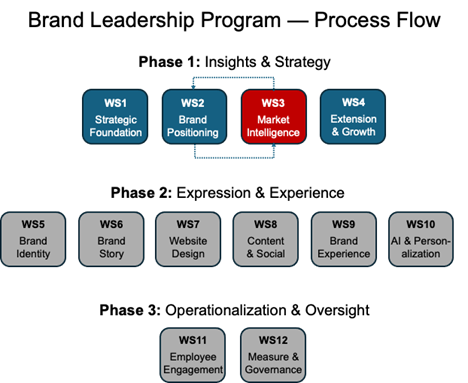
Brand Hierarchy and Types: Understanding the Structure of Brands
For many companies, branding is not just about managing a single entity—it’s about managing a portfolio of brands, each with its own role within the company’s broader business strategy. This is where the concept of brand “hierarchy” comes into play. Brand hierarchy refers to the level within the organization a brand resides. Five levels will be discussed and illustrated: corporate, BU/division, solution, product, and ingredient.
At the top of the hierarchy is often the corporate brand, which represents the organization as a whole. Beneath that, there may be product brands, which represent individual products or services, or sub-brands, which operate within the context of the corporate brand but have their own distinct identity. Companies like Unilever, Nestlé, and General Motors manage complex brand portfolios, with dozens of brands serving different markets and customer segments.
During this workshop, we’ll also explore several different “types” of brands and how they fit into a company’s overall brand portfolio. For example, you’ll learn about master brands (like Google, which lends its name to multiple products), endorsed brands (like Courtyard by Marriott, which is tied to its parent brand while maintaining its own identity), sub-brands (like Amazon Prime, which is a subscription service for the Amazon master brand), and co-brands (like Nike+, a collaboration between Nike and Apple).
Brand Architecture: Structuring Your Brand Portfolio for Success
When the above two concepts of brand “hierarchy” and “types” are combined, you essentially have brand architecture. Brand architecture is the strategic framework that defines how brands within a portfolio are organized and how they relate to one another (if at all). It’s about creating a clear, logical and intuitive structure that makes sense to consumers, and maximizes profitability and internal efficiencies for the companies that manage the brands.
In today’s workshop, we will explore different types of brand architecture, including the Branded House (where the corporate brand is the dominant identity, as seen with Google), the House of Brands (where individual brands operate independently, as seen with Procter & Gamble), and hybrid models that combine elements of both. You’ll learn how to assess your brand portfolio and determine the best architecture structure for your business, based on factors like market needs, customer preferences, competitive dynamics, and business strategy. By the end, you’ll have a strategic framework for managing your brand architecture in a way that drives growth, improves efficiency, and enhances individual and collective brand equity.
Corporate Brand: The Heart of the Company
For most companies, corporate brand and product brand represent the two most important types of brands in their portfolio. Corporate brand is more than just a company name or a logo—it is the identity that embodies the company’s mission, vision, and values. We’ll focus on the role of the corporate brand within the portfolio, and how it influences everything from internal culture to external reputation.
Corporate brands are critical because they often (although not always) serve as the foundation upon which all other brands are built. When consumers think of Apple, for example, they don’t just think of iPhones or MacBooks; they think of innovation, creativity, and design excellence. The corporate brand serves as a unifying force that ties all of Apple’s products together under a single, cohesive identity.
But the corporate brand is not just about consumer perception and driving purchase behavior. It also plays a crucial role in building trust with investors, media, regulators, employees, and other stakeholders. A strong corporate brand has been known to attract top talent, drive investor confidence, and inspire loyalty and camaraderie among employees.
Product Brand: Crafting Distinctive Identities for Your Offerings
While the corporate brand sets the stage for the overarching company, product brands focus on the specific products or services a company offers. Sometimes the product brand is closely associated with the corporate brand, where other times it is not. Determining this relationship (or lack thereof) is part of brand architecture, and it is an important strategic choice.
Regardless of proximity to corporate brand, each product brand must carve out its own value proposition within the broader corporate structure, ensuring that it resonates with its target market while staying aligned with the company’s core values.
In this workshop, we will dive into the world of product branding, exploring how companies like Nestlé, General Motors, and Sony manage multiple product brands that cater to different markets, demographic and psychographic consumer segments, and price points. By the end of this session, you’ll understand how to create brands (whether corporate or product) that stand out in a crowded market while reinforcing the overall corporate brand identity.
Defining the Market: Identifying the Competitive Landscape
The critical task of positioning your brand—which will be undertaken in Workshop #2— requires first defining and understanding the market within which it competes. This involves defining not only the product categories it operates in, but also the customer segments and geographic regions being targeted. This is what we refer to as market definition—or the brand’s “frame of reference”—i.e., where it fits within the broader competitive landscape.
Defining the market is the first step in positioning your brand for success, as it helps you understand where you are relative to your competitors and what factors influence your target customers’ buying decisions. By the end of this session, you will have a clear understanding of how to appropriately define your market, and how to eventually use that information to position your brand effectively in the next workshop.
Aligning Brand Strategy with Business Strategy
With market definition articulated, another important aspect of branding is ensuring that brand strategy is fully aligned with business strategy. A successful brand doesn’t exist in isolation—it must support the broader goals of the organization, from driving revenue growth to improving operational efficiency to fulfilling social and other cause-related purposes.
As such, we will explore how key components of your business strategy—e.g., mission, vision, and values, financial, operational and marketing objectives, and more—factor into brand strategy, ensuring that the two are mutually reinforcing. By the end of this session, you will understand the inextricable linkage that needs to exist between business and brand; and the critical role that brand plays in achieving your company’s business objectives.
Building a Knowledge Base for Long-Term Brand Success
The final course module of today’s workshop focuses on building a knowledge base for your brand. A knowledge base is a repository of data, insights, and strategy that helps guide brand decisions over time. Among other things, it helps you determine the optimal strategic positioning for your brand to occupy.
We will discuss how to collect and organize brand data, from customer feedback and performance metrics to market research and competitive analysis. You’ll learn how to use this data to inform your brand strategy and make informed decisions that drive long-term brand success.
After evaluating your existing knowledge base, you will have an understanding as to whether you have enough information to successfully position your brand during Workshop #2, or if there are knowledge gaps that you’d like to close through conducting new primary market research (Workshop #3). Regardless of which path you choose, you will have a knowledge base that can evolve with your brand, helping you to not only make critical initial decisions—such as brand positioning—but also to adapt to changes in the market while staying true to your brand’s core identity.
Executive Summary
Chapter 1: History of Branding
This course module traces the evolution of branding from its early origins in ancient civilizations to its modern-day complexities. It highlights how branding has transitioned from simple marks of ownership in Mesopotamia and Egypt to a sophisticated system of identity, trust, and emotional connection. The course module emphasizes significant milestones, such as the rise of branding during the Industrial Revolution, the birth of national brands like those of Procter & Gamble, and the legal protection of trademarks. It also delves into the role of branding in the age of advertising, emotional branding, and corporate identity.
Moreover, it explores modern-day concepts, including brand equity, digital branding, and the impact of globalization, personalization, and brand activism. Finally, the future of branding is addressed through the integration of artificial intelligence, automation, and immersive technologies like virtual and augmented reality. Ultimately, the content contained in this course module underscores branding’s enduring role in shaping consumer trust, loyalty, and differentiation in a competitive, ever-evolving marketplace.

Chapter 2: Defining Brand
The “Defining Brand” module delves into the multi-dimensional nature of a brand, showcasing several influential perspectives on the topic. David Aaker, Seth Godin, and Walter Landor offer varied definitions, emphasizing that a brand is both a tangible identifier and a psychological perception, rooted in consumer experiences. The majority of the module is dedicated to illustrating the myriad different ways to define a brand, including its role as an emotional connector, cultural construct, marketing tool, personal relationship, customer experience, trademark, and legal asset. Through these lenses, and several others, brands serve not only as a means for differentiation but also as critical assets that shape customer perceptions and drive business success. In total, the course module proposes a holistic understanding of branding, focusing on both strategy and execution for long-term market impact and business success.

Chapter 3: Brand Value & Valuation
The course module “Brand Value & Valuation” provides an in-depth exploration of the financial and strategic significance of brand value, particularly focusing on the measurable benefits of strong brands. It highlights nine key advantages enjoyed by top brands, including superior stock market performance, premium pricing power, greater consumer preference, market penetration, and resilience during economic downturns. The course module also explains how strong brands drive long-term profitability through innovation, market share dominance, and employee engagement. The back half of the course module delves into the methodologies used for brand valuation, such as the income approach, market approach, and cost approach, with specific attention to popular surveys and models like Interbrand’s Best Global Brands and Kantar’s BrandZ. Additionally, it presents a case study on the Kraft-Heinz merger, illustrating the role brand valuation served in facilitating that complex M&A transaction. Overall, the course module underscores the importance of quantifying brand value for strategic decision-making, investor relations, and maintaining a competitive advantage in the marketplace.

Chapter 4: Brand Ecosystem
The “Brand Ecosystem” course module presents a comprehensive framework for effective brand management, emphasizing the interplay between strategy and execution. It introduces key components of brand strategy, such as portfolio foundation, brand positioning, and extension and growth. The portfolio foundation defines brand hierarchies and the need for alignment with business strategy, while brand positioning serves as the guiding “North Star” for activation, ensuring relevance and differentiation.
The course module also covers essential aspects of brand activation, including brand identity, storytelling, website design, and content marketing. It highlights the growing role of AI and hyper-personalization in modern branding and the importance of employee engagement in delivering the brand experience. Finally, it emphasizes the need for ongoing brand measurement and governance to track performance and guide strategy. At the end, a comprehensive case study of Airbnb illustrates how a methodical approach to brand-building—based on core consumer insights, strategy development, creative expression, and consistent activation—can lead to brand leadership.

Chapter 5: Brand Hierarchy & Types
The course module “Brand Hierarchy & Types” outlines key concepts in brand architecture, focusing on two main ideas: brand hierarchy and brand types. Brand “hierarchy” refers to the different levels within an organization where branding occurs, including corporate, business unit, solution, product, and ingredient levels. These layers help companies strategically manage their branding across diverse product lines and/or business segments. For instance, corporate brands like Apple or IBM operate at the highest level, whereas solution brands like Microsoft Azure offer a comprehensive approach to solving clusters of customer needs.
The second part of the course module covers five primary brand “types”: master brands, endorsed brands, co-brands, sub-brands, and descriptive brands. These brand types help companies structure their branding strategies to target specific markets while leveraging the overall brand’s strength. For example, master brands like Virgin span multiple product lines, while co-brands like GoPro and Red Bull illustrate successful co-branding partnerships. Importantly, this course module sets the stage for the role of brand architecture in shaping a company’s market presence (Course Module 8).

Chapter 6: Corporate Brand
The “Corporate Brand” course module provides a comprehensive examination of corporate branding, distinguishing it from product and other types of branding. It emphasizes the unique strategic role a corporate brand plays in fostering loyalty, trust, and engagement. Key topics include the rising importance of corporate branding, which has become evident through increased advertising spend on corporate brands. The course module outlines the financial benefits of strong corporate brands, including enhanced market valuation and influence on M&A activity. It also explores how corporate brands serve as a vital asset during crises, helping organizations navigate challenges and maintain public trust. Furthermore, corporate branding supports market penetration, cost-effective operations, and fosters internal esprit de corps, enhancing employee pride and engagement. Through numerous real-world examples, the course module illustrates the enduring power of corporate brands in driving long-term success, making them invaluable assets regardless of sector or industry.

Chapter 7: Product Brand
The course module on “Product Brand” provides a comprehensive exploration of the distinctions and synergies between product branding and corporate branding. Product branding focuses on creating a unique identity for specific products, aiming to differentiate them in the marketplace and drive consumer loyalty. In contrast, corporate branding (per the previous course module) represents the overall perception of the company and must appeal to a broader array of stakeholders, including investors and employees. This course module delves into the core elements of product branding, such as its focus on driving consumer preference, loyalty, and immediate calls-to-action. It also highlights the importance of emotional connections, brand architecture, longevity, and the financial value important to all types of brands. The course module concludes with a product branding case study on the iPhone, which illustrates the harmonious relationship between corporate and product branding, and it emphasizes the strategic importance of aligning a company’s overarching identity with its product lines.

Chapter 8: Brand Architecture
This course module integrates the concepts from the three previous course modules on brand hierarchy and types. It provides an in-depth overview of brand architecture, focusing on how companies structure and manage their brand portfolios. It explains the continuum from a “Branded House” (where a single master brand, like Apple, dominates) to a “House of Brands” (where multiple brands operate independently, as with Unilever). The hybrid approach, which lies between these extremes, is also explored. Key considerations for determining optimal brand portfolio structure include the number of customer segments, the breadth of product offerings, the relevance of the corporate brand, investment levels in branding, and the company’s brand management competency. Additionally, the concept of “brand equity flow” is introduced, which refers to the strategic transfer of brand equity between related brands. Real-world examples, like FedEx’s acquisition and rebranding of Kinko’s, illustrate these principles. The course module also offers guidance on evaluating a company’s brand portfolio to determine if an alternative brand architecture would be optimal.

Chapter 9: Market Definition
The “Market Definition” course module defines a market as the collective interaction of buyers and sellers for specific products and services within a designated area, either physical or virtual. It outlines the three primary business models—B2B (Business-to-Business), B2C (Business-to-Consumer), and B2B2C (Business-to-Business-to-Consumer)—emphasizing their distinct dynamics. The B2B model involves complex, long-term partnerships between companies, while the B2C model focuses on direct transactions with individual consumers. B2B2C acts as a hybrid, where a business serves consumers through another business, as seen with digital platforms like Uber Eats.
Additionally, the course module discusses market segmentation based on three components: product/service categories, consumer/customer segments, and geographic regions. Effective segmentation helps businesses optimize their strategies by targeting specific groups, thereby improving satisfaction and unlocking growth opportunities. The course module concludes with a case study of Deloitte, highlighting how its diverse service offerings align with different industry sectors. Understanding market definition will be important in Workshop #2 on brand positioning.

Chapter 10: Business Strategy
The “Business Strategy” course module provides a comprehensive framework for aligning brand strategy with business strategy. It emphasizes that brand strategy should not be developed in isolation but instead closely linked to overarching business strategy. Through illustrative examples from companies like Disney, Starbucks, and Amazon, this course module demonstrates how aligning both strategies (business and brand) leads to smarter decision-making, efficient resource allocation, consistent customer experiences, and long-term success. Key components of business strategy—vision, mission, values, financial and operational objectives, market goals, SWOT analysis, and action plans—are explained in detail. By examining each of these, companies can develop a cohesive approach that ensures both improved business profitability and increased, long-term brand equity. The course module also includes a case study of Tesla, outlining how the framework could be applied to their business strategy. Following the workshop, participants will be asked to formally document their business strategy within the above framework.

Chapter 11: Brand Assessment
“Brand Assessment” focuses on assessing the alignment between a company’s brand and its business strategy. It re-introduces the seven-component business strategy framework from the previous course module as a means for determining how well a brand fits within the business strategy, including mission, vision, and values alignment, financial objectives, operational objectives, marketing objectives, SWOT analysis, strategic objectives, and action plans. Each component is examined through detailed criteria such as cultural fit, employee advocacy, and scalability.
The course module provides questions for assessing the brand’s performance in these areas, helping organizations identify strengths, weaknesses, and opportunities for better alignment. Additionally, a case study of Amazon is used to demonstrate the assessment process, highlighting both strong brand-business alignment and areas potentially needing improvement. The module also includes an exercise for participants to rate their own brand’s alignment with business strategy, emphasizing the importance of continuous evaluation for maintaining a competitive and coherent brand identity.

Chapter 12: Knowledge Base
“Knowledge Base,” the final course module of this workshop, focuses on guiding participants through an exercise of evaluating their current information/knowledge base to identify potential sources for the Brand Leadership program. It emphasizes the importance of assessing existing knowledge resources before determining the need for potentially conducting new primary market research, which will be covered in a future workshop. The course module outlines two key sources of data to leverage: in-house resources (like brand guidelines, market performance data, and customer insights) and external sources (such as market research and competitive analysis). These resources are critical for crafting a brand positioning strategy (which will be the primary task in Workshop #2) that aligns with the company’s mission and market realities.
The course module also demonstrates how information sources that are vital to brand positioning may also be potentially useful for subsequent phases of the program, including expression, experience, operationalization, and oversight. Net-net, it encourages participants to consider internal, external, qualitative, and quantitative resources for both immediate brand positioning and future, brand-related decision-making.
Please see below for an illustrative overview of the 12 course modules that comprise Workshop #1.
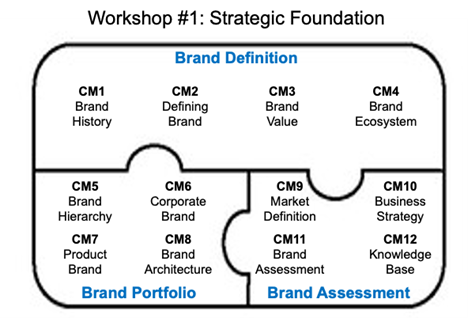
Curriculum
Brand Leadership – WDP1 (Strategic Foundation)
- History of Branding
- Defining Brand
- Brand Value & Valuation
- Brand Ecosystem
- Brand Hierarchy & Types
- Corporate Brand
- Product Brand
- Brand Architecture
- Market Definition
- Business Strategy
- Brand Assessment
- Knowledge Base
Distance Learning
Introduction
Welcome to Appleton Greene and thank you for enrolling on the Brand Leadership corporate training program. You will be learning through our unique facilitation via distance-learning method, which will enable you to practically implement everything that you learn academically. The methods and materials used in your program have been designed and developed to ensure that you derive the maximum benefits and enjoyment possible. We hope that you find the program challenging and fun to do. However, if you have never been a distance-learner before, you may be experiencing some trepidation at the task before you. So we will get you started by giving you some basic information and guidance on how you can make the best use of the modules, how you should manage the materials and what you should be doing as you work through them. This guide is designed to point you in the right direction and help you to become an effective distance-learner. Take a few hours or so to study this guide and your guide to tutorial support for students, while making notes, before you start to study in earnest.
Study environment
You will need to locate a quiet and private place to study, preferably a room where you can easily be isolated from external disturbances or distractions. Make sure the room is well-lit and incorporates a relaxed, pleasant feel. If you can spoil yourself within your study environment, you will have much more of a chance to ensure that you are always in the right frame of mind when you do devote time to study. For example, a nice fire, the ability to play soft soothing background music, soft but effective lighting, perhaps a nice view if possible and a good size desk with a comfortable chair. Make sure that your family know when you are studying and understand your study rules. Your study environment is very important. The ideal situation, if at all possible, is to have a separate study, which can be devoted to you. If this is not possible then you will need to pay a lot more attention to developing and managing your study schedule, because it will affect other people as well as yourself. The better your study environment, the more productive you will be.
Study tools & rules
Try and make sure that your study tools are sufficient and in good working order. You will need to have access to a computer, scanner and printer, with access to the internet. You will need a very comfortable chair, which supports your lower back, and you will need a good filing system. It can be very frustrating if you are spending valuable study time trying to fix study tools that are unreliable, or unsuitable for the task. Make sure that your study tools are up to date. You will also need to consider some study rules. Some of these rules will apply to you and will be intended to help you to be more disciplined about when and how you study. This distance-learning guide will help you and after you have read it you can put some thought into what your study rules should be. You will also need to negotiate some study rules for your family, friends or anyone who lives with you. They too will need to be disciplined in order to ensure that they can support you while you study. It is important to ensure that your family and friends are an integral part of your study team. Having their support and encouragement can prove to be a crucial contribution to your successful completion of the program. Involve them in as much as you can.
Successful distance-learning
Distance-learners are freed from the necessity of attending regular classes or workshops, since they can study in their own way, at their own pace and for their own purposes. But unlike traditional internal training courses, it is the student’s responsibility, with a distance-learning program, to ensure that they manage their own study contribution. This requires strong self-discipline and self-motivation skills and there must be a clear will to succeed. Those students who are used to managing themselves, are good at managing others and who enjoy working in isolation, are more likely to be good distance-learners. It is also important to be aware of the main reasons why you are studying and of the main objectives that you are hoping to achieve as a result. You will need to remind yourself of these objectives at times when you need to motivate yourself. Never lose sight of your long-term goals and your short-term objectives. There is nobody available here to pamper you, or to look after you, or to spoon-feed you with information, so you will need to find ways to encourage and appreciate yourself while you are studying. Make sure that you chart your study progress, so that you can be sure of your achievements and re-evaluate your goals and objectives regularly.
Self-assessment
Appleton Greene training programs are in all cases post-graduate programs. Consequently, you should already have obtained a business-related degree and be an experienced learner. You should therefore already be aware of your study strengths and weaknesses. For example, which time of the day are you at your most productive? Are you a lark or an owl? What study methods do you respond to the most? Are you a consistent learner? How do you discipline yourself? How do you ensure that you enjoy yourself while studying? It is important to understand yourself as a learner and so some self-assessment early on will be necessary if you are to apply yourself correctly. Perform a SWOT analysis on yourself as a student. List your internal strengths and weaknesses as a student and your external opportunities and threats. This will help you later on when you are creating a study plan. You can then incorporate features within your study plan that can ensure that you are playing to your strengths, while compensating for your weaknesses. You can also ensure that you make the most of your opportunities, while avoiding the potential threats to your success.
Accepting responsibility as a student
Training programs invariably require a significant investment, both in terms of what they cost and in the time that you need to contribute to study and the responsibility for successful completion of training programs rests entirely with the student. This is never more apparent than when a student is learning via distance-learning. Accepting responsibility as a student is an important step towards ensuring that you can successfully complete your training program. It is easy to instantly blame other people or factors when things go wrong. But the fact of the matter is that if a failure is your failure, then you have the power to do something about it, it is entirely in your own hands. If it is always someone else’s failure, then you are powerless to do anything about it. All students study in entirely different ways, this is because we are all individuals and what is right for one student, is not necessarily right for another. In order to succeed, you will have to accept personal responsibility for finding a way to plan, implement and manage a personal study plan that works for you. If you do not succeed, you only have yourself to blame.
Planning
By far the most critical contribution to stress, is the feeling of not being in control. In the absence of planning we tend to be reactive and can stumble from pillar to post in the hope that things will turn out fine in the end. Invariably they don’t! In order to be in control, we need to have firm ideas about how and when we want to do things. We also need to consider as many possible eventualities as we can, so that we are prepared for them when they happen. Prescriptive Change, is far easier to manage and control, than Emergent Change. The same is true with distance-learning. It is much easier and much more enjoyable, if you feel that you are in control and that things are going to plan. Even when things do go wrong, you are prepared for them and can act accordingly without any unnecessary stress. It is important therefore that you do take time to plan your studies properly.
Management
Once you have developed a clear study plan, it is of equal importance to ensure that you manage the implementation of it. Most of us usually enjoy planning, but it is usually during implementation when things go wrong. Targets are not met and we do not understand why. Sometimes we do not even know if targets are being met. It is not enough for us to conclude that the study plan just failed. If it is failing, you will need to understand what you can do about it. Similarly if your study plan is succeeding, it is still important to understand why, so that you can improve upon your success. You therefore need to have guidelines for self-assessment so that you can be consistent with performance improvement throughout the program. If you manage things correctly, then your performance should constantly improve throughout the program.
Study objectives & tasks
The first place to start is developing your program objectives. These should feature your reasons for undertaking the training program in order of priority. Keep them succinct and to the point in order to avoid confusion. Do not just write the first things that come into your head because they are likely to be too similar to each other. Make a list of possible departmental headings, such as: Customer Service; E-business; Finance; Globalization; Human Resources; Technology; Legal; Management; Marketing and Production. Then brainstorm for ideas by listing as many things that you want to achieve under each heading and later re-arrange these things in order of priority. Finally, select the top item from each department heading and choose these as your program objectives. Try and restrict yourself to five because it will enable you to focus clearly. It is likely that the other things that you listed will be achieved if each of the top objectives are achieved. If this does not prove to be the case, then simply work through the process again.
Study forecast
As a guide, the Appleton Greene Brand Leadership corporate training program should take 12-18 months to complete, depending upon your availability and current commitments. The reason why there is such a variance in time estimates is because every student is an individual, with differing productivity levels and different commitments. These differentiations are then exaggerated by the fact that this is a distance-learning program, which incorporates the practical integration of academic theory as an as a part of the training program. Consequently all of the project studies are real, which means that important decisions and compromises need to be made. You will want to get things right and will need to be patient with your expectations in order to ensure that they are. We would always recommend that you are prudent with your own task and time forecasts, but you still need to develop them and have a clear indication of what are realistic expectations in your case. With reference to your time planning: consider the time that you can realistically dedicate towards study with the program every week; calculate how long it should take you to complete the program, using the guidelines featured here; then break the program down into logical modules and allocate a suitable proportion of time to each of them, these will be your milestones; you can create a time plan by using a spreadsheet on your computer, or a personal organizer such as MS Outlook, you could also use a financial forecasting software; break your time forecasts down into manageable chunks of time, the more specific you can be, the more productive and accurate your time management will be; finally, use formulas where possible to do your time calculations for you, because this will help later on when your forecasts need to change in line with actual performance. With reference to your task planning: refer to your list of tasks that need to be undertaken in order to achieve your program objectives; with reference to your time plan, calculate when each task should be implemented; remember that you are not estimating when your objectives will be achieved, but when you will need to focus upon implementing the corresponding tasks; you also need to ensure that each task is implemented in conjunction with the associated training modules which are relevant; then break each single task down into a list of specific to do’s, say approximately ten to do’s for each task and enter these into your study plan; once again you could use MS Outlook to incorporate both your time and task planning and this could constitute your study plan; you could also use a project management software like MS Project. You should now have a clear and realistic forecast detailing when you can expect to be able to do something about undertaking the tasks to achieve your program objectives.
Performance management
It is one thing to develop your study forecast, it is quite another to monitor your progress. Ultimately it is less important whether you achieve your original study forecast and more important that you update it so that it constantly remains realistic in line with your performance. As you begin to work through the program, you will begin to have more of an idea about your own personal performance and productivity levels as a distance-learner. Once you have completed your first study module, you should re-evaluate your study forecast for both time and tasks, so that they reflect your actual performance level achieved. In order to achieve this you must first time yourself while training by using an alarm clock. Set the alarm for hourly intervals and make a note of how far you have come within that time. You can then make a note of your actual performance on your study plan and then compare your performance against your forecast. Then consider the reasons that have contributed towards your performance level, whether they are positive or negative and make a considered adjustment to your future forecasts as a result. Given time, you should start achieving your forecasts regularly.
With reference to time management: time yourself while you are studying and make a note of the actual time taken in your study plan; consider your successes with time-efficiency and the reasons for the success in each case and take this into consideration when reviewing future time planning; consider your failures with time-efficiency and the reasons for the failures in each case and take this into consideration when reviewing future time planning; re-evaluate your study forecast in relation to time planning for the remainder of your training program to ensure that you continue to be realistic about your time expectations. You need to be consistent with your time management, otherwise you will never complete your studies. This will either be because you are not contributing enough time to your studies, or you will become less efficient with the time that you do allocate to your studies. Remember, if you are not in control of your studies, they can just become yet another cause of stress for you.
With reference to your task management: time yourself while you are studying and make a note of the actual tasks that you have undertaken in your study plan; consider your successes with task-efficiency and the reasons for the success in each case; take this into consideration when reviewing future task planning; consider your failures with task-efficiency and the reasons for the failures in each case and take this into consideration when reviewing future task planning; re-evaluate your study forecast in relation to task planning for the remainder of your training program to ensure that you continue to be realistic about your task expectations. You need to be consistent with your task management, otherwise you will never know whether you are achieving your program objectives or not.
Keeping in touch
You will have access to qualified and experienced professors and tutors who are responsible for providing tutorial support for your particular training program. So don’t be shy about letting them know how you are getting on. We keep electronic records of all tutorial support emails so that professors and tutors can review previous correspondence before considering an individual response. It also means that there is a record of all communications between you and your professors and tutors and this helps to avoid any unnecessary duplication, misunderstanding, or misinterpretation. If you have a problem relating to the program, share it with them via email. It is likely that they have come across the same problem before and are usually able to make helpful suggestions and steer you in the right direction. To learn more about when and how to use tutorial support, please refer to the Tutorial Support section of this student information guide. This will help you to ensure that you are making the most of tutorial support that is available to you and will ultimately contribute towards your success and enjoyment with your training program.
Work colleagues and family
You should certainly discuss your program study progress with your colleagues, friends and your family. Appleton Greene training programs are very practical. They require you to seek information from other people, to plan, develop and implement processes with other people and to achieve feedback from other people in relation to viability and productivity. You will therefore have plenty of opportunities to test your ideas and enlist the views of others. People tend to be sympathetic towards distance-learners, so don’t bottle it all up in yourself. Get out there and share it! It is also likely that your family and colleagues are going to benefit from your labors with the program, so they are likely to be much more interested in being involved than you might think. Be bold about delegating work to those who might benefit themselves. This is a great way to achieve understanding and commitment from people who you may later rely upon for process implementation. Share your experiences with your friends and family.
Making it relevant
The key to successful learning is to make it relevant to your own individual circumstances. At all times you should be trying to make bridges between the content of the program and your own situation. Whether you achieve this through quiet reflection or through interactive discussion with your colleagues, client partners or your family, remember that it is the most important and rewarding aspect of translating your studies into real self-improvement. You should be clear about how you want the program to benefit you. This involves setting clear study objectives in relation to the content of the course in terms of understanding, concepts, completing research or reviewing activities and relating the content of the modules to your own situation. Your objectives may understandably change as you work through the program, in which case you should enter the revised objectives on your study plan so that you have a permanent reminder of what you are trying to achieve, when and why.
Distance-learning check-list
Prepare your study environment, your study tools and rules.
Undertake detailed self-assessment in terms of your ability as a learner.
Create a format for your study plan.
Consider your study objectives and tasks.
Create a study forecast.
Assess your study performance.
Re-evaluate your study forecast.
Be consistent when managing your study plan.
Use your Appleton Greene Certified Learning Provider (CLP) for tutorial support.
Make sure you keep in touch with those around you.

Tutorial Support
Programs
Appleton Greene uses standard and bespoke corporate training programs as vessels to transfer business process improvement knowledge into the heart of our clients’ organizations. Each individual program focuses upon the implementation of a specific business process, which enables clients to easily quantify their return on investment. There are hundreds of established Appleton Greene corporate training products now available to clients within customer services, e-business, finance, globalization, human resources, information technology, legal, management, marketing and production. It does not matter whether a client’s employees are located within one office, or an unlimited number of international offices, we can still bring them together to learn and implement specific business processes collectively. Our approach to global localization enables us to provide clients with a truly international service with that all important personal touch. Appleton Greene corporate training programs can be provided virtually or locally and they are all unique in that they individually focus upon a specific business function. They are implemented over a sustainable period of time and professional support is consistently provided by qualified learning providers and specialist consultants.
Support available
You will have a designated Certified Learning Provider (CLP) and an Accredited Consultant and we encourage you to communicate with them as much as possible. In all cases tutorial support is provided online because we can then keep a record of all communications to ensure that tutorial support remains consistent. You would also be forwarding your work to the tutorial support unit for evaluation and assessment. You will receive individual feedback on all of the work that you undertake on a one-to-one basis, together with specific recommendations for anything that may need to be changed in order to achieve a pass with merit or a pass with distinction and you then have as many opportunities as you may need to re-submit project studies until they meet with the required standard. Consequently the only reason that you should really fail (CLP) is if you do not do the work. It makes no difference to us whether a student takes 12 months or 18 months to complete the program, what matters is that in all cases the same quality standard will have been achieved.
Support Process
Please forward all of your future emails to the designated (CLP) Tutorial Support Unit email address that has been provided and please do not duplicate or copy your emails to other AGC email accounts as this will just cause unnecessary administration. Please note that emails are always answered as quickly as possible but you will need to allow a period of up to 20 business days for responses to general tutorial support emails during busy periods, because emails are answered strictly within the order in which they are received. You will also need to allow a period of up to 30 business days for the evaluation and assessment of project studies. This does not include weekends or public holidays. Please therefore kindly allow for this within your time planning. All communications are managed online via email because it enables tutorial service support managers to review other communications which have been received before responding and it ensures that there is a copy of all communications retained on file for future reference. All communications will be stored within your personal (CLP) study file here at Appleton Greene throughout your designated study period. If you need any assistance or clarification at any time, please do not hesitate to contact us by forwarding an email and remember that we are here to help. If you have any questions, please list and number your questions succinctly and you can then be sure of receiving specific answers to each and every query.
Time Management
It takes approximately 1 Year to complete the Brand Leadership corporate training program, incorporating 12 x 6-hour monthly workshops. Each student will also need to contribute approximately 4 hours per week over 1 Year of their personal time. Students can study from home or work at their own pace and are responsible for managing their own study plan. There are no formal examinations and students are evaluated and assessed based upon their project study submissions, together with the quality of their internal analysis and supporting documents. They can contribute more time towards study when they have the time to do so and can contribute less time when they are busy. All students tend to be in full time employment while studying and the Brand Leadership program is purposely designed to accommodate this, so there is plenty of flexibility in terms of time management. It makes no difference to us at Appleton Greene, whether individuals take 12-18 months to complete this program. What matters is that in all cases the same standard of quality will have been achieved with the standard and bespoke programs that have been developed.
Distance Learning Guide
The distance learning guide should be your first port of call when starting your training program. It will help you when you are planning how and when to study, how to create the right environment and how to establish the right frame of mind. If you can lay the foundations properly during the planning stage, then it will contribute to your enjoyment and productivity while training later. The guide helps to change your lifestyle in order to accommodate time for study and to cultivate good study habits. It helps you to chart your progress so that you can measure your performance and achieve your goals. It explains the tools that you will need for study and how to make them work. It also explains how to translate academic theory into practical reality. Spend some time now working through your distance learning guide and make sure that you have firm foundations in place so that you can make the most of your distance learning program. There is no requirement for you to attend training workshops or classes at Appleton Greene offices. The entire program is undertaken online, program course manuals and project studies are administered via the Appleton Greene web site and via email, so you are able to study at your own pace and in the comfort of your own home or office as long as you have a computer and access to the internet.
How To Study
The how to study guide provides students with a clear understanding of the Appleton Greene facilitation via distance learning training methods and enables students to obtain a clear overview of the training program content. It enables students to understand the step-by-step training methods used by Appleton Greene and how course manuals are integrated with project studies. It explains the research and development that is required and the need to provide evidence and references to support your statements. It also enables students to understand precisely what will be required of them in order to achieve a pass with merit and a pass with distinction for individual project studies and provides useful guidance on how to be innovative and creative when developing your Unique Program Proposition (UPP).
Tutorial Support
Tutorial support for the Appleton Greene Brand Leadership corporate training program is provided online either through the Appleton Greene Client Support Portal (CSP), or via email. All tutorial support requests are facilitated by a designated Program Administration Manager (PAM). They are responsible for deciding which professor or tutor is the most appropriate option relating to the support required and then the tutorial support request is forwarded onto them. Once the professor or tutor has completed the tutorial support request and answered any questions that have been asked, this communication is then returned to the student via email by the designated Program Administration Manager (PAM). This enables all tutorial support, between students, professors and tutors, to be facilitated by the designated Program Administration Manager (PAM) efficiently and securely through the email account. You will therefore need to allow a period of up to 20 business days for responses to general support queries and up to 30 business days for the evaluation and assessment of project studies, because all tutorial support requests are answered strictly within the order in which they are received. This does not include weekends or public holidays. Consequently you need to put some thought into the management of your tutorial support procedure in order to ensure that your study plan is feasible and to obtain the maximum possible benefit from tutorial support during your period of study. Please retain copies of your tutorial support emails for future reference. Please ensure that ALL of your tutorial support emails are set out using the format as suggested within your guide to tutorial support. Your tutorial support emails need to be referenced clearly to the specific part of the course manual or project study which you are working on at any given time. You also need to list and number any questions that you would like to ask, up to a maximum of five questions within each tutorial support email. Remember the more specific you can be with your questions the more specific your answers will be too and this will help you to avoid any unnecessary misunderstanding, misinterpretation, or duplication. The guide to tutorial support is intended to help you to understand how and when to use support in order to ensure that you get the most out of your training program. Appleton Greene training programs are designed to enable you to do things for yourself. They provide you with a structure or a framework and we use tutorial support to facilitate students while they practically implement what they learn. In other words, we are enabling students to do things for themselves. The benefits of distance learning via facilitation are considerable and are much more sustainable in the long-term than traditional short-term knowledge sharing programs. Consequently you should learn how and when to use tutorial support so that you can maximize the benefits from your learning experience with Appleton Greene. This guide describes the purpose of each training function and how to use them and how to use tutorial support in relation to each aspect of the training program. It also provides useful tips and guidance with regard to best practice.
Tutorial Support Tips
Students are often unsure about how and when to use tutorial support with Appleton Greene. This Tip List will help you to understand more about how to achieve the most from using tutorial support. Refer to it regularly to ensure that you are continuing to use the service properly. Tutorial support is critical to the success of your training experience, but it is important to understand when and how to use it in order to maximize the benefit that you receive. It is no coincidence that those students who succeed are those that learn how to be positive, proactive and productive when using tutorial support.
Be positive and friendly with your tutorial support emails
Remember that if you forward an email to the tutorial support unit, you are dealing with real people. “Do unto others as you would expect others to do unto you”. If you are positive, complimentary and generally friendly in your emails, you will generate a similar response in return. This will be more enjoyable, productive and rewarding for you in the long-term.
Think about the impression that you want to create
Every time that you communicate, you create an impression, which can be either positive or negative, so put some thought into the impression that you want to create. Remember that copies of all tutorial support emails are stored electronically and tutors will always refer to prior correspondence before responding to any current emails. Over a period of time, a general opinion will be arrived at in relation to your character, attitude and ability. Try to manage your own frustrations, mood swings and temperament professionally, without involving the tutorial support team. Demonstrating frustration or a lack of patience is a weakness and will be interpreted as such. The good thing about communicating in writing, is that you will have the time to consider your content carefully, you can review it and proof-read it before sending your email to Appleton Greene and this should help you to communicate more professionally, consistently and to avoid any unnecessary knee-jerk reactions to individual situations as and when they may arise. Please also remember that the CLP Tutorial Support Unit will not just be responsible for evaluating and assessing the quality of your work, they will also be responsible for providing recommendations to other learning providers and to client contacts within the Appleton Greene global client network, so do be in control of your own emotions and try to create a good impression.
Remember that quality is preferred to quantity
Please remember that when you send an email to the tutorial support team, you are not using Twitter or Text Messaging. Try not to forward an email every time that you have a thought. This will not prove to be productive either for you or for the tutorial support team. Take time to prepare your communications properly, as if you were writing a professional letter to a business colleague and make a list of queries that you are likely to have and then incorporate them within one email, say once every month, so that the tutorial support team can understand more about context, application and your methodology for study. Get yourself into a consistent routine with your tutorial support requests and use the tutorial support template provided with ALL of your emails. The (CLP) Tutorial Support Unit will not spoon-feed you with information. They need to be able to evaluate and assess your tutorial support requests carefully and professionally.
Be specific about your questions in order to receive specific answers
Try not to write essays by thinking as you are writing tutorial support emails. The tutorial support unit can be unclear about what in fact you are asking, or what you are looking to achieve. Be specific about asking questions that you want answers to. Number your questions. You will then receive specific answers to each and every question. This is the main purpose of tutorial support via email.
Keep a record of your tutorial support emails
It is important that you keep a record of all tutorial support emails that are forwarded to you. You can then refer to them when necessary and it avoids any unnecessary duplication, misunderstanding, or misinterpretation.
Individual training workshops or telephone support
Please be advised that Appleton Greene does not provide separate or individual tutorial support meetings, workshops, or provide telephone support for individual students. Appleton Greene is an equal opportunities learning and service provider and we are therefore understandably bound to treat all students equally. We cannot therefore broker special financial or study arrangements with individual students regardless of the circumstances. All tutorial support is provided online and this enables Appleton Greene to keep a record of all communications between students, professors and tutors on file for future reference, in accordance with our quality management procedure and your terms and conditions of enrolment. All tutorial support is provided online via email because it enables us to have time to consider support content carefully, it ensures that you receive a considered and detailed response to your queries. You can number questions that you would like to ask, which relate to things that you do not understand or where clarification may be required. You can then be sure of receiving specific answers to each individual query. You will also then have a record of these communications and of all tutorial support, which has been provided to you. This makes tutorial support administration more productive by avoiding any unnecessary duplication, misunderstanding, or misinterpretation.
Tutorial Support Email Format
You should use this tutorial support format if you need to request clarification or assistance while studying with your training program. Please note that ALL of your tutorial support request emails should use the same format. You should therefore set up a standard email template, which you can then use as and when you need to. Emails that are forwarded to Appleton Greene, which do not use the following format, may be rejected and returned to you by the (CLP) Program Administration Manager. A detailed response will then be forwarded to you via email usually within 20 business days of receipt for general support queries and 30 business days for the evaluation and assessment of project studies. This does not include weekends or public holidays. Your tutorial support request, together with the corresponding TSU reply, will then be saved and stored within your electronic TSU file at Appleton Greene for future reference.
Subject line of your email
Please insert: Appleton Greene (CLP) Tutorial Support Request: (Your Full Name) (Date), within the subject line of your email.
Main body of your email
Please insert:
1. Appleton Greene Certified Learning Provider (CLP) Tutorial Support Request
2. Your Full Name
3. Date of TS request
4. Preferred email address
5. Backup email address
6. Course manual page name or number (reference)
7. Project study page name or number (reference)
Subject of enquiry
Please insert a maximum of 50 words (please be succinct)
Briefly outline the subject matter of your inquiry, or what your questions relate to.
Question 1
Maximum of 50 words (please be succinct)
Maximum of 50 words (please be succinct)
Question 3
Maximum of 50 words (please be succinct)
Question 4
Maximum of 50 words (please be succinct)
Question 5
Maximum of 50 words (please be succinct)
Please note that a maximum of 5 questions is permitted with each individual tutorial support request email.
Procedure
* List the questions that you want to ask first, then re-arrange them in order of priority. Make sure that you reference them, where necessary, to the course manuals or project studies.
* Make sure that you are specific about your questions and number them. Try to plan the content within your emails to make sure that it is relevant.
* Make sure that your tutorial support emails are set out correctly, using the Tutorial Support Email Format provided here.
* Save a copy of your email and incorporate the date sent after the subject title. Keep your tutorial support emails within the same file and in date order for easy reference.
* Allow up to 20 business days for a response to general tutorial support emails and up to 30 business days for the evaluation and assessment of project studies, because detailed individual responses will be made in all cases and tutorial support emails are answered strictly within the order in which they are received.
* Emails can and do get lost. So if you have not received a reply within the appropriate time, forward another copy or a reminder to the tutorial support unit to be sure that it has been received but do not forward reminders unless the appropriate time has elapsed.
* When you receive a reply, save it immediately featuring the date of receipt after the subject heading for easy reference. In most cases the tutorial support unit replies to your questions individually, so you will have a record of the questions that you asked as well as the answers offered. With project studies however, separate emails are usually forwarded by the tutorial support unit, so do keep a record of your own original emails as well.
* Remember to be positive and friendly in your emails. You are dealing with real people who will respond to the same things that you respond to.
* Try not to repeat questions that have already been asked in previous emails. If this happens the tutorial support unit will probably just refer you to the appropriate answers that have already been provided within previous emails.
* If you lose your tutorial support email records you can write to Appleton Greene to receive a copy of your tutorial support file, but a separate administration charge may be levied for this service.

How To Study
Your Certified Learning Provider (CLP) and Accredited Consultant can help you to plan a task list for getting started so that you can be clear about your direction and your priorities in relation to your training program. It is also a good way to introduce yourself to the tutorial support team.
Planning your study environment
Your study conditions are of great importance and will have a direct effect on how much you enjoy your training program. Consider how much space you will have, whether it is comfortable and private and whether you are likely to be disturbed. The study tools and facilities at your disposal are also important to the success of your distance-learning experience. Your tutorial support unit can help with useful tips and guidance, regardless of your starting position. It is important to get this right before you start working on your training program.
Planning your program objectives
It is important that you have a clear list of study objectives, in order of priority, before you start working on your training program. Your tutorial support unit can offer assistance here to ensure that your study objectives have been afforded due consideration and priority.
Planning how and when to study
Distance-learners are freed from the necessity of attending regular classes, since they can study in their own way, at their own pace and for their own purposes. This approach is designed to let you study efficiently away from the traditional classroom environment. It is important however, that you plan how and when to study, so that you are making the most of your natural attributes, strengths and opportunities. Your tutorial support unit can offer assistance and useful tips to ensure that you are playing to your strengths.
Planning your study tasks
You should have a clear understanding of the study tasks that you should be undertaking and the priority associated with each task. These tasks should also be integrated with your program objectives. The distance learning guide and the guide to tutorial support for students should help you here, but if you need any clarification or assistance, please contact your tutorial support unit.
Planning your time
You will need to allocate specific times during your calendar when you intend to study if you are to have a realistic chance of completing your program on time. You are responsible for planning and managing your own study time, so it is important that you are successful with this. Your tutorial support unit can help you with this if your time plan is not working.
Keeping in touch
Consistency is the key here. If you communicate too frequently in short bursts, or too infrequently with no pattern, then your management ability with your studies will be questioned, both by you and by your tutorial support unit. It is obvious when a student is in control and when one is not and this will depend how able you are at sticking with your study plan. Inconsistency invariably leads to in-completion.
Charting your progress
Your tutorial support team can help you to chart your own study progress. Refer to your distance learning guide for further details.
Making it work
To succeed, all that you will need to do is apply yourself to undertaking your training program and interpreting it correctly. Success or failure lies in your hands and your hands alone, so be sure that you have a strategy for making it work. Your Certified Learning Provider (CLP) and Accredited Consultant can guide you through the process of program planning, development and implementation.
Reading methods
Interpretation is often unique to the individual but it can be improved and even quantified by implementing consistent interpretation methods. Interpretation can be affected by outside interference such as family members, TV, or the Internet, or simply by other thoughts which are demanding priority in our minds. One thing that can improve our productivity is using recognized reading methods. This helps us to focus and to be more structured when reading information for reasons of importance, rather than relaxation.
Speed reading
When reading through course manuals for the first time, subconsciously set your reading speed to be just fast enough that you cannot dwell on individual words or tables. With practice, you should be able to read an A4 sheet of paper in one minute. You will not achieve much in the way of a detailed understanding, but your brain will retain a useful overview. This overview will be important later on and will enable you to keep individual issues in perspective with a more generic picture because speed reading appeals to the memory part of the brain. Do not worry about what you do or do not remember at this stage.
Content reading
Once you have speed read everything, you can then start work in earnest. You now need to read a particular section of your course manual thoroughly, by making detailed notes while you read. This process is called Content Reading and it will help to consolidate your understanding and interpretation of the information that has been provided.
Making structured notes on the course manuals
When you are content reading, you should be making detailed notes, which are both structured and informative. Make these notes in a MS Word document on your computer, because you can then amend and update these as and when you deem it to be necessary. List your notes under three headings: 1. Interpretation – 2. Questions – 3. Tasks. The purpose of the 1st section is to clarify your interpretation by writing it down. The purpose of the 2nd section is to list any questions that the issue raises for you. The purpose of the 3rd section is to list any tasks that you should undertake as a result. Anyone who has graduated with a business-related degree should already be familiar with this process.
Organizing structured notes separately
You should then transfer your notes to a separate study notebook, preferably one that enables easy referencing, such as a MS Word Document, a MS Excel Spreadsheet, a MS Access Database, or a personal organizer on your cell phone. Transferring your notes allows you to have the opportunity of cross-checking and verifying them, which assists considerably with understanding and interpretation. You will also find that the better you are at doing this, the more chance you will have of ensuring that you achieve your study objectives.
Question your understanding
Do challenge your understanding. Explain things to yourself in your own words by writing things down.
Clarifying your understanding
If you are at all unsure, forward an email to your tutorial support unit and they will help to clarify your understanding.
Question your interpretation
Do challenge your interpretation. Qualify your interpretation by writing it down.
Clarifying your interpretation
If you are at all unsure, forward an email to your tutorial support unit and they will help to clarify your interpretation.
Qualification Requirements
The student will need to successfully complete the project study and all of the exercises relating to the Brand Leadership corporate training program, achieving a pass with merit or distinction in each case, in order to qualify as an Accredited Brand Leadership Specialist (ABLS). All monthly workshops need to be tried and tested within your company. These project studies can be completed in your own time and at your own pace and in the comfort of your own home or office. There are no formal examinations, assessment is based upon the successful completion of the project studies. They are called project studies because, unlike case studies, these projects are not theoretical, they incorporate real program processes that need to be properly researched and developed. The project studies assist us in measuring your understanding and interpretation of the training program and enable us to assess qualification merits. All of the project studies are based entirely upon the content within the training program and they enable you to integrate what you have learnt into your corporate training practice.
Brand Leadership – Grading Contribution
Project Study – Grading Contribution
Customer Service – 10%
E-business – 05%
Finance – 10%
Globalization – 10%
Human Resources – 10%
Information Technology – 10%
Legal – 05%
Management – 10%
Marketing – 10%
Production – 10%
Education – 05%
Logistics – 05%
TOTAL GRADING – 100%
Qualification grades
A mark of 90% = Pass with Distinction.
A mark of 75% = Pass with Merit.
A mark of less than 75% = Fail.
If you fail to achieve a mark of 75% with a project study, you will receive detailed feedback from the Certified Learning Provider (CLP) and/or Accredited Consultant, together with a list of tasks which you will need to complete, in order to ensure that your project study meets with the minimum quality standard that is required by Appleton Greene. You can then re-submit your project study for further evaluation and assessment. Indeed you can re-submit as many drafts of your project studies as you need to, until such a time as they eventually meet with the required standard by Appleton Greene, so you need not worry about this, it is all part of the learning process.
When marking project studies, Appleton Greene is looking for sufficient evidence of the following:
Pass with merit
A satisfactory level of program understanding
A satisfactory level of program interpretation
A satisfactory level of project study content presentation
A satisfactory level of Unique Program Proposition (UPP) quality
A satisfactory level of the practical integration of academic theory
Pass with distinction
An exceptional level of program understanding
An exceptional level of program interpretation
An exceptional level of project study content presentation
An exceptional level of Unique Program Proposition (UPP) quality
An exceptional level of the practical integration of academic theory
Preliminary Analysis
Below are sources that were either referenced or directly quoted in preparing the content for Workshop #1. They are also valuable sources if you would like to dig deeper into the workshop’s concepts to learn more.
MODULE 1: HISTORY OF BRAND
• The Origin of Brands: How Product Evolution Creates Endless Possibilities for New Brands, Laura Ries and Al Ries
• Brand New: The History of Branding, Wally Olins
• The Brand Gap, by Marty Neumeie
MODULE 2: DEFINING BRAND
• Building Strong Brands, David A. Aaker
• Brand Identity: Making Brand Strategy Tangible, Kevin Lane Keller
MODULE 3: BRAND VALUE & VALUATION
• Interbrand, 2023 Best Global Brands, www.interbrand.com
• Kantar BrandZ, 2024 Most Valuable Global Brands, www.kantar.com
• Brand Finance’s “Global 500” Report, www.brandfinance.com
• Brand Valuation: Measuring and Managing Brand Value, David Haigh
MODULE 4: BRAND ECOSYSTEM
MODULE 5: BRAND HIERARCHY & TYPES
• The New Strategic Brand Management, Jean-Noël Kapferer
• Kellogg on Branding, Alice M. Tybout and Tim Calkins
• “Branding FedEx Kinko’s,” David Wertheimer
MODULE 6: CORPORATE BRAND
• The Indispensable Brand, Mitch Duckler
• CoreBrand’s Corporate Branding Index
• Denise Lee Yohn (deniseleeyohn.com)
• www.kantar.com
MODULE 7: PRODUCT BRAND
• What Great Brands Do, Denise Lee Yohn
• Positioning: The Battle for Your Mind, Al Ries and Jack Trout
MODULE 8: BRAND ARCHITECTURE
• Brand Portfolio Strategy, David Aaker
• The Indispensable Brand, Mitch Duckler
• Brand Leadership, David Aaker, Erich Joachimsthaler
• Brand Architecture: Designing Visual Identity of Brands, Ruedi Baur, Larissa Kasper
MODULE 9: MARKET DEFINITION
• “Nestlé Marketing Strategy: The Ingredients for Sweet Success,” Brand Credential
• www.deloitte.com
MODULE 10: BUSINESS STRATEGY
• Raul Kumar, Founder & CEO, Resonate Business Ignition
• “A Deep-dive into Tesla’s Business Strategy,” Arieez Dutta
• www.tesla.com
MODULE 11: BRAND ASSESSMENT
• Brand Portfolio Strategy, David Aaker
• Principles of Strategic Brand Management, Kevin Lane Keller
• The Indispensable Brand, Mitch Duckler
• Brand Architecture: The New Blueprint for Brand Building, Denise Lee Yohn
• www.unilever.com
MODULE 12: MARKET KNOWLEDGE
• Marketing Research: An Applied Orientation, Naresh K. Malhotra
• Market Research in Practice, Paul Hague
Course Manuals 1-12
Course Manual 1: History of Brand
No discussion of modern-day branding would be complete without documenting its extraordinary history. As with other facets of business, complex societal, economic, legal, and technological trends heavily shaped how branding has evolved over millennia. Understanding these shifts—and how they impacted the concept of branding—is imperative to any conversation about the topic today. As will be demonstrated in this course module, many of the concepts that define the evolution of branding are the subject of future workshops in the Brand Leadership program.
Suffice it to say, branding has a long and complex history that stretches back thousands of years, evolving alongside human societies and economies. What began as simple marks of ownership and origin gradually developed into a sophisticated system of identity, trust, and emotional connection. The history of branding is not merely about logos and names, but about the ways in which businesses, products, and even individuals have sought to distinguish themselves in a competitive and ever-changing world. As societies advanced and economies globalized, branding became a central tool in shaping perceptions, cultivating loyalty, and driving success.
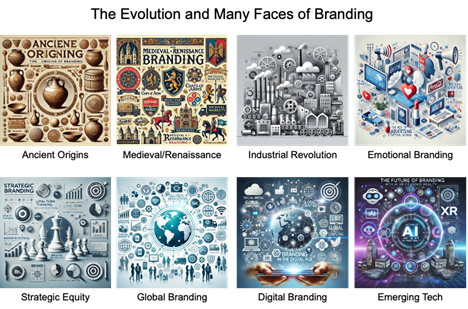
ANCIENT ORIGINS OF BRANDS
The origins of branding can be traced to ancient civilizations, where early artisans and merchants used symbols and marks to signify the origin and quality of their goods. In ancient Mesopotamia, potters would engrave symbols on their pottery to distinguish their work from others, ensuring that their craftsmanship could be recognized across the markets of cities like Ur and Babylon. Similar practices emerged in ancient Egypt and Greece, where craftsmen left identifying marks on metalwork, ceramics, and other goods. These marks were the earliest forms of branding—primitive but essential in a growing economy where reputation and reliability were increasingly valuable.
In Egypt, the practice of branding livestock was also common. Farmers would burn symbols into the hides of their cattle to signify ownership, a practice that extended to other regions as agriculture spread. This form of branding was practical and necessary in agricultural economies where animals were valuable assets. Livestock branding persisted throughout history, becoming particularly important in later centuries when vast ranches in the Americas required a way to mark ownership over large herds of animals.
MEDIEVAL AND REINAISSANCE BRANDING
As trade expanded across Europe and Asia during the medieval and Renaissance periods, branding evolved beyond simple ownership marks. In Europe, guild systems played a crucial role in standardizing craftsmanship and quality. Guilds were associations of artisans and merchants who banded together to regulate their trade, and part of this regulation involved ensuring that members produced high-quality goods. Guild members would mark their products with symbols that indicated their workshop or guild of origin, and these symbols came to represent trust and expertise in a growing commercial economy.
Merchants also began using symbols to identify their goods, especially as long-distance trade became more common. In Venice, for example, the city became known for its high-quality glassmaking, and glassmakers would use distinct marks to signify the origin of their goods. These merchant marks were among the earliest precursors to modern trademarks, serving as a way to establish trust in a time when trade routes were expanding and relationships between buyers and sellers became more impersonal.
Branding also took on a religious dimension during this period. Monasteries and abbeys became associated with certain types of goods, such as wine, cheese, and herbal remedies. Religious orders like the Benedictines and Cistercians would mark their products with emblems or seals, signifying that these goods were produced under spiritual auspices. In this way, branding became intertwined with religious and moral values, adding an additional layer of trust for consumers.
THE INDUSTRIAL REVOLUTION AND MODERNIZATION OF BRANDING
The Industrial Revolution, beginning in the 18th century, dramatically transformed branding as economies moved from localized, hand-produced goods to mass-produced commodities. With the rise of factories and mechanization, goods were produced on a much larger scale, and manufacturers could no longer rely on personal relationships or small community reputations to sell their products. Branding thus became essential for distinguishing one product from another in an increasingly crowded marketplace.
The Industrial Revolution gave birth to the first national brands. Companies like Procter & Gamble, Heinz, and Quaker Oats emerged during the 19th century as pioneers of branding. They not only branded their products, but also built national reputations around the consistency and quality of their goods. These brands became recognizable across large regions, and consumers began to trust them as symbols of reliability. The development of packaging and labeling technologies also contributed to the rise of branding during this period. Canned goods, bottled beverages, and other mass-produced items could now carry distinct logos, colors, and designs that set them apart from competitors on store shelves. This visual identity was a critical step in the evolution of branding, allowing companies to communicate their unique qualities to consumers without needing a personal connection. The concept of brand identity (both visual and verbal expression) will be covered at length in Workshops #5.
The importance of branding also led to the creation of legal protections. In the late 19th century, trademark laws began to emerge, giving companies the ability to register their brand names and symbols. The United Kingdom’s Trade Marks Registration Act of 1875 was one of the first laws to formalize trademark protection, ensuring that companies could protect their brand identities from imitation or theft. This legal recognition of branding as intellectual property was a significant development, as it allowed companies to invest more confidently in their brand identities, knowing that their efforts would be protected by law.
THE AGE OF ADVERTISING AND EMOTIONAL BRANDING
The early 20th century brought new opportunities for branding as mass media—particularly radio and later television—became widely accessible. Brands could now reach large audiences through advertising, and they began to create memorable campaigns that helped build their identity. Companies like Coca-Cola, Ivory Soap, and Colgate invested heavily in advertising, using slogans, jingles, and celebrity endorsements to make their brands household names. This period saw the rise of brand characters and mascots, which helped create emotional connections between consumers and products. For example, the creation of the Michelin Man in 1898 and Planters’ Mr. Peanut in 1916 helped humanize these brands, making them more relatable and memorable.
Branding also began to take on a more emotional and aspirational dimension during this time. Companies sought to build their brands around not just products, but the lifestyles and values associated with them. Coca-Cola, for example, positioned itself as a brand that represented happiness and togetherness, while Marlboro shifted its branding to target men by associating the product with rugged masculinity through the “Marlboro Man” campaign. By the mid-20th century, branding was no longer just about functional benefits; it was about creating an emotional bond with consumers. This shift was especially important in highly competitive markets, where products were often similar in quality, and the brand itself became the primary differentiator. Workshop #2 on brand positioning will delve deeply into the concept of differentiation, and several different means for establishing it.
Corporate branding also emerged as a dominant strategy during the mid-20th century. Large companies like Procter & Gamble and Unilever began to promote their corporate identities, not just their individual products. By building trust in the corporate brand, these companies could launch new products or acquire other businesses with the assurance that their corporate reputation would help drive sales. Corporate branding became a powerful tool for conglomerates, allowing them to leverage their name recognition and reputation to expand their influence across different product categories. More on the topic of corporate branding will follow later in this workshop (Course Module 6).
BRAND EQUITY AND STRATEGIC BRANDING
In the 1980s, branding took another significant leap forward with the introduction of the concept of brand equity. Brand equity, which will be discussed in greater detail in Course Module 3 of this workshop, refers to the value that a brand adds to a product beyond its functional benefits. It is built on customer loyalty, perceived quality, and overall brand awareness. Companies like Apple, Nike, and Disney became masters of brand equity, cultivating strong emotional connections with their customers that allowed them to charge premium prices and maintain market leadership. Brand equity also became a key factor in mergers and acquisitions. For instance, when Kraft acquired Cadbury in 2010, the Cadbury brand was considered one of the most valuable assets in the deal, demonstrating how important brand equity had become in the corporate world.
As brand equity became more valuable, companies began to explore new ways to extend their brands into different product categories. Brand extensions became a popular strategy, allowing companies to capitalize on their strong brand equity by introducing new products under the same brand name. For example, Nike expanded from athletic shoes into clothing, accessories, devices, and equipment, while Disney extended its brand from films into theme parks, merchandise, and television channels. This strategy allowed brands to build on their existing customer base and reputation to drive sales in new markets. Brand extension and growth is the topic of Workshop #4.
GLOBAL BRANDING
At the same time, the rise of globalization in the late 20th century created new challenges and opportunities for branding. Global brands like Coca-Cola, McDonald’s, and Nike became symbols of American culture and values, representing more than just products but a way of life. These brands had to navigate the delicate balance between maintaining a consistent global identity and adapting to local cultures. For instance, McDonald’s retained its iconic golden arches and fast-food appeal but adjusted its menu in various countries to respect local tastes and dietary restrictions, such as offering vegetarian options in India and rice-based dishes in Asia. This process, known as “glocalization,” allowed global brands to remain relevant in diverse markets while maintaining their core identity.
As communication technologies advanced, global marketing campaigns became more feasible. Brands could now launch campaigns that resonated with audiences around the world, creating a sense of shared identity and values. Nike’s “Just Do It” campaign, which debuted in 1988, is a prime example of a global campaign that appealed to universal human aspirations. Similarly, Coca-Cola’s advertisements often emphasized happiness, community, and sharing, themes that transcended cultural boundaries.
BRANDING IN THE DIGITAL AGE
In the early 21st century, branding entered a new phase with the rise of the internet, mobile technology, and social media. The digital revolution fundamentally reshaped how brands interacted with consumers, creating new opportunities for engagement, but also new challenges. The internet allowed brands to reach a global audience more efficiently than ever before, and e-commerce platforms like Amazon revolutionized retail by offering consumers convenience and personalized recommendations.
Social media transformed branding by creating a direct line of communication between brands and their audiences. Platforms like Facebook, Twitter, Instagram, and YouTube allowed brands to engage with consumers in real-time, fostering deeper connections and creating opportunities for interactive content. Brands like Starbucks and Red Bull mastered the art of storytelling (the subject of Workshop #6) on social media, using engaging content to build emotional connections with their followers. This era also saw the rise of influencer marketing, where brands partnered with individuals who had large social media followings to endorse their products. Influencer marketing became a powerful tool for shaping brand perception and reaching niche audiences. The critical role digital technology plays in brand-building today is covered extensively in Workshop #7, and beyond.
One of the most significant trends in digital branding was the shift toward personalization. As data analytics and machine learning technologies advanced, brands began to offer personalized experiences to their customers, making brand interactions more relevant and engaging. Companies like Netflix and Amazon used AI-driven algorithms to recommend personalized content and products, increasing customer satisfaction and loyalty. However, this trend also raised concerns about data privacy, forcing brands to balance personalization with the protection of consumer information.
Content marketing (which, along with social media, is the topic of Workshop #8) emerged as another key strategy in the digital age. Instead of relying solely on traditional advertising, brands began to produce valuable, relevant content to attract and engage consumers. This content took various forms, from blog posts and videos to podcasts and social media updates. Brands like Dove and GoPro excelled in content marketing by aligning their content with the values and lifestyles of their target audiences. Dove’s “Real Beauty” campaign, for example, promoted body positivity and challenged traditional beauty standards, resonating with consumers on a deeper level.
As consumers, particularly Millennials and Gen Z, became more socially conscious, brand activism and social responsibility became increasingly important. Many consumers now expect brands to take a stand on social and environmental issues, leading to the rise of brand activism. Companies like Patagonia, Ben & Jerry’s, and Nike have aligned themselves with causes such as environmental sustainability, racial justice, and LGBTQ+ rights. This form of branding is not just about supporting a cause, but about aligning a brand’s values with those of its customers. However, brand activism can be risky, as brands must ensure that their actions align with their messaging to avoid accusations of opportunism or “woke-washing.” Nike’s partnership with Colin Kaepernick, for example, sparked both praise and controversy, illustrating the potential rewards and risks of brand activism.
AI, AUTOMATION AND THE FUTURE OF BRANDING
Looking to the future, branding continues to evolve alongside advancements in technology and shifts in consumer behavior. Artificial intelligence, automation, and immersive technologies such as virtual and augmented reality are creating new opportunities for brands to engage with consumers in more dynamic and personalized ways. AI is enabling brands to analyze vast amounts of data to gain deeper insights into consumer behavior and to micro-segment markets, while automation is allowing brands to manage hyper-personalized campaigns at scale. AI-powered tools are also beginning to play a role in content creation, with some brands experimenting with AI-generated text, video, and even music. Although AI-generated content is still in its early stages, it offers the potential to scale content production while maintaining relevance to different audiences. Artificial intelligence, particularly the role it plays in brand personalization, is the subject of Workshop #10.
Virtual reality (VR) and augmented reality (AR) are also opening up new possibilities for branding, allowing consumers to interact with brands in immersive environments. Companies like IKEA and Sephora have developed AR apps that allow users to visualize how products will look in real life before making a purchase, enhancing the shopping experience and differentiating their brands in a crowded market. Workshop #9 on brand experience will include how VR and AR are dramatically shaping how consumers interact with brands today.
As is hopefully evident, branding has come a long way from its early roots in ancient symbols and marks of ownership. Today, it is a complex and multifaceted strategy that encompasses emotional connections, global influence, and cutting-edge technology. In an increasingly interconnected and competitive world, branding remains a vital tool for businesses to build trust, foster loyalty, and stand out in a crowded marketplace. As technology continues to advance and consumer expectations evolve, the future of branding promises to be dynamic and filled with new possibilities, ensuring that the concept will continue to evolve for generations to come.

EXERCISE 1.1: FAVORITE BRAND
• What is the brand’s promise?
• What values does the brand represent?
• What emotions does the brand evoke?
• How does the brand differentiate itself from its competitors?
• What specific experiences or interactions with the brand stand out?

Course Manual 2: Defining Brand
While there is no single, universally accepted definition of brand, several exist that demonstrate the immense value brands represent for the companies that own, manage and market them. According to David Aaker, marketing professor and brand consultant, a brand is “a set of assets (or liabilities) linked to a name and symbol that adds to (or subtracts from) the value provided by a product or service to a firm and/or that firm’s customers.” Author Seth Godin claims, a brand is “the set of expectations, memories, stories, and relationships that, taken together, account for a consumer’s decision to choose one product or service over another.” And Walter Landor, founder of global brand agency, Landor & Fitch, said “Products are made in a factory, but brands are created in the mind.” This definition highlights that a brand is more about perception than the physical attributes of a product or service.
Depending on the lens through which it is viewed, a brand can be defined in several distinct ways, each emphasizing different elements of its essence. From traditional notions of logos and symbols to more nuanced ideas of emotional connection and cultural significance, the brand permeates many aspects of business and society. In the comprehensive exploration that follows, we will delve into ten different ways to define a brand, providing both expanded explanations and real-world examples to illustrate these varied perspectives.
1) TRADITIONAL DEFINITION: BRAND AS AN IDENTIFIER
As we learned in the first course module, branding has its origins in ownership and identification. At its most basic level, a brand is a name, term, design, symbol, or any other feature that distinguishes a product or service from others in the marketplace. This traditional definition focuses on the visual and verbal elements of branding—those tangible markers that make a company’s offerings instantly recognizable and unique in the market.
However, the importance of these identifiers goes beyond mere aesthetics. A brand is a tool for differentiation in crowded markets, helping consumers make quick and confident decisions. The recognizable elements of a brand serve as signals to consumers about the origin, quality, and reliability of the product or service.
Consider Coca-Cola: its red-and-white color scheme, iconic script logo, and contour bottle design are instantly recognizable around the globe. These visual elements are deeply associated with the brand’s identity and have remained largely unchanged for over a century, reinforcing the company’s promise of consistency and quality. Coca-Cola’s traditional branding has contributed to its global dominance, making it one of the most recognized and trusted names in the world.
2) PSYCHOLOGICAL DEFINITION: BRAND AS A PERCEPTION
From a psychological perspective, a brand is a set of perceptions and emotions that customers have about a product, service, or company. It is shaped by the customer’s mental and emotional responses to their interactions with the brand. In this sense, a brand is not solely what a company presents to the public; it is how the public internalizes that presentation. The adage “perception is reality” applies to the world of branding perhaps more than any other function or concept.
This definition highlights the fact that brand identity exists in the minds of consumers. It is influenced by advertising, word of mouth, personal experiences, and cultural norms. A brand can evoke feelings of trust, loyalty, prestige, or disappointment based on these psychological factors.
Apple is a prime example of a brand that has built a strong psychological presence. Consumers associate Apple with innovation, high quality, and premium design. This perception has been cultivated through carefully crafted marketing campaigns, product launches, and in-store experiences, all of which reinforce Apple’s identity as a forward-thinking, premium technology brand. As a result, customers are willing to pay a premium for Apple products, often remaining loyal to the brand despite the availability of cheaper alternatives.
3) EMOTIONAL DEFINITION: BRAND AS AN EMOTIONAL CONNECTION
Most psychologists and consumer behavioralists agree that human decision-making is often more influenced by emotional rather than rationale thinking. We see this play out in personal relationships, politics, and the business world. Brands function as an emotional connector between a company and its customers. In this definition, a brand is the emotional bond that develops over time, built on values, promises, and the resonance of the brand’s messaging with the consumer’s own emotions and aspirations.
Emotional branding is a powerful tool for building loyalty because it appeals to customers on a personal level. It transcends rational decision-making, such as comparing prices and features, by tapping into deeper feelings of trust, belonging, and identity.
Entire books have been written on the concept of emotional branding, and the Nike brand exemplifies the power of emotional branding as well as any brand. Through its slogan, “Just Do It,” Nike has aligned itself with values like determination, perseverance, and athletic achievement. These values resonate deeply with its target audience—athletes and aspiring athletes—creating an emotional connection that goes beyond the products themselves. Nike’s use of athlete endorsements, such as those from Michael Jordan and Serena Williams, strengthens this emotional bond, as these athletes embody the brand’s core values. The emotional resonance of Nike’s brand messaging inspires not just loyalty, but passion and advocacy among its customers.
4) STRATEGIC DEFINITION: BRAND AS A MARKETING TOOL
From a strategic perspective, a brand is the intentional positioning of a company (or its products or services) in the market. This definition views branding as a comprehensive strategy that aligns the company’s vision, mission, and values with its actions and offerings. A brand represents a promise to customers—a promise of consistent quality, service, and experience that differentiates the offering or entity from that of its competitors.
Strategic branding requires more than just creating a visually appealing identity; it involves the consistent delivery of the brand’s promise across all touchpoints, from product design to customer service. This alignment helps build a coherent brand identity that positions the company in a way that is difficult for competitors to replicate. It is for this reason we dedicated an entire session—Workshop #2—to the topic of brand positioning. It truly is the strategic “North Star” for branding… and in many cases, for the entire business.
Consider Patagonia, an outdoor apparel company that has strategically positioned itself as an environmentally conscious brand. Patagonia’s mission, “We’re in business to save our home planet,” informs every aspect of the company’s operations, from its supply chain to its marketing campaigns. The brand’s commitment to sustainability has created a loyal customer base that values not just the products Patagonia offers, but the broader environmental movement it represents. This strategic alignment allows Patagonia to stand out in a crowded market and maintain strong relationships with its environmentally conscious consumers.
5) CULTURAL DEFINITION: BARND AS A CULTURAL CONSTRUCT
A brand can also be understood as a cultural construct, embodying values and ideologies that resonate with a specific community or lifestyle. In this definition, a brand is more than just a product; it is a symbol of broader social and cultural ideals. Brands that succeed in this space often become intertwined with social movements or subcultures, representing something larger than themselves.
Harley-Davidson, for example, has transcended its role as a motorcycle manufacturer to become a cultural icon. The brand represents freedom, rebellion, and the open road—values that resonate deeply with a specific subculture of motorcycle enthusiasts. Harley-Davidson’s brand identity is so strong that it has become synonymous with the lifestyle it promotes, even for those who don’t own a motorcycle. This cultural relevance strengthens the brand’s connection with its audience, turning customers into lifelong advocates. For many of its most avid customers, the Harley-Davidson brand represents their own personal identity, and how they want to be perceived by others.
6) FINANCIAL DEFINITION: BRAND AS AN ASSET
In financial terms, a brand is considered an intangible asset that adds value to a company’s balance sheet. (The concept of brand value and valuation will be discussed at length in the next course module.) This concept is known as brand equity, which reflects the financial value derived from customer loyalty, brand recognition, and overall reputation in the marketplace. A strong brand can command premium pricing, attract investment, and drive long-term profitability.
Brand equity is built over time through effective positioning and marketing strategies, consistent positive experiences, and the establishment of a strong reputation. Companies with high brand equity enjoy several competitive advantages, including customer loyalty, lower price sensitivity, and the ability to extend into new markets. These competitive advantages typically translate into financial/economic advantages, including increased revenue, higher product margins, and greater overall profitability. Even the brand itself, as an asset, has value outside all the tangible, physical characteristics associated with it.
Google is one of the world’s most valuable brands, with immense brand equity and an extraordinarily high valuation. Its dominance in search, combined with its strong presence in advertising, cloud computing, and hardware, has made it a financial powerhouse. Google’s brand value not only contributes to its revenue streams but also influences its stock market valuation. Investors view Google as a safe bet due to its strong brand reputation, giving the company significant leverage in financial markets. A case study detailing the value of the Google brand will be presented in the next course module.
7) EXPERIENTIAL DEFINITION: BRAND AS A CUSTOMER EXPERIENCE
A brand can also be defined as the sum-total of all customer interactions with a company, product, or service. In this experiential definition, a brand is the holistic experience of engaging with the company, encompassing every touchpoint, from advertising to product usage to customer service.
The key to experiential branding is consistency. Every interaction a customer has with the brand should reinforce the brand’s positioning, values, and personality, contributing to a cohesive and memorable brand experience. Negative experiences at any point in the customer journey can undermine the brand, while positive experiences reinforce favorable perceptions and build customer loyalty.
Starbucks is a brand that has built its identity around the customer experience, famously positioning itself as “The Third Place.” From the ambiance of its stores to the convenience of its mobile app, every touchpoint is designed to provide a consistent and enjoyable experience. Whether customers are ordering in-store, through a drive-thru, or via the mobile app, Starbucks strives to deliver high-quality service and products in a welcoming environment. This experiential focus has helped Starbucks build a loyal customer base that values the brand for more than just its coffee.
8) LEGAL DEFINITION: BRAND AS A TRADEMARK
In legal terms, a brand is a trademark that ensures a company’s exclusive rights to use specific elements, such as logos, symbols, or names. These legal protections prevent competitors from using similar branding elements that could confuse consumers and/or dilute the brand’s identity.
Trademarks are a critical aspect of brand management because they protect the company’s intellectual property and maintain the integrity of the brand. Without legal protection, competitors could easily copy successful branding elements, undermining the original brand’s competitive advantage.
Importantly, it’s not just the brand name that can be protected. Creative and expressive elements can be trademarked as well. For example, McDonald’s has trademarked its famous “Golden Arches,” ensuring that no other restaurant can use a similar symbol that might confuse consumers. This legal protection is vital to maintaining McDonald’s global brand recognition. By safeguarding its trademark, McDonald’s preserves the value of its brand identity, which is associated with consistency, fast service, and familiarity around the world.

9) RELATIONAL DEFINITION: BRAND AS A RELATIONSHIP
Similar to an experience, a brand can also be seen as an ongoing relationship between a company and its customers. In this relational definition, a brand is not just an identity; it is a dialogue that evolves over time based on consistent communication, quality, and trust.
This definition emphasizes the dynamic nature of brands, highlighting the importance of building and maintaining trust through regular interactions. The relationship between the brand and the customer is not static; it grows as the brand continues to meet or exceed customer expectations, fostering loyalty and engagement.
Amazon has built a strong brand relationship with its customers through its commitment to convenience, reliability, and customer service. The brand’s focus on fast shipping, hassle-free returns, and personalized recommendations has earned it a loyal customer base that returns time and again. This relationship is nurtured through constant innovation and improvement of the customer experience, ensuring that Amazon remains a trusted and indispensable part of its customers’ lives.
10) PERSONAL DEFINITION; BRAND AS A PERSONAL IDENTIFIER
Lastly, a brand can refer to a personal brand—a reflection of an individual’s reputation, image, skills, and values. In fact, although not the focus of this Brand Leadership program, the concept of personal branding has become increasingly important in the digital age, where individuals can curate their online presence and build a following that influences their professional and personal opportunities.
A personal brand functions much like a corporate brand, but instead of representing a company, it represents an individual. It involves the consistent communication of one’s values, expertise, and personality through various channels, such as social media, public appearances, and personal interactions.
Oprah Winfrey has built one of the most powerful personal brands in the world. Her brand is synonymous with authenticity, empathy, and empowerment, values that she consistently communicates through her television shows, books, and philanthropic efforts. Oprah’s personal brand has made her a trusted figure across multiple industries, from media to wellness to education. Her influence extends far beyond her original role as a talk show host, demonstrating the power of a strong personal brand to open doors and create new opportunities.
SUMMING IT UP
As demonstrated above, the concept of a brand is rich and multifaceted, encompassing everything from visual identifiers and emotional connections to strategic positioning and legal protection. Brands shape consumer perceptions, drive business success, and influence cultural trends. Whether viewed through the lens of psychology, strategy, finance, or personal identity, a brand is a powerful asset that extends far beyond the products and services it represents. Understanding the various ways to define a brand allows companies and individuals alike to harness its full potential, creating deeper connections with audiences and achieving long-term success in an increasingly competitive marketplace.

EXERCISE 1.2: DEFINING YOUR BRAND
• Brand as an identifier _____
• Brand as a perception _____
• Brand as an emotional connection _____
• Brand as a marketing tool _____
• Brand as a cultural construct _____
• Brand as an asset _____
• Brand as a customer experience _____
• Brand as a trademark _____
• Brand as a relationship _____
• Brand as a personal identifier _n/a__

Course Manual 3: Brand Value & Valuation
“All our factories and facilities could burn down tomorrow, but you’d hardly touch the value of the company…all that lies in the goodwill of our brand franchise. Our company’s name and trademark are by far our most valuable assets.”
—Roberto Goizueta, former CEO, The Coca-Cola Company
BRAND VALUE (THE FINANCIAL BENEFITS OF STRONG BRANDS)
When we speak about the concept of brand value, we’re often referring to a somewhat subjective and qualitative definition of value. For example, “Microsoft is a valuable brand,” and “Nike has a great deal of brand equity.” To be fair, most companies are not overly concerned with the precise economic value of their brand(s), except potentially in the case of a capital event (e.g., M&A). However, research has shown there are many quantifiable business benefits that accrue to companies with superior brand assets, regardless of whether there’s interest in determining their exact financial valuation.
To demonstrate this, we turn our attention to Kantar’s BrandZ Most Valuable Global Brands (see below for detail on Kantar). Their brand assessment methodology is interesting because—in addition to other things—it compares the business performance of the top 100 brands on its list to that of non-Top 100 brands. In doing so, Kantar identified nine tangible business benefits associated with strong (i.e., Top 100) brands—metrics for which the Top 100 brands consistently outperform their counterparts. And among those, the Top 10 brands perform even more extraordinarily!
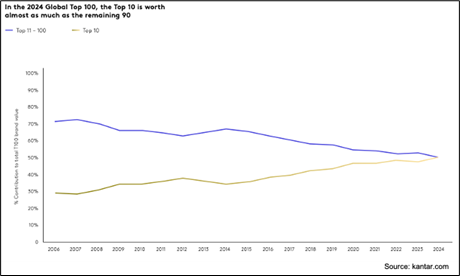
Financial Performance
Brands with strong reputations and solid market positioning often see better stock market performance than those with weaker brands. This is because strong brands provide investors with confidence in the company’s long-term ability to generate revenue and sustain profits. Investors see strong brands as more stable and resilient, especially in fluctuating markets. Brand value correlates with shareholder confidence, which drives higher stock prices.
Additionally, companies with high brand equity tend to be perceived as lower-risk investments, attracting institutional investors who prioritize stability and long-term growth. For example, companies like Apple, Amazon, and Coca-Cola consistently outperform market indices partly because their brands are seen as reliable and influential in driving customer engagement and financial performance.
Along these lines, over the past ten years, the BrandZ Top 100 Most Valuable Global Brands portfolio has grown by an impressive 285% compared to the S&P 500’s growth of approximately 100% over the same period. This means that the BrandZ Top 100 brands have outperformed the S&P 500 by about 185 percentage points.
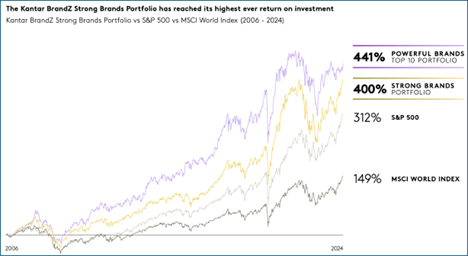
Higher Consumer Preference
One of the most direct contributions of brand value is its ability to drive higher consumer preference. Strong brands resonate with consumers on emotional, psychological, and functional levels, making them more likely to choose that brand over competitors. This preference is often built on a brand’s reputation for quality, consistency, trustworthiness, and emotional connection. Consumers who prefer a brand are more likely to engage in repeat purchases, recommend the brand to others, and become brand advocates (all forms of brand loyalty). This customer loyalty generates sustained revenue, and it elevates a brand’s value by ensuring a stable and predictable demand base.
The Top 100 brands generally score around 30% higher on the BrandZ “Meaningfully Different” metrics, which measure how well a brand meets consumer needs—both functional and emotional—uniquely compared to other brands. Over time, this elevated score translates into stronger consumer preference and loyalty for the brand.
Market Share Advantage
Higher consumer preference typically leads to increased market share. Strong brands secure significant market share advantages, often leading to a dominant position in the industry. Brand strength enables a company to capture a larger share of the market because consumers tend to trust and prefer established brands. This market share dominance can also create barriers to entry for new competitors, as they struggle to dislodge the incumbent brand from consumers’ minds.
As brands grow in prominence and market share, they also benefit from economies of scale, making it more cost-effective to produce and distribute products. Dominant market share often leads to a virtuous cycle of increased brand awareness, customer loyalty, and sustained profitability, which further enhances the brand’s value.
Specifically, brands in the BrandZ Top 100 claim, on average, a 5-10% larger market share within their respective categories compared to non-Top 100 brands.
Premium Pricing Power
A brand’s premium pricing power is its ability to command higher prices for its products or services compared to competitors, purely based on the strength of the brand. This is a direct result of consumer perceptions of superior quality, innovation, prestige, or trustworthiness associated with the brand. Strong brands, such as luxury goods like Rolex or premium technology brands like Apple, can charge significantly more than their competitors (at least in part) because customers are willing to pay for the perceived added value and prestige of the brand. Premium pricing enhances brand profitability and allows the company to maintain higher margins. It also enables brands to reinvest in innovation, marketing, and customer experience, further reinforcing their market position and long-term economic value.
Brands on the BrandZ Top 100 list command a price premium of up to 14% compared to brands outside this elite group. Importantly, this pricing power allows them to achieve higher profit margins and withstand competitive pressures better than their counterparts with weaker brands.
Resilience During Difficult Times
Later in this workshop, we will address the critical role of the corporate brand within the brand portfolio. We will see that strong brands can weather challenges such as recessionary times and marketplace crises better than average or weak brands. Specifically, brands with strong equity tend to be more resilient during economic downturns, market disruptions, or reputational crises. This resilience stems from the brand’s established trust with consumers, which acts as a buffer against sudden drops in demand.
Strong brands are also more likely to retain customer loyalty even when their competitors struggle or the broader economic environment weakens. For example, during recessions or periods of economic instability, consumers tend to gravitate toward brands they trust, even if those brands charge premium prices. Additionally, strong brands can recover more quickly from reputational damage or external shocks because they have built a reservoir of goodwill with consumers over time. This resilience contributes to sustained brand value and long-term profitability.
During the 2020 COVID-19 pandemic, the BrandZ Top 100 brands saw their value increase by an average of 6%, whereas the overall market experienced a decline in value by around 10-20%. This shows that Top 100 brands are between 16-26 percentage points more resilient than the broader market when confronted with difficult economic conditions.
Greater Differentiation and Innovation
Workshop #2 will introduce the topic of brand positioning, and as we’ll see, the single most important characteristic of a strong brand is for it to be differentiated. Brands that are seen as innovative and differentiated hold greater value because they are better positioned to capture consumer attention, create market disruption, and set industry trends.
Differentiation is crucial in creating a distinct market presence that competitors cannot easily replicate, making the brand indispensable to its target audience. For example, Tesla’s brand value is driven by its innovation in electric vehicles, which differentiates it from traditional automakers and positions it as a leader in the transition to sustainable energy
Similarly, innovation allows brands to stay ahead of competitors by continuously offering new solutions, experiences, and products that align with evolving customer needs. In this manner, continuous innovation reinforces a brand’s relevance, market leadership, and long-term growth potential.
When we examine the BrandZ data, we find the Top 100 brands typically score around 20-30% higher on differentiation metrics than the average brand. This reflects not only their ability to stake a meaningful and unique position in the marketplace, but also their continued investment in their new product development pipeline, technology, and customer experiences. All of this enables them to achieve and maintain a competitive advantage over time.
Brand Value Growth
Brand value growth reflects the increasing economic impact of a brand over time, driven by its ability to attract and retain customers, expand into new markets, and innovate. As companies invest in building and maintaining strong brands, they see increased revenue streams, higher profit margins, and enhanced competitive positioning. A brand’s value grows as it becomes more recognizable, trustworthy, and relevant to its target market. This growth trajectory is particularly important for companies operating in highly competitive industries, where maintaining a strong brand is crucial for differentiating from competitors. A consistent and strategic approach to brand management, customer engagement, and market expansion fuels brand value growth, which in turn contributes to higher overall corporate valuation.
On average, the BrandZ Top 100 brands have experienced annual brand value growth rates of 10-15%, compared to less than 5% for brands outside the Top 100 list. These numbers suggest that the Top 100 brands grow at more than 2-3 times the rate of non-Top 100 brands in terms of brand value.
Sustained Brand Equity
Closely related to brand value growth, sustained brand equity refers to the long-term value a brand provides to a company due to its consistent performance, customer relationships, and market presence. It reflects the brand’s ability to maintain positive perceptions, deliver on promises over time, and to stay relevant across different market cycles.
Sustained brand equity is a critical contributor to long-term profitability, as it ensures that a brand continues to generate value for the company over many years. It’s achieved through consistent investment in marketing, innovation, customer experience, and maintaining brand integrity. A brand with sustained equity enjoys many of the advantages detailed above (e.g., command premium pricing, secure customer loyalty), while preserving its core value proposition.
The BrandZ Top 100 brands consistently have brand equity scores that are 20-30% higher than those of non-Top 100 brands. This equity advantage is a critical driver of long-term growth for the brand and its company, and it ultimately contributes to other important business metrics such as greater profitability and shareholder value.

Higher Employee Engagement
Workshop #11 will tackle the important topic of employee engagement from both an internal and external perspective. Specifically, from an internal perspective, it will demonstrate how a strong brand contributes to positive esprit-de-corps and greater employee loyalty and retention. Externally, we will see how a strong “employer brand” helps a company more effectively recruit top talent, especially when faced with a challenging labor market.
Strong brands don’t just influence consumers and customers—they also significantly impact employee engagement. Employees at well-regarded companies with strong brands tend to exhibit higher levels of pride, commitment, and motivation. Employees are more likely to engage deeply with their work when they feel they are part of a respected, well-known brand. This increased engagement often leads to higher productivity, better customer service, and a stronger organizational culture. Employee engagement, in turn, contributes to the overall strength of the brand, as motivated employees help reinforce the brand’s values and promises in every consumer interaction, driving long-term success and growth.
Conversely, a positive brand image also translates into an attractive employer brand, making it easier for companies to attract and retain top talent. This is especially important in tight labor markets. As with employee engagement, the concept of employer brand will also be addressed during Workshop #11.
The Top 100 brands typically enjoy employee engagement scores that are about 10-15% higher than the industry average. High employee engagement correlates with better customer service and overall performance, further reinforcing the brand’s strength in the market.
THE CONCEPT OF BRAND VALUATION AND ITS APPLICATION
Brand valuation refers to the process of estimating the monetary value of a brand as an intangible asset. An intangible asset is one that does not have a physical presence but contributes to a company’s value. The value of a brand reflects the financial advantage it offers to a company through consumer loyalty, perceived quality, and market positioning. This involves determining the financial worth of the brand itself, separate from the company’s physical assets, products, or services.
Brand valuation has several useful applications in the business world, so before diving into how it’s calculated, it’s important to provide an overview of these applications.
Mergers and Acquisitions
Brand valuation plays a crucial role in M&A transactions. When one company acquires another, a significant portion of the purchase price may be attributed to the acquired brand. This was evident in the acquisition of Unilever’s Dollar Shave Club by Unilever for $1 billion, a deal in which Dollar Shave Club’s brand recognition and consumer loyalty were key assets.
Strategic Decision-Making
Brand valuation provides companies with insights that help inform marketing and business strategies. Knowing the value of a brand can guide investment decisions, such as increasing advertising or expanding into new markets, to enhance brand equity further.
Licensing and Franchising
Some companies license their brands to third parties, allowing them to use the brand name in exchange for royalty payments. Accurate brand valuation is essential to set appropriate licensing fees and ensure fair compensation for the brand’s use. For example, Disney licenses its brand to various manufacturers who produce merchandise using Disney’s intellectual property, generating substantial revenue streams.
Investor Relations and Financing
Investors often consider a company’s brand valuation when making investment decisions. Strong brands are seen as low-risk assets, and a high brand valuation can boost investor confidence. Additionally, companies may use their brand as collateral for securing loans or other financing options.
Performance Measurement
Some companies choose to regularly measure brand valuation to track brand health and performance over time. Monitoring fluctuations in brand value helps companies understand how effective their marketing and brand management efforts are and adjust strategies accordingly.
DRIVERS OF BRAND VALUATION
Several key factors help determine the economic value of a brand and are considered during the valuation process. They are as follow:
Brand Strength. This includes consumer perceptions of the brand, brand loyalty, market position, and brand awareness. Stronger brands typically command higher valuations because they attract more customers and sustain long-term financial performance.
Financial Performance. This is often measured by brand-related revenue and profit margins. Brands that generate higher revenues or exhibit higher margins relative to competitors are valued more highly.
Legal Protections. Brands that are well-protected by trademarks and other intellectual property laws tend to have higher valuations because they are less vulnerable to competition.
Growth Potential. Brands that have high potential for future growth, whether through geographic expansion, product line extensions, or untapped markets, tend to have higher valuations due to expected future cash flows.
METHODS FOR DETERMINING BRAND VALUATION
Several approaches are used to assess a brand’s economic value, each relying on different financial metrics and assumptions. Three common methodologies for brand valuation are as follows.
Income Approach (Relief from Royalty Method)
This approach estimates brand value based on the hypothetical cost savings a company realizes by owning the brand instead of licensing it. The method calculates the royalty payments a company would have to make to use a similar brand if it didn’t own the brand outright. The future cash flows from these avoided royalty payments are then discounted to present value. This is a widely accepted method because it focuses on real-world financial implications.
Market Approach (Comparative Method)
The market approach estimates brand value by comparing it to similar brands in the market that have been sold, licensed, or publicly valued. This method is similar to real estate valuation, where the price of comparable properties (i.e., “comps”) is used to estimate value. However, because brand transactions are less frequent than property transactions, this approach is less commonly used.
Cost Approach
The cost approach determines brand value based on the cost it would take to recreate or replace the brand. This includes the costs of marketing, advertising, legal fees, and other expenses incurred in building the brand from scratch. While this method can provide a basic understanding, it often fails to capture the true economic potential of a brand because it focuses on past expenditures rather than future earnings.
POPULAR BRAND VALUATION SURVEYS/MODELS
Although there are many brand valuation models in the market today, there are two that are commonly used and referred to in the world of branding. These will be frequently referenced throughout the Brand Leadership program.
Interbrand Best Global Brands
Interbrand is one of the most recognized brand valuation consultancies globally. Its valuation model is based on a combination of financial performance, the role of the brand in purchasing decisions, and brand strength. The “Interbrand Best Global Brands” report is published annually, listing the world’s most valuable brands.
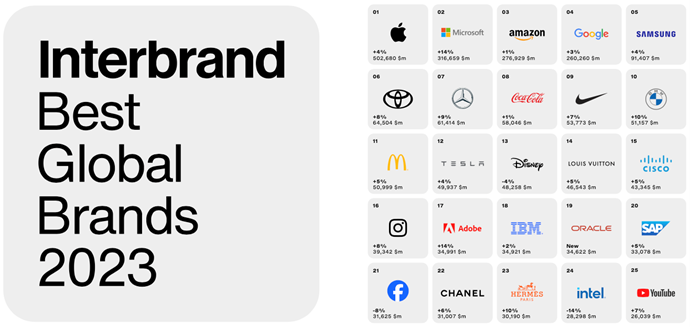
BrandZ (Kantar) Most Valuable Global Brands
BrandZ uses a valuation methodology that incorporates both financial data and brand perception surveys. This approach aims to understand how consumers view the brand and how it contributes to the company’s bottom line. Their annual rankings provide insights into the economic value of the world’s top brands.
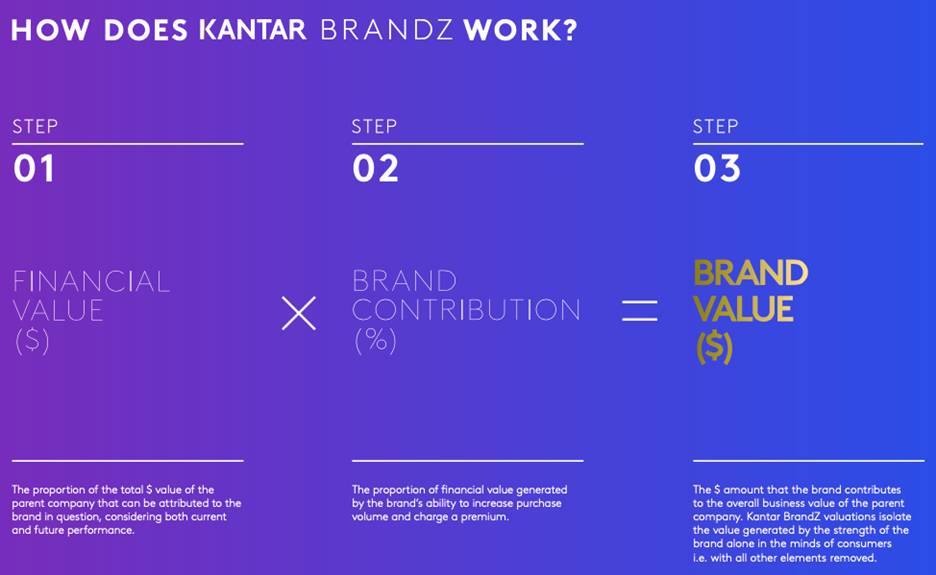

CASE STUDY: THE ROLE OF BRAND VALUATION IN M&A
In 2015, Kraft Foods Group and H.J. Heinz Company merged to form The Kraft Heinz Company, creating one of the largest food and beverage companies in the world. This deal was facilitated by the involvement of Berkshire Hathaway and 3G Capital, two powerful investment firms. The role of brand valuation in this M&A was significant, as the two companies owned some of the most iconic food brands globally, which became central to the transaction’s structure and value.

The Role of Brand Valuation
1. Valuing Iconic Brands: Kraft and Heinz each owned highly recognizable and trusted brands, such as Kraft, Heinz, Oscar Mayer, Philadelphia, and others. The valuation of these brands was a major component of the overall deal. Both companies had built strong brand equity over decades, which included customer loyalty, brand recognition, and premium pricing power. The valuation of these brands was factored into the overall worth of the two companies, influencing negotiations and the terms of the merger.
2. Strategic Importance: In this case, the strength of the brands helped justify the merger’s financial rationale. Heinz, under 3G Capital’s management, had been optimized for profitability through cost-cutting and operational efficiencies, but it was also betting on the value of its brand equity to fuel future growth. Kraft, on the other hand, had struggled with growth and profitability but still maintained strong brand recognition in the consumer goods market. The merger leveraged Kraft’s and Heinz’s complementary brands and aimed to use the strength of those brands to drive synergies and growth in new markets, including international expansion and innovation in product lines.
3. Premium Pricing Justification: The high valuation of the brands helped justify the premium paid for the transaction. In many M&A deals, especially in consumer goods, companies are often willing to pay a premium for strong brands because they represent stable, predictable cash flows. In this case, the Kraft and Heinz brands were considered underleveraged assets that could be revitalized under new management, providing strong growth potential after the merger.
4. Post-Merger Strategy: After the merger, brand valuation continued to play a role in guiding strategic decisions. The combined company focused on strengthening and modernizing its brands through product innovation, marketing, and distribution strategies. Brand valuation helped determine which brands would receive investment and attention, and how the company could maximize the return on its brand assets.
Financial Impact
The merger was valued at approximately $46 billion, with brand equity playing a significant part in the overall valuation. The brands were central to the value creation strategy proposed by the merger. Heinz’s and Kraft’s brand portfolios were not only leveraged to cut costs but were also viewed as assets that would drive future revenue and market expansion.

Course Manual 4: Brand Ecosystem
As with any business function, effective brand management is equal parts strategy and execution. When combined, we have what can be referred to as the “Brand Ecosystem”—and it essentially represents the sum-total of the 12 workshops that comprise the Brand Leadership program. Below is a simple framework that illustrates the ecosystem, along with brief overviews of both the strategy and execution components.
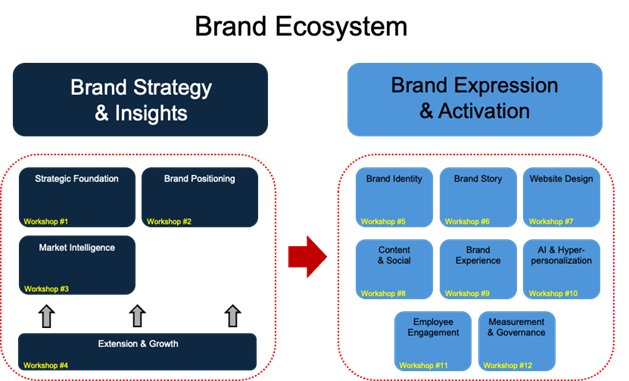
1. BRAND STRATEGY & INSIGHTS
Strategic Foundation (this workshop) — There are several foundational concepts that need to be defined relative to brand. For starters, it’s important to understand that brands are intangible assets with real economic value. They exist at different levels (or “hierarchies”) within the organization, and there are different types of brands—including corporate and product—which serve different strategic roles within the portfolio. Brand architecture helps to define the relationships brands within a portfolio should have with one another (accounting for both hierarchy and type), based on a combination of market dynamics and strategic intent. Finally, it is critical to understand the inextricable link that needs to exist between brands and the business strategy they’re intended to support.
Brand Positioning — Brand positioning is often considered the strategic “North Star” for a brand, since it serves as the starting point for all brand activation that is to follow. In short, positioning articulates the unique value proposition (UVP) for the brand, and why a customer or consumer should purchase the brand’s product or service offerings. Importantly, it also should articulate what differentiates it from competitive alternatives. There are four bases for differentiation: “what” the brand does, “how” the brand does what it does, “why” the brand does what it does, and “who” the brand is (i.e., its personality). An effective brand positioning is one that is relevant, compelling, unique, and credible. It typically includes a target audience, frame of reference, primary benefit, supporting proof points, point of difference, and personality.
Extension & Growth — Achieving brand growth often requires skillfully extending brand assets both horizontally (into new segments and markets) and vertically (across different price/value tiers). However, brand extension is a delicate balance. The key to successful extension is to find the “sweet spot” between market and brand—i.e., the intersection of unmet customer needs and brand relevance. Successful extension also requires looking beyond tangible features and attributes to leverage the intrinsic and intangible associations of the brand. A Brand Credibility Footprint is a framework that establishes boundaries for how a brand can (and cannot) extend opportunistically and safely in the marketplace.
Market Intelligence — Gaining sufficient market intelligence typically requires using both secondary and primary research, and both qualitative and quantitative methodologies. Secondary research is existing data and insights that has been collected by others. Examples include government statistics, university studies, trade publications, syndicated data, market research reports, and websites. Conversely, primary research is commissioned by a company for its own use, tailored to its specific learning objectives. Examples include in-depth interviews, quantitative surveys, focus groups, observation, ethnography, and social listening. The insights and intelligence gained from all these sources should inform virtually every component of brand strategy and activation, including positioning, architecture, communication and messaging, extension and growth strategy, experience, and more.
2. BRAND EXPRESSION & ACTIVATION
Brand Identity — A brand’s visual identity consists of all visual components of the brand, including logo, wordmark, color palette, typography, imagery, iconography, and more. Verbal identity is the way a brand communicates through words to create a distinctive personality. It does this through language, voice, tone, naming, and messaging. While creativity is obviously important in the brand identity development process, it’s equally important to remain “on brand” by ensuring the visual and verbal identity systems are consistent with brand positioning (i.e., strategy).
Brand Story — Human beings are inherently “hardwired” to respond to stories, especially ones with emotional impact. Simply put, a brand story is a brief narrative that helps bring the brand positioning to life in a very approachable and entertaining way. It does this by building a powerful emotional connection between the brand and its target audience.
Website Design — Websites—like any other form of brand activation—should be guided by brand positioning strategy. For starters, the brand’s visual and verbal identity need to be reflected in the website’s design. Similarly, the site’s user experience (UX) and user interface (UI)—which includes structure, navigation, and layout—needs to feel consistent with the brand’s “offline” experience. Elements of the brand’s story should be woven throughout site, especially in the About Us section and in customer testimonials and case studies. To ensure search engine optimization (SEO), the site should feature keywords that align with the brand’s positioning and incorporate words the target audience is likely to use. Finally, meta descriptions and titles should reflect the brand’s unique value proposition (UVP).
Content & Social — Content marketing is essential for any brand seeking to establish market dominance. It is defined as the creation and sharing of online material (e.g., articles, blogs, videos, and social media posts) that does not explicitly promote a brand. Rather, it is intended to gradually generate interest in the company’s products or services over time. Social media plays an important role in delivering a brand’s content. Here, the market is seeing the emergence of content creators, along with the increasing popularity of micro-influencers and virtual influencers. Collectively, these trends have resulted in a shift in editorial control from brands to customers and other stakeholders, which marketers need to acknowledge and accommodate.
Brand Experience — Brand experience is the sum-total of all touchpoints and interactions a brand has with its target audience, whether it’s before, during, or after purchase. This includes a brand’s website, collateral, customer service, and more. As with any form of brand activation, experience should be consistent with—and inspired by—brand positioning. “Signature touch points” are interactions that are so powerful and uniquely identifiable that they define the brand in customers’ minds and distinguish it from competitors’ brands (e.g., Apple’s Genius Bar, Tiffany’s blue box).
AI & Hyper-personalization — AI provides brands the ability to quickly and easily micro-segment audiences and hyper-personalize marketing activation at levels that were previously thought unimaginable. This includes product/service offerings, email communication, website experience, and even dynamic pricing. In fact, some believe we are gradually approaching a level of personalization that Don Peppers & Martha Rodgers forecasted in their 1994 bestselling book, The One-to-One Future.
Employee Engagement — Employees represent a critical stakeholder group for brand management. Specifically, they are an important link between a brand and its customers, especially in the B2B arena. It’s useful to consider employee engagement from two perspectives: internal and external. Internally, the goal is to ensure employees understand and embrace brand positioning and the role they play in delivering it. Externally, the emphasis shifts to establishing the company as an “employer of choice” through effective employer branding.
Measurement & Governance — There are three different categories of brand measurement: diagnostic, prescriptive and predictive. Additionally, there are three different types of brand metrics that are critical to track and manage over time: perception, behavior, and performance. Collectively, they represent a brand metrics dashboard that helps you track your brand’s progress toward its business- and brand-related goals, and that offers direction for course correction when necessary.

CASE STUDY — DEMONSTRATING THE BRAND ECOSYSTEM
The concept of Brand Ecosystem is perhaps best illustrated through a case study of a well-known brand that demonstrates how the various components of world-class strategy and execution came together to result in brand leadership.

Background
In 2008, Airbnb dramatically transformed the travel industry by developing a unique solution for the lodging sector—the concept of home-sharing. Today, Airbnb is a $10 billion global leader in the online travel information and booking services industry, with listings in over 220 countries (in more than 100,000 cities) worldwide.
However, in addition to its innovative business model, its strategic approach to brand-building is widely credited for much of the company’s initial and continued success. According to global consultancy Interbrand, despite being merely a 15-year-old brand, Airbnb has become the 46th most valuable brand in the world, with an estimated economic value of over $16 billion. Additionally, Airbnb was cited as Interbrand’s fastest-growing brand of 2023, with a 22% increase in brand value versus prior year.
What makes Airbnb’s success story so interesting is the strategic and methodical approach it took to building its now-iconic brand. Everything from the identification of a core consumer insight that inspired the brand… to its award-winning visual and verbal identity… to its meticulous marketing and brand activation serves as best practice for strategic and disciplined brand-building. It underscores the premise that great brands don’t “happen by chance.” Rather, they are the result of thoughtful and diligent planning and process. Virtually every component of the Brand Ecosystem (and the overall Brand Leadership program) is demonstrated in the real-world Airbnb case study highlighted below.
“Voice of Customer” & Core Insight
In developing its novel concept, Airbnb conducted extensive market research with modern travelers to understand their core desires and pain points. Specifically, the company conducted numerous focus groups, participated in observational and ethnographic research, and fielded quantitative surveys. It also analyzed competitors like hotels and other forms of home-sharing platforms.
Through this process, Airbnb discovered a significant unmet need for authentic travel experiences and a sense of belonging. Consumers were increasingly seeking personalized and immersive travel experiences. Importantly, this need spread across multiple key demographics and usage occasions, including millennials, business travelers, and families looking for affordable, unique travel accommodations.
Simply put, the core insight (and inspiration for the eventual Airbnb brand) could be summarized as follows: Travelers were seeking more than just a place to stay; they wanted to “live like a local.” They were expressing a strong desire for a sense of authenticity, community, and belonging.
Brand Positioning
Based on their research findings, Airbnb crafted a compelling brand positioning statement, and an accompanying tagline: “Belong Anywhere.” This statement encapsulated their promise of providing unique, local experiences and fostering a sense of community.
The brand positioning checked all the boxes for an outstanding strategy. It was single-minded—focused on the theme of “belonging”—which was identified through research to resonate emotionally with customers. It emphasized that travelers could essentially “wake up at home anywhere in the world” with Airbnb.
Additionally, it was a differentiated brand promise, which is also an essential ingredient for effective brand positioning. It established Airbnb as a unique alternative to traditional accommodations, and it highlighted the personalized and diverse experiences offered by their hosts.
Finally, it was seen as a credible promise, which is a prerequisite for any brand positioning to be successful. The positioning offered customer testimonials and host stories to build trust and authenticity. It showcased the real-life experiences of guests to validate the brand’s promise.
Creative Expression (Visual & Verbal Identity)
Airbnb then translated its brand positioning into an elegant and cohesive creative expression across all touchpoints, beginning with its visual identity and messaging. Its logo, the Bélo, brilliantly symbolized the sense of “belonging” that is central to the brand positioning. Additionally, it used warm, inviting colors and imagery to evoke a sense of home and community.
From a verbal perspective, the brand crafted—and consistently delivered—a narrative around the theme of belonging. For example, one of its initial campaigns was “Don’t Go There, Live There,” which emphasize the “immersive experiences” component that is central to its brand positioning.
Brand Activation & Experience
Airbnb’s brand activation brought its positioning to life through various channels. For starters, the brand executed global campaigns across digital, print, and television media. Experientially, it hosted events and pop-up experiences in key cities to engage with its community. Airbnb also partnered with local artists and cultural events to deepen the brand’s connection with local communities.
Not surprisingly, the brand was also very aggressive on the digital activation front. For example, its website and app are considered among the best in terms of providing a seamless, user-friendly experience. The website also does a great job of integrating storytelling elements to reinforce the brand promise.

Additionally, Airbnb leveraged social media platforms to share user-generated content (UGC), and content from influencers and creators. It also encouraged guests and hosts to share their personal Airbnb stories online, which further amplified brand reach.
Brand Personalization through Artificial Intelligence
More recently, Airbnb has begun leveraging emerging technologies such as artificial intelligence (AI) to hyper-personalize its offer and deliver a more immersive brand experience.
For guests, the company uses machine learning models to optimize search and discovery. This AI-powered search helps match guests with the most relevant listings, experiences, and services based on their preferences. The goal is to provide users with personalized results that enhance their booking experience by finding the perfect accommodation or activity tailored to their needs. Additionally, Natural Language Processing (NLP) is used to analyze guest reviews. This technology helps surface the most relevant reviews for listings, focusing on comments that provide valuable insights about the property rather than general remarks about the location. By doing so, Airbnb enhances the quality of information available to future guests.
For hosts, AI plays a crucial role in Airbnb’s Smart Pricing tool, which helps hosts optimize their pricing strategies. The tool predicts the likelihood of a listing being booked at a given price on a specific date, allowing hosts to adjust prices dynamically to maximize occupancy or revenue—whichever their goal may be.
IMAGE TOO BLURRY
Employer Branding
Airbnb has built a robust employer brand that aligns with its overall mission of creating a world where anyone can belong anywhere. The company emphasizes that its employees are part of this larger mission to foster global connections and hospitality. This mission-driven approach attracts candidates who are passionate about making a difference and contributing to a meaningful cause.
Airbnb’s headquarters and offices are designed to reflect the company’s ethos of belonging and community. The spaces are structured to resemble different Airbnb homes from around the world, creating a familiar and inviting environment for employees. This design encourages collaboration and a sense of home, moving away from traditional office layouts.
Airbnb also leverages storytelling to boost its employer brand. The company shares real stories and testimonials from employees across its digital channels. These narratives highlight the unique experiences and journeys of Airbnb employees, showcasing the company’s culture and values in a memorable way.
Finally, consistent with its “belonging anywhere” brand positioning, Airbnb has made concerted efforts to increase diversity within its workforce. They set specific goals to grow the representation of underrepresented minorities and women, particularly in leadership roles. Programs like Blocking Bias and Allyship support these efforts. The company also invests in the professional development of its employees through a variety of learning programs focused on inclusive leadership and skill-building.
Airbnb’s employer branding efforts clearly have paid off in terms of employee satisfaction and external recognition. The company has been consistently listed among the best places to work, thanks to its unique workplace culture and strong commitment to its employees’ well-being.
Brand Measurement & Tracking
Airbnb tracks a range of brand metrics to assess and optimize its performance across various aspects of its business. Key brand metrics that Airbnb continuously monitors include:
• User Engagement Metrics. Airbnb tracks user engagement on social media platforms, including likes, shares, comments, and mentions. These metrics help gauge how well their content resonates with audiences and the level of interaction it generates. For instance, during the “We Accept” campaign, Airbnb monitored engagement metrics to measure the campaign’s impact on user interaction and conversation
• Sentiment Analysis. Sentiment analysis is crucial for understanding public perception of the brand. Airbnb uses sentiment scores derived from user feedback and social media mentions to measure positive or negative sentiments. An increase in positive sentiment indicates improved brand perception and customer satisfaction
• Brand Awareness and Recall. Airbnb measures brand awareness and recall to ensure its marketing efforts are effectively increasing visibility. This includes tracking the percentage of people who recognize and recall the Airbnb brand after exposure to advertisements or campaigns
• Campaign Effectiveness. Airbnb continuously monitors and evaluates the effectiveness of its marketing campaigns. This includes tracking metrics such as reach, impressions, click-through rates, and conversion rates. By analyzing these metrics, Airbnb can optimize its marketing strategies and ensure a high return on investment (ROI)
• Customer Lifetime Value (CLTV). CLTV estimates the total revenue expected from a customer over the entire duration of their relationship with Airbnb. This metric helps Airbnb understand the long-term value of their customers and tailor their marketing and retention strategies accordingly
By meticulously tracking these metrics, Airbnb makes informed decisions, optimizes its strategies, and continues to enhance both the host and guest experiences on its platform. Collectively, this ensures the long-term viability of both the business and the brand.
EXERCISE 1.3: BRAND ECOSYSTEM

1) Brand Positioning
• Does your brand have a formally defined positioning that is documented and well-understood internally?
2) Extension & Growth
• Is there a strategy in place for how your brand can logically and safely extend, in terms of both new categories/segments and price points?
3) Brand Identity
• Is the visual identity system that represents your brand clear, logical and easy to understand?
4) Brand Story
• Does your brand have a story or narrative that helps bring it to life for both internal and external stakeholders?
5) Website Design
• To what extent does your website reflect the positioning and visual identity of your brand?
6) Content & Social
• Do your content marketing and social media efforts reflect your brand positioning and brand personality?
7) Brand Experience
• Can you identify the critical touchpoints that define the brand experience, and are they executed in a manner consistent with the brand positioning?
8) AI & Hyper-personalization
• Are you currently taking advantage of artificial intelligence (AI) and other emerging technologies to personalize the brand offer and experience?
9) Employee Engagement
• How well do employees in your company—beyond just the Marketing function—understand the positioning of your brand?
10) Measurement & Governance
• Do you have a brand metrics system in place to measure and track the performance of your brand relative to stated objectives?

Course Manual 5: Brand Hierarchy & Types
The goal of this course module is to introduce two important concepts that pertain to brand architecture (a topic that will be more formally defined in a separate course module later in this workshop). The two concepts are brand hierarchy and brand types.
BRAND HIERARCHY
Brand hierarchy refers to the levels within the organization at which branding occurs. These levels vary greatly based on the nature of the business and the company’s business strategy. However generally speaking, branding can occur at the following levels within a business.
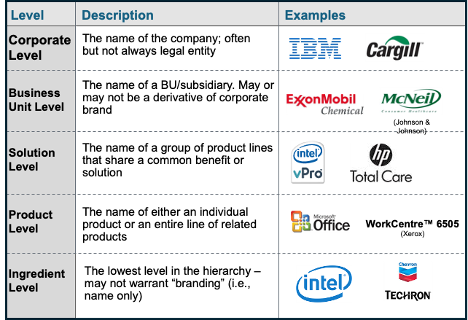
Corporate
As the name implies, a corporate brand is the brand that represents the parent company. It is essentially the company’s identity or image, and how it’s presented to customers, consumers, employees, investors, and other stakeholders.
In some cases—especially for a branded house portfolio, in which a single master brand is the “reason to believe” for virtually all product or service offerings—the brand is critical and invaluable. Examples include Apple, GE, and IBM. While these companies have other brands in their portfolio (e.g., iPhone for Apple, Watson for IBM), the corporate brand enjoys a high ranking on the Interbrand and Kantar BrandZ lists of the world’s most valuable brands. At the other end of the spectrum is a holding company, for which the corporate brand is little more than a name or legal entity that has little to no familiarity—much less meaning and equity—in the marketplace.
Holding companies notwithstanding, the corporate brand is a “special case” brand for most portfolios, and it warrants further exploration. In fact, it is so important we will revisit its unique portfolio role in a later module during this workshop. For now, suffice it to say that even for companies whose brand portfolio is a House of Brands—where numerous product brands exist and operate independently from one another (e.g., Unilever)—the corporate brand is an important and valuable strategic asset.
Business Unit/Division
One level below corporate brand is business unit (BU) or divisional brands. These are specific brands or business units within a larger corporation that operate semi-independently and often have their own distinct brand identity, target market, and product or service offerings. These divisions may focus on different sectors, customer needs, or product categories, while still aligning with the overall corporate strategy.
Examples of BU/division brands include Janssen Pharmaceuticals (a division of J&J focused on developing and manufacturing prescription drugs), Hino Motors (a division of Toyota focused on commercial vehicles and trucks), and Active Cosmetics (a division of L’Oréal focused on “dermocosmetic” brands like Vichy and La Roche-Posa).
Less interesting examples are when the division brand is a descriptive brand of the corporate brand (a concept that will be explained later in this course module)—such as Unilever Home Care Division and Nestle Nutrition. In these cases, the BU/division is little more than a category identifier for the corporate master brand. Other “less interesting” examples include BU/division brands that double as well-establish product brands, such as PepsiCo’s Quaker Foods, which is a division that includes Quaker Oats, cereals, and other food products.
Solution
Solution brands are positioned around a comprehensive set of solutions that address a typically broad set of customer needs or problems. Here, branding is focused on the comprehensive offering rather than the individual products or services that merely represent “point solutions.” Solution brands are intended to emphasize a holistic approach to problem-solving, integrating various products, services, and/or technologies into a single, unified offering.
For example, Microsoft Azure is a cloud solution brand offering a comprehensive suite of cloud services. These services include computing, analytics, storage, and networking. The Azure brand encompasses a wide range of product and service offerings, and it is positioned as a comprehensive solution to meet various enterprise needs, such as building, testing, and managing data center applications and services.
Another example of a solution brand is Schneider Electric’s EcoStruxure platform. EcoStruxure is an IoT-enabled solution that offers integrated energy management and automation solutions for buildings, industries, and data centers. It combines hardware, software, analytics, and services to optimize energy use and reduce costs, all while ensuring operational reliability. Schneider gains significant efficiencies and synergy in branding multiple product (point) benefits under a single solution brand, as opposed to the more narrowly defined individual product solutions that comprise the bundle.
Product
Continuing down the hierarchy we next have product brands. As the name implies, these are brands that apply to either a single product or entire line of products. For example, Dove is a product brand of Unilever, Xbox is a product brand of Microsoft, and Crest is a product brand of Procter & Gamble. Like corporate brand, the topic of product brand will be covered in far more detail later in this workshop.
Ingredient
Ingredient branding is a strategy that involves creating a separate brand identity for products that serve as components (or ingredients) for other products and brands. They are typically positioned around a specific benefit that provides a critical “reason to believe” for the brands they’re intended to complement.
Ingredient brands can either be applied internally (i.e., to other brands within the same company’s brand portfolio), or they can be used externally (i.e., applied to a brand outside the ingredient brand’s company). One of the most famous examples of the latter is Intel. Intel is considered an “ingredient brand” because it focuses on marketing itself as a critical, high-value component embedded within other companies’ products— specifically personal computers and various digital devices—rather than as a standalone product sold directly to end consumers.
However, ingredient brands can also be effectively leveraged within a company’s own brand portfolio. For example, Hemi is an ingredient brand of high-performance engines that go into multiple Chrysler automobiles and trucks, bolstering the overall perception of those vehicles. Techron is a fuel additive that is designed to maximize fuel economy, and it serves as an important ingredient brand for Chevron fuels. In both these cases, the ingredient brands (Hemi and Techron) serve as “ingredients” for brands within its parent companies’ brand portfolio (i.e., Chrysler and Chevron, respectively).
BRAND TYPES
Like hierarchy, brand types are central to the concept of brand architecture. Here, we will cover five brand types, and we’ll provide illustrative examples of how they’re typically leveraged in companies’ brand portfolios.
Master Brands
The main, overarching brand that represents an offering or entity is referred to as a master brand. Sometimes that offering is the entire company, in which case it can also be referred to as a corporate master brand. For example, “Virgin” is the master (and corporate) brand that spans across Virgin Atlantic, Virgin Mobile, and Virgin Money. However, there are other times a master brand is not a corporate brand. Consider the case of Crest, which is not the corporate brand for the company… that’s P&G. Even still, it serves as a master brand within its own product category because it encompasses a range of related products under a single, cohesive brand identity.
Master brands are powerful because they allow companies to leverage brand equity across multiple products, creating an economy of scale in marketing and branding. However, this strategy also carries risk. Any negative association with one product could potentially tarnish the reputation of the entire brand. For example, when Apple faced issues with product defects or controversies around working conditions at its suppliers, the brand as a whole had to manage the fallout, not just a single product line.
Endorsed Brands
An endorsed brand maintains its own identity and name, but it is endorsed by the parent brand, providing a seal of trust or quality. The endorsed brand benefits from the credibility of being associated with (or “blessed” by) the parent brand. This approach is often used to establish credibility for a new product or service offering, or following an acquisition to alert the market to a new ownership structure or relationship. Marriott International endorses some of its hotel brands like Courtyard by Marriott and Residence Inn by Marriott.
As we’ll see in the upcoming course module on brand architecture, endorsement can be either a short- or long-term strategy. Sometimes, especially after a merger or acquisition, endorsement is an interim step to either signal a new ownership structure and/or provide confidence and trust. Once the relationship has been established, it may no longer be required through brand architecture. However, other times the endorsement is longer-term, or even permanent. Business strategy and market dynamics should dictate the length of the explicit relationship.
Co-Brands
A co-brand is formed through a partnership between two or more brands, combining their respective strengths to create a joint product or service that benefits relatively equally from both brand identities. Co-branding can enable brands to extend their reach into new markets or deepen their presence in existing ones by combining forces.
Successful co-branding requires synergy between the two brands, ensuring that both stand to gain and that their values align. This is because there is risk to co-branding… it can potentially result in brand dilution (for one or both brands) if the partnership does not feel authentic or results in poorly executed activation. In other words, co-branding should only occur when it’s believed that the “whole is greater than the sum of its parts.”
Co-brands can either be from the same brand portfolio (i.e., owned by the same company), or it can represent a partnership between two different companies. An example of co-branding between two separate companies is Nike+. This is a collaboration between Nike and Apple, and it covers a range of running shoes and accessories. Similarly, Delta SkyMiles is the co-branded credit card offering that brings together the collective strengths of Delta Airlines and American Express.
There are also times when co-brands are established between two brands within the same company’s portfolio. For example, Taco Bell and Doritos are both owned by Yum! Brands, and they came together to create one of the most popular fast-food innovations: the Doritos Locos Tacos. This product incorporates Taco Bell’s classic taco fillings with a shell made from Doritos chips, blending the distinct flavors of both brands. The benefits of the co-brand include delivering a unique product experience by combining two beloved flavors, creating buzz and excitement in the market, helping to drive foot traffic to Taco Bell locations, and encouraging cross-promotion between the brands, boosting sales for both.
Another example is Nike and Converse. Although Nike and Converse are traditionally viewed as separate brands within the Nike portfolio, they have co-branded on products that blend their unique brand identities. One example is Nike x Converse Chuck Taylor All-Star shoes that incorporate Nike’s technology and Converse’s classic style. These shoes often feature Nike’s innovative Flyknit material and cushioning technologies while maintaining the iconic Chuck Taylor design. This co-brand appeals to a broad audience by merging lifestyle fashion with performance enhancements, and by strengthening brand cohesion and synergy across Nike’s brand portfolio.
Sub-Brands
A sub-brand is a brand that operates under the main (i.e., master) brand but has its own distinct name, identity, and characteristics. Sub-brands offer a way to target niche markets or product categories while maintaining a connection to a parent brand’s reputation. They allow for differentiation and specialization while benefiting from the established credibility and marketing power of the parent brand.
There are many reasons a company may pursue a co-branding strategy. It may be seeking to appeal to different customer segments with a single brand, but without diluting the core brand’s identity. Conversely, it may be looking to effectively manage price differentiation across its product lines—by creating sub-brands, companies can target premium, mid-tier, and budget-conscious consumers without confusing their brand’s value proposition.
Sub-branding can also be a strategic approach for addressing cultural or geographic variations in consumer preferences. When entering new markets, the company may use sub-brands to tailor its products to local tastes, values, or regulations. This allows the parent company to remain globally recognized while catering to specific regional needs.
Regardless of the strategic intent, sub-brands typically carry elements of the master brand’s positioning and identity while targeting different segments or offering different products. For example, “iPhone,” “MacBook,” “iPad,” and “Apple Watch” are sub-brands under the Apple master brand. Additionally, Amazon Prime is a sub-brand of the Amazon master brand, offering a subscription service that includes expedited and discounted shipping, content streaming, and other services and benefits.

Descriptive Brands
As the name implies, descriptive brands apply the master brand to a product category offering, essentially defining the offering in functional terms. In this case, virtually all equity resides with the master brand; the other portion of the name merely identifies a category. Descriptive brands are beneficial when a company wants to emphasize what it does without relying on a more abstract or creative brand name. Examples of descriptive brands include GE Aviation, NBC Sports, and Deloitte Consulting. In each of these examples, equity resides with the master brand—GE, NBC and Deloitte—while the other entity merely classifies (or “describes”) the offer being made.
 Below is an illustration of the five brand “types” depicting the relative emphasis of the master brand versus the “other” entity. In general, as you move from left to right, the master brand gradually moves from more to less dominant.
Below is an illustration of the five brand “types” depicting the relative emphasis of the master brand versus the “other” entity. In general, as you move from left to right, the master brand gradually moves from more to less dominant.

As referenced above, these brand architecture options and approaches are pursued with a specific strategic intent in mind. That is what makes brand architecture a strategic, not creative, discipline—even though its efforts typically manifest through a brand’s visual identity system and expression. Once again, more on the topic of brand architecture will follow shortly in an upcoming course module.

CASE STUDY: CO-BRANDING…A MATCH MADE IN HEAVEN
The partnership between GoPro and Red Bull is a great example of a successful co-brand initiative. This collaboration demonstrates the market potential of two brands coming together to leverage their relative strengths and brand equities, and to amplify their respective reach and impact.
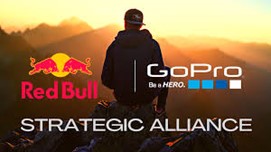
The Brands
GoPro is a leader in action cameras, known for its compact and durable devices that capture high-quality action footage. It has become the “go-to” brand for adventurers, athletes, and thrill-seekers looking to document their exciting life experiences.
Red Bull, on the other hand, is a global leader in the energy drink market, with a brand deeply rooted in extreme sports and high-octane events. Red Bull has long associated itself with action sports, adventure, and pushing the limits of human potential.
The Collaboration
The partnership between GoPro and Red Bull—which began in 2016 and continues today as a multi-year global partnership—was a strategic alignment between two brands with similar target audiences and complementary brand identities. This, of course, is a requirement for any successful co-brand initiative. GoPro and Red Bull struck a global partnership that allowed them to share rights to content production, distribution, and promotion. Both brands benefit from the collaboration. Red Bull gains access to GoPro’s innovative camera technology, while GoPro leverages Red Bull’s strong brand image, vast reach in the extreme sports community, and its expertise in event management.
Importantly, the collaboration is much more than just branding. It has included joint sponsorship of more than 1,800 events across more than 100 countries. One example of a high-profile event was the Red Bull Stratos project, where skydiver Felix Baumgartner jumped from a helium balloon in the stratosphere to break the sound barrier. The event was captured using GoPro cameras, providing a breathtaking perspective that could only be achieved with GoPro’s advanced technology.

Why the Co-brand Works
The co-branding effort between GoPro and Red Bull has been successful for several reasons. First, it plays into each brand’s attributes and strengths, which are entirely complementary. Red Bull’s brand positioning is all about energy, adventure, and high-performance. It has deep, long-standing associations with extreme sports and high-energy events. Similarly, GoPro is positioned as the “explorer brand for thrill seekers,” and the maker of the world’s most versatile camera. This alignment allows both brands to deliver unique (and highly complementary) experiences to their shared audience.
However, beyond brand positioning, the companies have shared values and vision. Both companies seek adventure, excitement, and opportunities for human achievement. This alignment of values creates a natural and credible partnership that feels authentic to their respective consumer bases, and undoubtedly contributes to its successful co-branding effort.
The partnership also allows for significant cross-promotion. Red Bull events have become platforms for showcasing GoPro’s cameras, while GoPro users capture and share Red Bull’s exhilarating and extreme activities. In this sense, the cross-promotion serves to expand the audience base for both brands, and it creates a synergistic relationship that amplifies each brand’s presence and reputation.
Additionally, the co-branding effort skillfully incorporates dynamic and fresh content marketing. Both GoPro and Red Bull believe strongly in the power of relevant and compelling content. They use their partnership to co-create engaging videos, social media content, and documentaries. Their collaborative content is authentic and dynamic. It resonates well with their respective audiences, and the co-brand relationship drives engagement and customer loyalty for both brands.
Results
The co-branding effort continues to result in increased visibility for both brands. GoPro has gained credibility and extended its reach into new markets, while Red Bull has strengthened its content creation capabilities and further entrenched itself in the world of extreme sports. The collaboration provides both brands with new ways to engage with their audience, resulting in higher brand awareness, customer loyalty, and ultimately, revenue growth. The partnership is a textbook example of how co-branding can be used effectively as a brand architecture strategy to the mutual benefit of two independent brands.

EXERCISE 1.4: BRAND HIERARCHY & TYPES
• At what “levels” in your organization are you currently branding (e.g. corporate, BU, division, solution, product)? Importantly, we’re not referring to merely a product name, but rather a true brand.
• What “types” of brands are currently in play today within your brand portfolio?
o Master brands?
o Endorsed brands?
o Co-brands?
o Sub-brands?
o Descriptive brands?

Course Manual 6: Corporate Brand
Effective branding is about creating lasting, recognizable impressions that foster loyalty, trust, and engagement. However, while branding is often discussed as a unified concept, as illustrated in previous course modules, it is important to understand that there are different types of branding, each serving distinct purposes. Two of the most fundamental types are corporate branding and product branding.
The distinction between a corporate and product brand can, at times, become blurred. Some of the most powerful corporate brands—like Hershey’s, Coca-Cola, and Hyatt—also serve as product brands. And when it comes to corporate brand versus product brand strategy, there are more similarities than there are differences. The basic principles and best practices apply regardless of whether the brand is corporate or product. Strategic frameworks, such as those for brand positioning and brand experience, are also equally relevant for each brand type.
Even so, the corporate brand undoubtedly has several unique and important roles within the portfolio that simply do not apply to product brands. As such, the corporate brand is often one of the most important strategic assets for an organization. The remainder of this module will address and illustrate the critical role of the corporate brand.
THE RISING IMPORTANCE OF THE CORPORATE BRAND
The importance of the corporate brand has become increasingly evident in the world of advertising. According to Kantar Media, corporate brand advertising rose 17 percent in 2022 when compared with the previous year, even though total ad spending rose just 3 percent. How is this possible? Branded house companies like General Electric, Google, and ExxonMobil have been releasing campaigns that promote the broader benefits their respective organizations provide to the marketplace and society overall—creating messages around topics beyond their individual product and service offerings. These companies understand the importance of enhancing their corporate reputation, instead of merely providing calls-to-action that drive near-term transactions.
However, even quintessential House of Brands consumer packaged goods companies are embracing the corporate brand resurgence trend. For example, SC Johnson evolved its signature tagline, “A Family Company,” in 2018 to say, “A Family Company at Work for a Better World.” According to its Chairman and CEO, Fisk Johnson, “SC Johnson has a long legacy as a family company committed to doing what’s right for our consumers, communities, and the environment. This is something we have been doing for generations, and we want people to know more about the many ways we are at work for a better world.”
Companies that invest in building a strong corporate brand enjoy many benefits. And a strong corporate brand and its associated benefits can be heavily monetized. The following sections of this course module will cover each benefit with examples, statistics, and anecdotal evidence, all supporting the notion that a corporate brand is a worthwhile investment.

1) FINANCIAL SECURITY & INFLUENCE
There are at least three ways in which the financial importance of a corporate brand can be seen in the marketplace: economic valuation, market capitalization, and M&A activity.
No discussion on the financial benefits of a corporate brand (or any brand, for that matter) would be complete without first addressing the concept of brand valuation. That is why an earlier course module in this workshop was devoted entirely to this topic.
One common way to determine a brand’s worth (or economic value) is based on the future income potential associated with it. This approach estimates future financial benefits before discounting them to assign a present value.
The economic value of a brand, however, is not always a relevant data point. For some organizations, the impact their corporate brand has on market capitalization represents the best way to substantiate its financial value. CoreBrand’s Corporate Branding Index reports that a company’s corporate brand can account for up to 7 percent of the organization’s market capitalization.
The final demonstration of the financial impact of a corporate brand pertains to M&A activity. Rick Wise, CEO of brand consultancy Lippincott, writes in Wharton Magazine, “We have seen advantages in the financial markets, both for buyers and sellers. Research shows that a strong corporate brand can enhance value, as the brand can help signal the quality and reliability of earnings and the future growth potential of the company. For buying companies, the enhanced economics of being able to fold an acquired company quickly under the parent name can yield significant synergies.”
Wise is not alone in his beliefs. According to Interbrand, “In an M&A context, (corporate) brand continues to be a key driver of acquisition premiums. Often, it is the latent potential of the brand that is driving this premium through its ability to enter new markets and extend into adjacent categories. A broad skill set, combining market research, brand, and business strategy…together with business case modeling, is required to quantify the latent financial potential of the target brand.”
Clearly, financial benefits accrue to companies that are consistently investing in, nurturing, and protecting their corporate brands. Whether it’s in pursuit of an improved income statement or higher stock price, corporate brands represent solid financial investments.
2) PURPOSE THROUGH CORPORATE BRANDING
In this modern age of transparency, there has been a gradual shift in commercial power dynamics from manufacturer to consumer. Rebecca Messina, former chief marketing officer of rideshare provider, Uber, shared her thoughts on this matter. “I do not believe any company is exempt from consumers’ desire to know that the company they’re buying products from has integrity,” she said. “I think [corporate transparency] is an area where consumers will always want to know more. We’re getting to the point where they want to know as much about the companies making the products as the products themselves.”
This trend is increasingly being reflected in brand strategy, especially in positioning. After all, what better way is there to reinforce a company’s commitment to its purpose than to make it the very essence of its corporate brand? “Purpose branding” is not just a fad; purpose will likely be reflected in brand positioning for many years to come.
Many people credit Simon Sinek’s famous Ted Talk about “start with why” as the impetus for purpose-based branding, but this concept has been around for much longer and covers much more than what Sinek said in his presentation. A purpose-based brand is one in which the very essence of the brand is defined by the higher-order purpose it intends to serve. It is thus no surprise that one of the many benefits of a strong corporate brand is the ability to let customers and other external stakeholders know what the company believes in.
According to John Marshall and Lippincott’s Rick Wise, “People matter as much as products. In today’s radically transparent business environment, understanding a company’s integrity, values, and intentions matters more than ever. For customers, the purpose of the company can be as important as the performance of its products. For employees, there is a heightened need for a corporate brand that connects.
TOMS Shoes is perhaps one of the most famous examples of a corporate purpose brand. When it sells a pair of shoes, a new pair gets sent to a child in need. The company supports other causes as well, including drinking safe water, improving mental health, and having safer childbirth. Most companies of notable size will embrace corporate philanthropy, but TOMS goes well beyond that. This philanthropic spirit is the purpose behind TOMS, the driving force of its corporate brand. In this case, and in many others, the corporate brand is standing for more than just profits—it is standing for a cause that resonates with its target audiences, making it a powerful asset.
3) RISK MITIGATION DURING CHALLENGING TIMES
The importance of skillful public relations during times of crisis cannot be downplayed. However, even the most carefully conceived and thoughtfully executed PR response during a time of tragedy can only be so successful if the corporate brand behind it is weak. By the same token, when a well-intentioned company encounters (and potentially even mishandles) a crisis, the strength and goodwill of its corporate brand can often provide invaluable assistance.
Take, for example, BP. The 2010 BP Deepwater Horizon oil spill in the Gulf of Mexico represents one of the biggest hits ever to a corporate brand. The disaster killed eleven people and leaked 4 million barrels of oil into the sea, causing widespread adverse effects to nearby wildlife habitats and the fishing and tourism industries. The payments and fines cost the company more than $60 billion.
Even with all the negative press and public criticism, BP is a prime example of how the goodwill of a strong corporate brand can enable a company to survive a catastrophe with such drastic financial and reputational consequences. Without BP’s previously established brand equity, the company may not have survived such an incident. Instead, BP is still in business, did not undergo massive layoffs or defections, and still turns a respectable profit.
Companies must continue to invest in their corporate brands even in the best of times so that if and when they face a crisis, they have enough equity, trust, and goodwill built up to overcome the negative consequences.
4) MARKET PENETRATION
Brands within a corporate portfolio are often intentionally and strategically aligned to become more than merely the sum of their parts. To accomplish this objective, companies often link their corporate brand to product brands in strategic ways that benefit at least one, if not more, of the latter.
By providing an endorsement for a lesser-known branded equity within a portfolio, a master brand can transfer equity to the lesser-known brand and help it gain traction in the market. These master brands do not necessarily have to be corporate brands, but more often than not, they are. Investments in the corporate brand pay dividends by allowing the corporate brand to transfer equity and goodwill to lesser- known product brands, speeding up their acceptance and adoption when entering new categories and markets.
“Companies continue to look to new products and brands to produce growth, but the continued decline in consumer trust in brands means new brands must clear an increasingly high hurdle,” noted Denise Lee Yohn in Harvard Business Review. “When new brands are able to draw upon a master brand’s existing equity, they have a greater likelihood of success than those that start from scratch. By conveying credibility, quality perceptions, and sometimes simply familiarity, master brands make the introduction of new sub-brands easier and usually more successful.”
5) COST-EFFECTIVE OPERATIONS
The one-time and ongoing costs of launching and supporting a successful, world-class brand can be enormous. Given this reality, a marketing campaign that unifies all (or at least many of) a company’s product brands can generate economies of scale.
Many companies realize economic efficiencies when they lead with a master brand strategy; the master brand behind that strategy is often a corporate brand. “Promoting a single brand with a single campaign naturally makes for a more efficient marketing spend, but in today’s fragmented media landscape, the advantage is even more pronounced,” Yohn said. “Despite the lower levels of reach that broadcast media outlets deliver today, as well as the proliferating niche social media channels, an advertiser can still maximize the exposure it generates in a single media channel by spreading it across multiple brands and products.”
Yohn’s argument also highlights how such efficiencies manifest themselves in increased flexibility. “Because many companies are operating with lower margins today than in the past, they need increased flexibility to better manage costs and inventory,” she said. “Emphasizing its master brand gives a company flexibility in brand portfolio management and in advertising and promotion. When costs, demand, or other factors change the strategic importance of the products and brands in its portfolio, a company can delete, modify, or combine them with less risk of confusing customers or losing market salience.”
The Coca-Cola Company’s recent focus on its corporate brand is a prime example. By adopting a master brand strategy for certain ad campaigns, the company has strengthened its corporate brand. Other brands in the portfolio, such as Honest Tea and Smartwater, also receive benefits through association. Despite having lower levels of equity and awareness, they still benefit from operating under the Coca- Cola Company’s master brand.
To be fair, there can also be downsides associated with heavy reliance on a corporate brand. For example, a pure branded house inherently carries with it more brand-related business risk. If the corporate brand in a Branded House encounters a crisis, it may be more difficult for the individual products within the portfolio to distance themselves from the associated negative backlash. Although this is a legitimate concern, in general, companies seeking a more cost-effective approach to marketing can do so by building and leveraging a strong corporate brand.
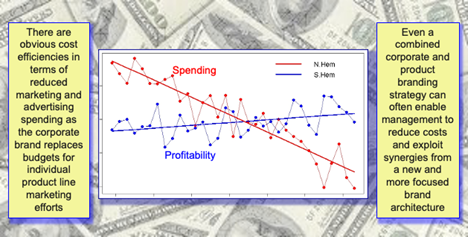
6) INTERNAL ESPRIT DE CORPS
Before discussing the role a corporate brand plays in company culture, it is important to distinguish between two similar, yet distinct concepts: employer branding and employee brand engagement. (Employee Engagement is the subject of Workshop #11.) Employer branding refers to a company’s efforts to attract top talent, which is an inherently external effort. Employee brand engagement, on the other hand, is how a company shapes and influences its current employees’ everyday work behavior to make it consistent with the organization’s brand identity; this is inherently more internally focused. The corporate brand is important for both concepts.
The corporate brand can sometimes serve as an organizational “North Star” for its employees. For example, the Apple brand has a strong position as an innovative company that offers an array of products and services. Its corporate brand encompasses the spirit of the company to employees, in addition to inspiring consumers to buy Apple products.
The corporate brand may also be a tremendous source of pride for employees across all levels of an organization. In fact, it is not uncommon for longtime employees to struggle with a change in corporate identity following a merger or acquisition. This is evidence of the power of a corporate brand, and the deep attachment employees develop with it. The same concept applies to candidates in the recruitment process. A company’s reputation in the market weighs heavily on a potential recruit’s choice of employer. Whether the brand acts as a source of pride or as a recruitment tool, the corporate brand matters to employees as much as it does to customers and other stakeholders.
According to Rick Wise, “Today’s employees are less loyal than they were a decade ago, but at the same time workers and managers are ‘badged’ with their employer’s brand like never before. Having a clear corporate story that resonates with employees and recruits is just as crucial as a resonant story for product brands.”
For example, Amazon purchased Zappos years ago, and when the news became official, Zappos sent an announcement to its employees that said, “Zappos and Amazon sitting in a tree…” That spirit remains with Zappos today as a $1 billion company by revenue. Its core values, including phrases like “create fun and a little weirdness,” are clearly intended to generate esprit de corps and help employees feel like they’re a part of something special.
7) STAYING POWER
In an ever-changing consumer environment, success in individual product and service lines is never a guarantee. Many successful product brands have disappeared over the years, while their respective corporate brands continue to thrive. When products and services are fleeting, the brand must be enduring. And once again, more often than not, that brand is corporate.
Examples of corporate brands outliving product brands are common in many industries. In the world of consumer packaged goods, for example, the Pepsi corporate brand has outlived many of its child brands, including WOW Chips, Pepsi A.M., Slice, and Teem.
Even the most established product brands don’t last forever. Still, history has proven that corporate brands—with the exception of a possible phase-out after M&A activity—are the brands that are most likely to withstand the test of time.
The importance of the corporate brand has grown in recent years and will likely continue to in the future. The trend in corporate brand investment certainly applies to many B2B and Branded House B2C companies. Still, it also applies to traditional consumer packaged goods companies that typically go to market based on the strength of their individual product brands.
In summary, building and maintaining a corporate brand provides many benefits. The perks include financial return, risk mitigation during challenging times, leverage to enter new categories and markets, and employees’ overall sense of pride. With such power and so many benefits, it makes sense that the majority of the world’s most valuable brands are corporate brands.

EXERCISE 1.5: CORPORATE BRAND ASSESSMENT
1) Financial Security & Influence. Do you think your corporate brand has significant economic value? Does it have clout in the financial market? Do you believe it would serve as a strong asset in a potential future capital event?
2) Purpose through Corporate Branding. Is your corporate brand defined by, and associated with, a higher-level purpose? What is this purpose and why is it valued in the marketplace?
3) Risk Mitigation During Challenging Times. Has your company ever had to navigate a crisis during which the strength, equity and goodwill of your corporate brand helped it pull through?
4) Market Penetration. To what extent does your corporate brand give you permission to extend into new markets and geographies? Here, we’re referring specifically to your company’s brand reputation, not necessarily its tangible competencies.
5) Cost-effective Operations. If your portfolio is a Branded House, do you believe your company is able to capitalize on its master brand to achieve efficiencies in marketing and operations?
6) Internal Esprit de Corp. Do you believe there is pride in working for your company? Do you believe the reputation of your corporate brand helps build spirit and enthusiasm among employees?
7) Staying Power. How long has your corporate brand been in existence? Has it changed names over the years, due to M&A or other activity?

Course Manual 7: Product Brand
Product branding and corporate branding are two sides of the same coin, yet they serve different roles within a company’s portfolio and overarching brand strategy. Corporate branding, as just discussed, is about the overall perception of the company itself—how it presents itself to the world and its myriad stakeholders (many of whom will never purchase a single product or service).
Conversely, product branding focuses on creating a unique identity for a specific product or product line, aiming to set it apart from competitors in the market. Product brands often entail a more direct call-to-action (CTA) than a corporate brand—especially to make a purchase. These two types of brands, while interconnected, function on different levels and serve different objectives within a company’s marketing and business strategies.
THE ESSENCE OF PRODUCT BRANDING
As with corporate branding, at its core, product branding is about distinction. It revolves around the creation of a unique value proposition and identity for a specific product that makes it stand out in a crowded marketplace. This identity is built through a combination of factors, including the product’s name, logo, design, messaging, and overall positioning. Each element is carefully crafted to communicate the product’s specific attributes, features, and benefits to its target audience. The goal of product branding is to foster recognition, drive preference, and build loyalty toward the product itself.
Product branding tends to be inherently tactical in nature. It is centered around the immediate needs and desires of the consumer and focuses on driving consumer recognition, preference, purchase, and loyalty. When a company launches a new product, it seeks to differentiate that product from others in the same category, ensuring that consumers understand why this offering is better suited to their needs than any alternatives.
For instance, consider the way Apple brands its iPhone. The iPhone is not simply marketed as another smartphone; rather, it is positioned as a sleek, cutting-edge device that embodies innovation, superior design, and ease of use. Through its distinct branding, Apple has cultivated a loyal customer base that is drawn to the iPhone’s unique blend of aesthetics and functionality.
This module will reinforce the many ways corporate and product brands are alike, yet also some important ways in which they differ. It will do so from the perspective of target audiences, business objectives, role of emotion, brand architecture, longevity and adaptability, and equity and financial value.
Perhaps the most important point to remember is that whether the brand in question is corporate or product, every element of the Brand Ecosystem (and therefore, every workshop in this Brand Leadership program) is equally relevant, regardless of the type of brand in question.
TARGET AUDIENCES
One of the most significant differences between product branding and corporate branding lies in their respective target audiences. Product branding is often focused on a single stakeholder group: customers. And well-positioned brands are often even more narrowly targeted than that—on a specific customer sub-segment or niche within a broader market. The branding is designed to appeal to a group’s preferences, needs, and desires.
For example, the branding of a luxury product like a high-end watch is aimed at affluent consumers who value craftsmanship, exclusivity, and status. The marketing and branding efforts are tailored to appeal to these qualities, making the product desirable to this specific audience. This is in stark contrast to corporate branding, where (depending on the company in question), the brand potentially needs to appeal to a diverse set of stakeholders beyond customers—including investors, employees, regulators, media, vendors, etc.
BUSINESS OBJECTIVES
Given its narrower focus on audience, it’s not surprising that the business objectives associated with product brands tend to be narrower and more specific than those of corporate brands. For example, a product brand may be charged with the strategic role of “fighter brand” to compete effectively in a highly competitive category. Or it may be positioned as a value brand to appeal to budget-conscious consumers. Because their primary (if not sole) target is customers, product brands have the luxury of serving more targeted business objectives and strategic roles. As demonstrated in the previous course module, this is not the case with corporate brands and their vastly more expansive base of stakeholders. By their very nature, they are tasked with a broader array of marketing and business objectives.
THE ROLE OF EMOTION
Both product branding and corporate branding aim to create emotional connections with their audiences, but they do so in different ways. In product branding, the emotional connection is often tied to the product’s performance and the consumer’s experience of using it. For example, a beloved food or drink product might evoke feelings of nostalgia, comfort, or happiness. These emotions drive consumer preference and loyalty. Coca-Cola, for instance, has long used its branding to create associations with happiness, joy, and togetherness. Through its iconic red packaging and memorable advertising campaigns, Coca-Cola has positioned itself as more than just a soft drink—it is a symbol of good times and shared moments.
Conversely, a corporate brand may choose to tap into a higher-order social purpose (or cause) to establish an emotional connection with its target audience. While there are exceptions—Dove, with “Real Beauty,” is one of the best examples of a product brand positioned around a social purpose—this tends to be somewhat less common with product branding than with corporate branding.
BRAND ARCHITECTURE
Brand architecture—which is the subject of the next course module—is another area where product and corporate branding often diverge. Companies that focus on product branding often use what is known as a “House of Brands” portfolio structure, where each product has its own unique brand identity, sometimes independent of the corporate brand. This allows for flexibility in how different products within the portfolio are positioned and marketed, as each can be tailored to appeal to its specific target audience. Procter & Gamble (P&G) is a prime example of a company that uses a House of Brands strategy. P&G’s product brands, such as Tide, Pampers, and Gillette, each have their own distinct branding that is independent of the P&G corporate brand. This approach allows P&G to target different consumer segments with highly specialized positioning and branding for each. Conversely, the corporate brand is often (though not always) the endorsing entity within an endorsed brand relationship.
LONGEVITY & ADAPTABILITY
Another key difference between product branding and corporate branding lies in their longevity and adaptability. Product brands tend to evolve more rapidly over time in response to changes in the market, consumer preferences, or competitive pressures. Product brands must stay relevant and engaging to retain their appeal to consumers. This often involves updating and refreshing logos, packaging, and/or messaging to reflect new fads, trends, or innovations. PepsiCo, for example, frequently refreshes the branding of its Pepsi soft drink products to keep them relevant with younger audiences. By updating its logo, packaging, and marketing campaigns, PepsiCo ensures that its products remain appealing to new generations of consumers. This is NOT to suggest that it is okay for corporate brands to become outdated or stale—this is certainly not the case. However, all other things equal, we tend to see changes to visual identity and other creative expression occur more frequently in product branding than in corporate branding.
EQUITY AND FINANCIAL VALUE
Both product brands and corporate brands have brand equity—the financial value derived from consumer perceptions, loyalty, and recognition. Strong product brands can command higher prices, foster customer loyalty, and drive long-term profitability more effectively than their weaker counterparts. For example, Tide detergent has built significant brand equity over the years due to its strong reputation for quality, “whitening performance,” and overall effectiveness. This allows P&G to maintain premium pricing in the competitive detergent market, as consumers are willing to pay more for a trusted brand with an outstanding track record and reputation.
However, as we’ve learned in previous modules, corporate brands are incredibly valuable as well. It is interesting to note that the lists of the world’s most valuable global brands contain far more corporate brands than product brands. In fact, as we learned earlier, the world’s most valuable brand (according to Interbrand) is Apple—valued at over $500 billion. This underscores the important point that ALL brands (and types of brands) have financial value—or at least the potential for it.
FINAL WORD ON CORPORATE vs. PRODUCT BRANDS
It is important to reiterate a point made at the beginning of this module. Although there are several notable differences between product brands and corporate brands—there are far more similarities when it comes to developing brand strategy and activation. Whether the brand you will working on for this Brand Leadership program is corporate or product, all the concepts we cover will be equally relevant.
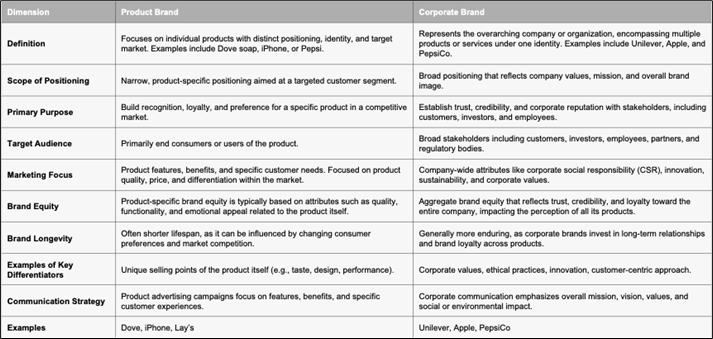
This point becomes evident when we revisit the Brand Ecosystem. When doing so, it’s easy to see that every component in the ecosystem is relevant, whether a brand is a corporate brand or product brand. Namely, the brand will need to be positioned. It will have an extension and growth strategy. A visual and verbal identity. A brand story or narrative. A website (whether for company or product). Content marketing campaigns. Social media engagement. A brand experience. It will require measurement and tracking. And so on.

CASE STUDY: THE INTERPLAY BETWEEN PRODUCT & CORPORATE BRAND
The iPhone provides an excellent example of an intelligently conceived and thoughtfully marketed product brand. Apple’s ability to seamlessly integrate its overarching identity with its specific product lines, most notably the iPhone, demonstrates its strategic mastery of branding. It begins with its corporate brand, Apple. But it’s difficult to dispute the brilliance of the iPhone as a product brand

The Corporate Brand: Apple Inc.
Apple Inc., founded in 1976 by Steve Jobs, Steve Wozniak, and Ronald Wayne, has grown into one of the world’s largest and most profitable companies. As a corporate brand, Apple is synonymous with innovation, premium quality, and cutting-edge design. Apple’s corporate philosophy—focused on simplicity, elegance, and user-centricity—originated from Jobs’ vision and continues under current CEO Tim Cook’s leadership. The company represents not just technology, but an ethos that blends form with function and is grounded in aspirational values encapsulated by the famous slogan, “Think Different.”
Apple’s corporate brand extends beyond products; it reflects a culture of excellence and innovation. Apple’s employees are driven by a shared commitment to pushing technological boundaries, and this is mirrored in the design and performance of Apple products. Over decades, Apple has cultivated an image of reliability, premium quality, and luxury. This global corporate identity resonates across all its offerings, making Apple more than just a technology company—it’s a lifestyle brand.
The Product Brand: The iPhone

The iPhone, first launched in 2007, revolutionized the smartphone industry and became Apple’s most iconic product. As a product brand, the iPhone has carved out its own identity while being intrinsically linked to Apple’s corporate reputation. The iPhone is synonymous with innovation, sleek design, and a superior user experience, perfectly reflecting the parent Apple brand.
More than a piece of technology, the iPhone represents status, modernity, and sophistication. Apple’s marketing strategy reinforces this by highlighting not only the device’s technical capabilities but also the emotional benefits it offers users—connection, creativity, and joy. The iPhone’s sleek design and intuitive user interface encapsulate Apple’s emphasis on aesthetic beauty and functionality, further solidifying the device as a symbol of high-quality, premium technology.
Apple’s product brand success is amplified by its integration into a broader ecosystem. The iPhone is the entry point into Apple’s universe of services and products, including the App Store, iCloud, and wearables like the Apple Watch. This ecosystem creates a strong bond between Apple’s corporate brand and its product brands, allowing each to reinforce the other’s identity and value.
The Interplay Between Corporate and Product Brands
This success story stems from the harmonious relationship between corporate and product brand. The success of the iPhone bolsters Apple’s corporate brand, while the company’s reputation as a leader in innovation and design elevates the iPhone to an aspirational product. Each new iPhone release is treated as a global event, reinforcing Apple’s identity as a cutting-edge technology company while showcasing the iPhone as a premium product that sets industry standards.
Apple’s retail strategy reflects this interplay. Apple Stores are designed to embody the company’s minimalist aesthetic and user-focused ethos. They provide an environment where customers can engage with the iPhone and other products, reinforcing the premium nature of both the product and the corporate brand. The stores offer a curated experience that underscores Apple’s values of simplicity, elegance, and innovation.
The pricing strategy for the iPhone also plays a critical role in this dynamic. Positioned as a premium product, the iPhone justifies its higher price point through consistent innovation and a superior user experience, reinforcing Apple’s corporate brand as a maker of luxury technology. This alignment ensures that Apple maintains its reputation for high-quality, aspirational products.
Challenges and Risks
However, Apple’s reliance on the iPhone poses certain risks. The iPhone accounts for a significant portion of Apple’s revenue, and any downturn in its performance could negatively impact the corporate brand. As the iPhone and Apple are so closely intertwined (i.e. sub-brand), any issues with the product—such as design flaws or lackluster updates—could tarnish Apple’s broader reputation.
Furthermore, as Apple diversifies into new areas like wearables, services, and potentially even vehicles, the company must maintain the balance between its corporate brand identity and the evolving identities of its product brands. Ensuring that the corporate brand remains flexible while preserving its core values is crucial as Apple expands into new markets.
Apple’s ability to function as both a corporate and product brand highlights the power of strategic brand management. The company has successfully created a symbiotic relationship between its corporate identity and its product offerings, particularly the iPhone, resulting in an ecosystem where each brand reinforces the other’s strength.
However, through consistent innovation, premium pricing, and a cohesive brand experience, Apple has crafted an image of excellence that resonates globally. The alignment between Apple’s corporate values and its product branding ensures that Apple Inc. continues to lead the market as both a trusted corporate brand and a maker of aspirational, cutting-edge products, like iPhone.

Course Manual 8: Brand Architecture
Brand architecture is a critical (and at times complex) concept within the field of brand strategy. Broadly speaking, brand architecture defines the type of relationship (if any) brands within the portfolio have with one another. This often involves the relationship between a product brand and a corporate brand. Explicit relationships tend to be most evident in the company’s visual identity system, through logo locks and other overt linkages.
Brand architecture is also where we begin to apply the different “hierarchy” and “types” of brands covered in a previous course module in this workshop (e.g., master brands, endorsed brands, co-brands, sub-brands, and descriptive brands).
BRAND PORTFOLIO STRUCTURE
The structure of a brand portfolio can be thought about on a continuum from Branded House to House of Brands. A Branded House, where the focus is on a single, well-established master brand (e.g., GE), 2) a House of Brands, where numerous brands—each with its own target audience, positioning, and visual identity—operate independently from one another (e.g., Unilever), or 3) a Hybrid, which lies between the two ends of this continuum. There are advantages and drawbacks to each portfolio structure.
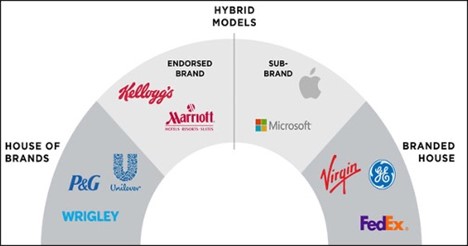
Perhaps the biggest advantage of a Branded House lies in its efficiency. It stands to reason that a single brand requires fewer resources (time, effort, money) to manage than a portfolio of brands. All branding efforts can be channeled toward that lone brand asset, which enhances internal focus and provides for external clarity in the marketplace. A potential downside to a Branded House is that a single brand may not be versatile enough to be equally relevant across myriad customer segments, industry verticals, product categories, geographic regions, and multiple stakeholder groups.
At the other end of the continuum is a House of Brands. The advantages and disadvantages of this portfolio structure are the reverse of a Branded House. A broad portfolio of brands provides the company the ability to target different segments, markets, and regions with different brand propositions—ones which are uniquely tailored to serve that intended audience. The downside of the House of Brands structure is the abundance of resources required to build, manage, and maintain it. Specifically, far more resources (monetary and other) are required to support this type of portfolio in a high-caliber manner, and on an ongoing basis.
It is important to note that are few examples of “pure” Branded Houses and Houses of Brands. Most portfolios reside somewhere in between the two extremes, but often lean more heavily toward one end than the other. The advantages and disadvantages of Hybrid portfolios are easy to discern based on those attributed to the two “extremes,” and the extent to which a Hybrid portfolio skews closer to one end of the spectrum than the other.
There are some general rules of thumb regarding where on the structure continuum is the optimal position for any given company’s brand portfolio to reside. They relate to five primary considerations regarding the company and business in question.
1) Number of Customer Segments
Companies should consider the number of distinct customer segments they serve and the number of segments they are attempting to target. Ideally, a well-positioned brand is targeted toward a single customer segment. That brand can serve only that segment—plus, at most, one or two others—exceedingly well. So, it stands to reason that the more distinct customer segments in a market (and the greater number of those segments a company seeks to serve), the more brands required to complete the portfolio. In this scenario, companies tend to lean toward the House of Brands end of the spectrum.
2) Range or Breadth of Offer
The range (or breadth) of offer is closely related to customer segments. Brands inherently have limitations to how far they can stretch across different categories, and in terms of price/value. Regardless of the strength of equity, there are some categories for which a given brand simply won’t make sense. Therefore, all other things equal, the greater the number of product categories in which a company competes, the more likely its portfolio will need to reside on the House of Brands side of the spectrum.
As always, there are exceptions to the rule. Many exceptions in this category can be found in B2B organizations. General Electric (GE) is often cited as the quintessential Branded House because its corporate master brand has demonstrated relevance across a diverse set of industries and product categories, ranging from transportation and energy to healthcare and industrial.
3) Corporate Brand Relevance
Corporate brands can have varying levels of market relevance based on several factors.
One is the nature of the business. In some businesses, the company behind the products and services is more important than it is in others. Professional services is an industry in which the master brand is critical. Clients often buy the brand as much as the individual service offerings provided by the firm. In these cases, going to market with the corporate brand in a driving role is logical. Following this pattern of thought, firms such as McKinsey & Company, Boston Consulting Group, KPMG, and Ernst & Young are quintessential Branded Houses that trade heavily on the equity they’ve built in their master brands.
4) Investment in Branding
The extent to which a company is willing to invest in brand-building—and not just for its corporate brand, as referenced above—in part determines where on the brand portfolio spectrum it should reside. Brands are assets and require significant investment to develop, launch, and maintain. This includes expenses and ongoing investments, such as advertising, promotion, market research and insights, visual identity and assets, and digital activation. Because of these costs, a House of Brands portfolio requires far more financial resources to support than a Branded House portfolio.
5) Brand Management Competency
In addition to financial resources, brand management requires human resources and functional expertise. Companies need human talent to build and maintain strong brand assets over time. Therefore, organizations must consider the extent to which they’re willing to invest in developing and recruiting employees with the necessary skills to drive brand leadership.
Importantly, this applies to both the creative and strategic sides of brand-building. While some components of brand-building can be outsourced to consultants and agencies, a House of Brands portfolio almost always requires more internal brand and marketing talent than a Branded House portfolio. Consumer packaged goods (CPG) companies like P&G, Kraft Heinz, and General Mills have brand-building as a core competency, which makes it easier for them to justify and effectively support a House of Brands portfolio structure.
Below is a summary of the five considerations we just reviewed, and how they impact the decision on brand portfolio structure.
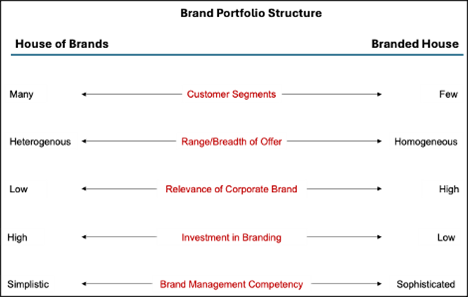
EQUITY FLOW
Core to the topics of brand types and brand architecture is the concept of brand equity flow. When two brand entities are explicitly connected to one another (e.g., a logo lock), it should always be with a specific strategic intent in mind. As we’ll soon see, sometimes the intent is short-term, other times it is longer-term or even permanent. But the rationale for doing so should always be the same.
Specifically, two brands should be overtly linked with one another ONLY when it is believed that “equity will flow” between the brands (in one or both directions)—to the benefit of one or both brands, and to the detriment of neither. If that is not the case, there should be no overt linkage. While this may seem like an obvious point, far too often it’s the case that brands are linked to one another for no apparent strategic rationale. Importantly, the concept of brand equity flow can be further characterized in three ways, making the strategic intent of linkage more evident.
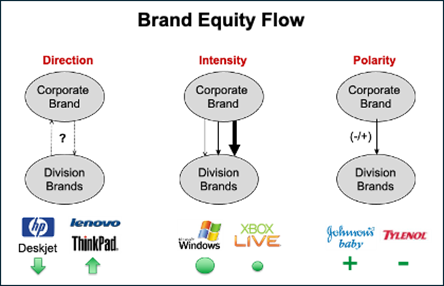
1) Direction of Equity Flow
The first, and most obvious, consideration regarding equity flow is the direction it is intended to take. In other words, from which brand to which brand. In terms of direction, equity flow can be either unidirectional or bidirectional.
Unidirectional equity flow is when equity flows in a single direction, typically from a parent brand or master brand to a sub-brand, endorsed brand, or descriptive brand. This is usually from the master brand to the other brand. In our earlier example, brand equity flows from “Marriott” (the parent brand) to “Courtyard.” Marriott’s impeccable reputation for quality and hospitality enhances Courtyard’s credibility, but Courtyard does not significantly affect Marriott’s brand equity in return.
However, there are times that the intent could be to achieve “reverse equity flow” (e.g., from a child brand to a parent brand). A recent example of this is with the formation of Alphabet as a holding company residing over Google. Clearly, Google is a master brand with enormous brand equity and value, and the parent brand Alphabet’s reputation and image is positively impacted through direct association.
Bidirectional equity flow is most often seen in the case of co-branding. As referenced earlier in the Nike+ example, Nike’s association with athletics and performance boosts Apple’s presence in the health and fitness tech market, while Apple’s reputation for innovation and technology enhances Nike’s brand image in connected sports equipment. In this sense, equity flow is truly bidirectional.
2) Intensity of Equity Flow
Intensity refers to the strength (or degree) of equity transfer between two brands. It is influenced by factors such as the strategic objectives of the brand architecture, the degree of brand association, and the prominence of visual branding elements (such as logo size and relative emphasis). Intensity can be high, moderate, or low.
High intensity features a strong transfer of equity where the parent brand has a significant impact on the sub-brand or endorsed brand, or vice versa. For example, the equity flow for iPhone—a sub-brand of Apple—is highly intense. The parent brand’s reputation for quality, innovation, and design excellence heavily influences consumer perceptions of the iPhone. Conversely, the iPhone’s success reinforces Apple’s equity as a leader in technology and elegant design.
A moderate level of equity transfer is one where the supporting brand provides brand recognition and value but does not completely define the sub-brand’s or endorsed brand’s market positioning. The Fairfield hotel brand is an endorsed brand by Marriott. The equity flow is considered moderate because Marriott’s endorsement gives Fairfield a level of credibility and quality assurance, but Fairfield also maintains its own identity as a value brand with an affordable and simpler lodging option within the Marriott brand portfolio.

Finally, low intensity implies minimal transfer of equity between two brands. Here, the brands in question have an association that allows them to maintain relatively separate identities and the equity flow is limited, relatively speaking. This is often the case in a House of Brands portfolio structure. For example, Tide is a laundry detergent brand that is part of Procter & Gamble (P&G), a House of Brands portfolio. Tide operates as a master product brand within the House of Brands portfolio structure of P&G. P&G’s corporate identity is not prominently featured on Tide packaging, and Tide has its own strong brand equity based on high performance in the laundry detergent market. While the Tide brand may be featured in P&G portfolio-level activation (for example), in general, the equity flow between the two brands is low.
3) Polarity of Equity Flow
Polarity refers to the positive or negative nature of brand equity transfer. Positive polarity means that the equity flow enhances brand value, while negative polarity indicates a detrimental effect, potentially damaging one or more brand’s perception or reputation. Obviously, negative polarity is never an objective or desired outcome, and if it’s anticipated, the linkage should not be pursued. Nonetheless, it sometimes happens unintentionally and needs to be considered as a potential unintended consequence when linking brands through architecture, or even through less overt forms of associations.
Intel is an example of positive polarity equity flow. The “Intel Inside” ingredient brand represents positive polarity, enhancing a computer manufacturer’s brand image. Specifically, Intel’s reputation for performance and quality benefits computer manufacturers’ brands, while Intel gains exposure and positive brand equity through association with successful and trusted computer partners like Dell and Lenovo. In this case, the positive equity flow is bidirectional.
However, as indicated above, polarity can unfortunately be negative. Consider, for example, the Volkswagen diesel emissions scandal back in 2015. During this period, Audi, a subsidiary of Volkswagen, experienced negative polarity merely through its implicit association with its parent Volkswagen’s brand. The negative equity flow from the parent brand’s scandal impacted Audi’s reputation, leading to reduced consumer trust in both brands.
BRAND ARCHITECTURE & VISUAL IDENTITY
One of the reasons brand architecture is so important is it represents a critical strategic foundation for informing brands’ identity systems (visual and verbal). In essence, a brand’s identity system—among other things—should reflect the underlying brand architecture strategy of the portfolio. Clearly, brand identity entails far more than merely brand architecture, and as such, an entire future workshop (#5) is dedicated to the topic. However, here it’s worth briefly mentioning the interrelationship between the two concepts.
Specifically, visual identity plays a significant role in communicating the hierarchy that exists within the brand architecture. For example, in a Branded House strategy, a uniform logo, font, and color palette may be used to convey that all products or services belong to the same family. In a House of Brands strategy, the visual identity can create clarity by differentiating each brand and clearly communicating that they cater to different segments and customer or consumer needs.
Brand architecture also helps define and explain the relationships between the parent brand and its sub-brands, endorsed brands, co-brands, and descriptive brands. This includes, among other things, which brand is in a dominant (driver) role. In some cases, the association is established merely through visual means (e.g., logo locks). In other cases, it’s reinforced through verbal means—messaging and communication. When the desired strength of the equity flow is “intense,” both visual and verbal means are often used.

CASE STUDY — BRAND EQUITY FLOW
FedEx’s acquisition of office supply retailer Kinko’s is a great example of how an eventual brand architecture resulted from a two-step process—using two different brand “types.” In 2004, FedEx Corporation acquired Kinko’s, a well-known retail chain that offered photocopying, printing, and business services. The acquisition was valued at $2.4 billion. The primary motivation for FedEx to acquire Kinko’s was to expand its service offerings beyond shipping and logistics into business services, including printing, copying, and office supplies.

After the acquisition, FedEx rebranded Kinko’s as “FedEx Kinko’s” (i.e. a co-brand) to leverage the existing brand equity of Kinko’s while aligning it more closely with the FedEx brand. This co-branding strategy was intended to communicate the expanded range of services offered at these locations, combining the convenience and service portfolio of Kinko’s with FedEx’s reputation for reliable shipping and logistics.
Over time, the FedEx brand began to establish its own credibility in the office and business services space. The business risk associated with eliminating “Kinko’s” from the brand was deemed as minimal. As such, in 2008, the company decided to rebrand all FedEx Kinko’s locations as FedEx Office. This shift to a descriptive brand was part of a broader strategy to consolidate the brand under the FedEx name, ensuring a more unified brand identity across all services and offerings. Today, the FedEx Office descriptive brand is fully integrated into the broader FedEx brand architecture, aligning with other descriptive brands like FedEx Express, FedEx Ground, FedEx Freight, and FedEx Logistics.
The evolution of FedEx’s brand architecture following the acquisition of Kinko’s reflects more than merely an exercise in naming and visual identity. Rather, it was a strategic effort to integrate a newly acquired brand into the existing brand portfolio, ensuring synergy between the different businesses while optimizing market reach and ensuring customer clarity and loyalty. The rebranding to FedEx Office allowed FedEx to simplify its brand structure (in keeping with a Branded House), enhance service offerings, and strengthen its position in the market as a one-stop solution for shipping and business services.
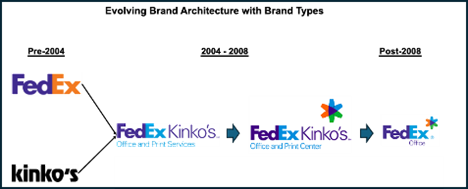

EXERCISE 1.6: BRAND PORTFOLIO STRUCTURE
• Where on the brand portfolio structure continuum does your company reside (Branded House, House of Brands, Hybrid)? If Hybrid, which of the two other options does it more closely resemble?
• Given the principles discussed in this course module, do you think your current structure is optimal? Why or why not? If not, how could it potentially be improved? Please consider the following criteria when making this evaluation:
o Customer segments
o Breadth/range of offer
o Relevance of corporate brand
o Investment in branding
o Brand management competency

Course Manual 9: Market Definition
For the purposes of this program, we will define a market as the sum-total of all the buyers and sellers for a particular set of products and services in the area or region under consideration (both physical and virtual). The world of commerce is structured around various models of interaction between companies and their customers, each with distinct dynamics that cater to different market needs. At the heart of these interactions are three primary business models: B2B (Business-to-Business), B2C (Business-to-Consumer), and B2B2C (Business-to-Business-to-Consumer). Understanding the nuances of these models is crucial for businesses that want to refine their strategies and align with the appropriate audience.
B2B: THE BACKBONE OF INDUSTRY
In the B2B (Business-to-Business) model, companies don’t sell directly to individual consumers but rather to other businesses. The transactions typically involve products or services designed to improve the efficiency, productivity, or operations of another business. Think of it like the hidden architecture behind the consumer experience. For example, a business may supply the raw materials that another company uses to manufacture its products, or a software firm might develop enterprise-level solutions that help businesses manage their operations.
The B2B model is defined by its complexity. The sales cycles are often long, sometimes stretching over months or even years, due to the detailed negotiations, contracts, and agreements that must be forged between two companies. For this reason, relationships and trust are paramount in B2B interactions. The branding and marketing here tends to be more educational, with an emphasis on building long-term partnerships rather than just making a one-time sale.
Salesforce exemplifies the B2B model in action. As one of the world’s leading Customer Relationship Management (CRM) platforms, Salesforce is designed to help businesses improve how they manage customer data, automate marketing processes, and streamline sales. Its clients are not everyday consumers but businesses seeking to strengthen their interactions with their own customers. Another prominent example is Microsoft Azure, which provides cloud infrastructure to companies looking to store data, run applications, and scale their operations. These services are not intended for individual use but are tailored to enhance the performance of entire organizations, making B2B an essential part of the global business ecosystem.
B2C: WHERE BUSINESSES MEET CONSUMERS
In contrast, B2C (Business-to-Consumer) models are what most people think of when they imagine commerce. This model involves businesses that sell products or services directly to individual (end) consumers for personal use. The B2C model is ubiquitous, found in everyday interactions—when you buy groceries, stream a movie, or order a new phone online, you’re engaging in a B2C transaction.
B2C companies prioritize accessibility, convenience, and customer experience, offering products or services that meet the needs and desires of individuals. These companies often have shorter sales cycles, as consumers typically make purchase decisions much faster than businesses do. The branding and marketing strategy in the B2C world relies heavily on brand awareness, emotional connection, and customer engagement, often using compelling advertisements and direct sales to drive purchases.
Amazon, one of the world’s largest retailers, is a prime example of the B2C model. Whether you’re buying electronics, clothing, or household goods, Amazon provides an easy, accessible platform for consumers to make purchases from the comfort of their homes. Similarly, Netflix delivers entertainment directly to consumers through its streaming service. People subscribe to Netflix to access a vast library of content, from movies to TV shows, all of which is provided for personal consumption rather than for business use. Both these companies excel at understanding and meeting the needs of individual consumers, making them quintessential examples of the B2C model.
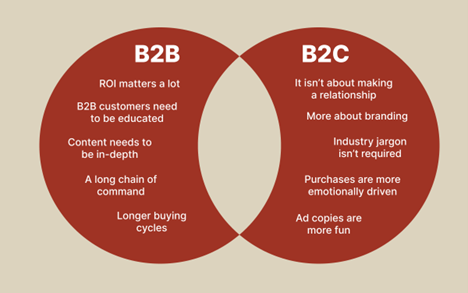
B2B2C: BRIDGING BUSINESSES AND CONSUMERS
The B2B2C (Business-to-Business-to-Consumer) model blends elements of both B2B and B2C models into a hybrid approach. In this structure, one business sells its products or services to another business, which then uses those products or services to reach individual consumers. The B2B2C model creates a chain where the first business enables the second business to better serve the end consumer, providing an indirect but essential link between the two.
This model is increasingly common in platform-based industries where businesses provide the tools or infrastructure that other companies use to engage consumers. One well-known example is Uber Eats. Uber partners with restaurants, offering them a platform through which they can sell food directly to consumers. The restaurants benefit from Uber’s technology and delivery infrastructure, while Uber gains access to the restaurant’s customer base. The result is a seamless interaction where both businesses collaborate to meet consumer demand for convenient food delivery.
Another example of B2B2C in action is Shopify, an e-commerce platform that enables businesses to set up online stores and sell products directly to consumers. Shopify provides the technical foundation that allows smaller retailers to manage their digital storefronts and process transactions, bridging the gap between the retailer (the second business) and the end consumer. Shopify itself doesn’t sell directly to consumers but empowers businesses to do so, thus facilitating the B2B2C chain.

A COMPARATIVE PERSPECTIVE
These three business models—B2B, B2C, and B2B2C—operate in distinct ways but are all essential in driving the modern economy. B2B models focus on enhancing business operations through long-term partnerships and complex sales processes. B2C models, by contrast, emphasize rapid transactions and customer satisfaction, catering directly to the individual consumer’s needs. The B2B2C model serves as a bridge, helping businesses use another business’s products or services to meet consumer demand more effectively.
Below is a table that helps to compare and contrast the three business models across several important dimensions.

THE FUTURE OF BUSINESS MODELS
As industries evolve, the lines between these models are blurring. The rise of D2C (Direct-to-Consumer) strategies is allowing companies to bypass traditional retail and sell directly to consumers via digital platforms, challenging the B2C and B2B2C models. Additionally, the growing popularity of B2B2X frameworks, where businesses cater not just to consumers but to any type of end user, whether they be other businesses or governments, points to an ever-expanding landscape of business interaction.
Ultimately, these models reflect the many ways businesses engage with their customers—whether those customers are other companies, individual consumers, or both. Each model has its unique dynamics, challenges, and opportunities, and understanding them helps businesses design better strategies for growth and success in an increasingly interconnected world.
BEYOND BUSINESS MODELS — TO MARKETS
Beyond the business model types detailed above, markets serve to answer three basic questions about the business:
1. What is being offered (product/service categories)?
2. Who is being targeted (consumer/customer segments)?
3. Where is the market is located (geographic regions; online)?
Market definition and segmentation helps in prioritizing resources and customizing messaging and product features for different groups, leading to better customer satisfaction and loyalty. It also allows businesses to identify underserved or niche markets that may offer growth opportunities. The following serves to provide additional detail on, and examples of, each of the three market components.
1) Product/Service Categories
The category component of market answers the question of “what is being sold?” and refers to groups of products or services that share similar characteristics, functionalities, or purposes. Each category is defined by the specific types of needs or problems that the products or services within it are designed to address.
For example, in a consumer market, categories might include electronics (smartphones, laptops, televisions, headphones), apparel (casual wear, formal wear, activewear, outerwear), food and beverages (snacks, frozen foods, dairy products, non-alcoholic beverages), and personal care (skincare products, hair care products, cosmetics, toiletries).
In a B2B market, categories might include software solutions (Enterprise Resource Planning (ERP) software, Customer Relationship Management (CRM) software, cybersecurity tools), consulting services (management consulting, financial advisory, IT consulting, marketing consulting), industrial equipment (construction machinery, packaging machinery, laboratory equipment), and office supplies (printers, stationery, furniture, computer accessories).
2) Consumer/Customer Segments
The segment component of market answers the question of “who is being targeted?” and refers to specific groups within a market that have common characteristics, needs, preferences, or behaviors. Whether B2B or B2C, segmentation helps businesses understand their target audience better and tailor their product development, customer service, and marketing strategies to meet the unique needs of different groups. Means for segmentation can be either tangible and/or intangible.
Tangible forms of segmentation use concrete or objective facts and figures to define segment clusters. Examples include demographics such as age groups (Millennials, Gen Z, Baby Boomers, etc.), income levels (affluent consumers, middle-income earners, low-income earners), gender (men, women, non-binary individuals), and ethnicity (White, Hispanic, Black, Asian, etc.). They also include firmographics in B2B, such as industry/sector (healthcare, finance, manufacturing, retail), company size (small businesses, mid-sized companies, large enterprises) and decision-making role (C-level executives, department heads, procurement managers).
More sophisticated forms of segmentation use less tangible/discrete characteristics to define segments and clusters. For example, behavioral segmentation can be based on purchase behavior (frequent buyers, occasional buyers, one-time buyers), usage rate (heavy users, medium users, light users) or brand loyalty (loyal customers, brand switchers, price-sensitive customers). Conversely, psychographic segmentation can be based on lifestyles (health-conscious consumers, luxury seekers, tech enthusiasts) or attitudes and values (eco-conscious individuals, socially responsible consumers, traditionalists).
3) Geographies/Regions
The third component of market pertains to place, and answers the question of “where is the market located (physically and/or virtually)?” Location segmentation is important because it considers factors such as cultural, economic, and regulatory differences, which can impact consumer or customer behavior, product preferences, and ultimately business strategies.
Depending on the nature of the business, geographic segmentation may be global and include continents (e.g., North America, Europe, Asia, Africa) or trade zones (e.g., European Union, ASEAN, NAFTA). It could be country-specific (United States, Germany, Japan, Brazil) or regional variations within countries (Midwest, Bavaria, Kanto). Finally, it may be defined more locally, for example cities or metropolitan areas (New York City, London, Sao Paulo, Tokyo), or neighborhoods or districts (Soho, Camden, Shibuya, Jardins).

CASE STUDY: DEFINING A MARKET FOR A GLOBAL BRAND
Now, let’s look at how these three components of market are interrelated and work together.

Deloitte is the largest professional services network by revenue and number of employees in the world and is considered one of the Big Four accounting firms, along with EY, KPMG, and PwC. It does business in 150 countries and territories across the world and serves ~90% of the Fortune Global 500 companies.
Deloitte’s stated purpose is “to make an impact that matters. It leads us to focus on accelerating equity, sustainability and shared prosperity through all that we do: because that’s the type of impact that matters to us, and for our clients, our people, and our communities.”
1) Service Offerings
Deloitte offers a broad range of professional services across multiple categories.
• Audit & Assurance: Independent financial statement audits, internal controls audits, regulatory compliance, and assurance services
• Consulting: Strategy, operations, human capital, technology, digital transformation, and innovation consulting services
• Risk Advisory: Services related to regulatory risk, cyber risk, financial risk, operational risk, and enterprise risk management
• Financial Advisory: Mergers and acquisitions (M&A), restructuring, valuation, forensic, and transaction services
• Tax & Legal: Corporate tax, international tax, indirect tax, transfer pricing, and legal services
• Analytics & Cognitive: Data analytics, artificial intelligence, and machine learning services
• Digital & Technology: Cloud solutions, digital transformation, IT modernization, cybersecurity, and data management
• Human Capital: Talent management, organizational transformation, workforce analytics, and employee experience services
2) Industries & Sectors
Deloitte serves clients across numerous industries, segments, and sectors.
• Consumer: Focused on retail, automotive, travel, hospitality, and consumer products
• Energy, Resources & Industrials: Covering oil and gas, power and utilities, chemicals, mining, and industrial products
• Financial Services: Serving banking, capital markets, insurance, real estate, and investment management
• Government & Public Services: Working with government agencies, public sector organizations, education, and non-profits
• Life Sciences & Health Care: Engaging with pharmaceutical companies, biotech, medtech, health care providers, and health insurers
• Technology, Media & Telecommunications (TMT): Working with technology companies, media, entertainment, advertising, and telecommunications
• Real Estate: Serving real estate developers, managers, and investors
• Private Equity: Assisting private equity firms and portfolio companies with transactions, value creation, and strategic advisory
3) Geographic Regions
Deloitte operates in virtually every region of the world, organized into several key geographic areas.
• North America: Primarily the United States and Canada, where Deloitte has a strong presence
• Europe, Middle East, and Africa (EMEA): Covering major markets such as the United Kingdom, Germany, France, the Netherlands, the Middle East, and Africa
• Asia-Pacific (APAC): Including key markets like China, India, Japan, Australia, and Southeast Asian countries
• Latin America: Operations across Brazil, Mexico, Argentina, and other Latin American countries
• Global Delivery Network: Includes service centers and offices worldwide to support global projects and clients across multiple time zones
While these components may be interesting in isolation, it’s often more helpful to look at the intersection of market components. When intersections are understood more clearly, it makes it easier for Deloitte to better segment and serve their clients.
In this case, there are important dynamics seen in the overlap of service offering and industry sector. Specifically, certain Deloitte services have a stronger presence or are more frequently utilized in specific industries or sectors due to the unique needs and challenges of those sectors.
The following content shows dominant industry sectors for each of Deloitte’s primary service offerings, along with high-level rationale for the dominance.
Audit & Assurance:
• Dominant in: Financial Services, Consumer, Life Sciences & Health Care, and Public Services
• Rationale: Financial services, health care, and consumer industries have significant regulatory and compliance requirements that demand rigorous audits. Public services and government agencies often require transparency and accountability through regular auditing
Consulting:
• Dominant in: Technology, Media & Telecommunications (TMT), Financial Services, Consumer, and Government & Public Services
• Rationale: TMT sectors leverage consulting for digital transformation, technology integration, and strategic innovation. Financial services rely on consulting for digital banking, regulatory changes, and customer experience improvement. The consumer sector benefits from strategy, marketing, and supply chain consulting. Governments and public services require consulting for operational efficiency and service delivery improvement
Risk Advisory:
• Dominant in: Financial Services, Technology, Media & Telecommunications, and Energy, Resources & Industrials
• Rationale: Financial services and TMT sectors face significant cybersecurity, operational, and compliance risks, necessitating robust risk management frameworks. The energy and industrial sectors often encounter regulatory and environmental risks that require specialized risk advisory services
Financial Advisory:
• Dominant in: Private Equity, Financial Services, Consumer, and Life Sciences & Health Care
• Rationale: Mergers, acquisitions, restructuring, and valuations are core activities in private equity, banking, and capital markets. In consumer and health care, companies often engage in M&A, market entry, or exit strategies
Tax & Legal:
• Dominant in: Multinationals across all sectors, Financial Services, Consumer, and Energy, Resources & Industrials
• Rationale: Multinational companies across all sectors require cross-border tax structuring, transfer pricing, and regulatory compliance. Financial services have specific tax needs related to complex transactions and global operations
Analytics & Cognitive + Digital & Technology:
• Dominant in: TMT, Financial Services, Consumer, and Government & Public Services
• Rationale: These sectors heavily invest in data analytics, artificial intelligence, digital transformation, and innovation to drive growth, enhance customer experience, and improve decision-making
Human Capital:
• Dominant in: Consumer, Life Sciences & Health Care, and Government & Public Services
• Rationale: Human capital services, such as talent management and organizational transformation, are crucial for sectors experiencing rapid change, regulatory pressure, or workforce challenges

EXERCISE 1.7: MARKET DEFINITION
1) Is your business primarily B2B, B2C, or B2B2C
2) Is there consensus on the BUs/divisions, product categories, and customer segments that define the Brand Leadership program (i.e., what’s in and out of scope)?
3) Is there consensus on geographic regions that are in and out of scope for the Brand Leadership program?
4) How would your competitors define the market similarly and/or differently from the way you would?

Course Manual 10: Business Strategy
Brand strategy—and the marketing activation tactics that flow from it—cannot be developed in a vacuum. Rather, it needs to be inextricably linked to the business strategy it is intended to serve. As such, our starting point in defining brand strategy is to ensure clarity and consensus around the underlying business strategy.
BUSINESS AND BRAND STRATEGY — MAKING THE CASE FOR LINKAGE
Navigating with Brand and Business Strategy
Imagine a company as a ship navigating through turbulent waters. The business strategy is the ship’s course, steering it toward growth, financial goals, and new market opportunities. But brand strategy is the wind in its sails, the force that propels the ship forward with purpose and energy. When the wind blows in sync with the course, the ship moves swiftly toward its destination. If they are misaligned, the ship might drift off course or lose momentum entirely. In this way, the connection between brand and business strategy becomes the engine that powers consistent progress.
What follows is a list of benefits (and illustrative examples) that accrue to companies that carefully align their business and brand strategies. As you will see, the benefits are numerous and consequential… and they are both tangible and intangible in nature.
Smarter Decision-Making
Aligning brand and business strategy makes critical decision-making smoother and more effective. When leaders know that their strategic choices are supported by both brand values and business objectives, they can act with confidence. Disney, for example, knew that acquiring brands like Pixar, Marvel, and Lucasfilm wasn’t just a financial move to grow its content library—it was also aligned with its brand strategy of being the world’s leader in family-friendly entertainment. Each acquisition reinforced Disney’s position as a content powerhouse, and the seamless integration of these brands into Disney’s portfolio has paid dividends in both financial returns and brand strength.
Strategic Resource Allocation
Brand strategy also helps guide how resources are allocated within the company. Starbucks, for example, pours significant resources into crafting its in-store experience, not just as a place to get coffee but as a “third place” where customers feel comfortable between home and work. This investment isn’t just a branding effort—it’s directly tied to Starbucks’ business strategy of fostering customer loyalty and repeat visits. By aligning brand strategy with business goals, Starbucks ensures that every dollar spent enhances both its brand equity and its financial objectives.
Customer Experience Consistency
This connection also extends to the customer experience. In today’s highly competitive landscape, customers demand more than just products—they expect experiences that align with the promises companies make. Nike exemplifies this beautifully. Its business strategy is built around producing high-performance athletic wear, while its brand strategy focuses on empowering athletes of all levels. From the way Nike designs its products to its iconic “Just Do It” messaging, every touchpoint is a reflection of its promise to help athletes push their boundaries. If Nike’s products didn’t live up to this promise—or if its messaging diverged from the core strategy—the customer experience would be fractured, and loyalty would wane. Brand Experience will be the topic for Workshop #9.
Effective Communication and Market Leadership
Effective communication is another critical benefit of this alignment. Think of Coca-Cola, whose entire identity revolves around happiness and sharing refreshing moments. This is not only its brand promise but also its business strategy, as Coca-Cola aims to dominate the global beverage market by fostering brand loyalty and emotional connections with its customers. Every advertisement, every piece of content, every social media post, and every sponsorship event reinforces this core message. Coca-Cola’s alignment ensures that whether it’s a holiday commercial or a sports sponsorship, the messaging is consistent and supports the company’s overarching business goals.
Internal Alignment and Cultural Strength
Companies like Zappos (referenced earlier for its strong culture), known for their stellar customer service, thrive because their internal culture is a direct extension of both their business and brand strategies. Zappos’ business strategy is simple: deliver the best customer service possible, and everything else will follow. Its brand strategy reinforces this by celebrating the joy of exceptional service and customer happiness. As a result, the company’s employees are empowered to make decisions that put customers first, driving loyalty and word-of-mouth recommendations. The seamless connection between what the company stands for and what it does internally and externally creates a culture that feeds directly into Zappos’ long-term success. Employee engagement will be the topic for Workshop #11.
The Foundation for Long-Term Success
Perhaps the most significant impact of aligning brand and business strategy is the long-term sustainability it brings. Companies that focus solely on short-term business gains without considering their brand often find themselves struggling to maintain customer loyalty and market relevance. On the other hand, businesses that focus purely on branding without grounding it in solid business fundamentals may build excitement but lack profitability. Amazon is a shining example of how long-term success comes from linking the two. Amazon’s business strategy revolves around operational efficiency, customer obsession, and market expansion. Its brand strategy, equally focused on the customer, promises convenience, low prices, and a vast selection. Together, these strategies have helped Amazon not only dominate e-commerce but also grow into new sectors like cloud computing, media, and logistics, all while maintaining a cohesive brand identity.
A FRAMEWORK FOR BUSINESS STRATEGY
There is no single, universally accepted template for business strategy. In fact, the decision for what template to use is typically impacted by numerous variables, not the least of which is the industry(ies) within which the company participates. That said, most effective business strategy frameworks share several common components. These components are explained at a high-level in the following section (and will likely be a refresher for most participants in this workshop). More likely than not, the content required to populate this framework already exists within your organization, even if it is in a different format or framework than the one we’ll be using.
For the purpose of linking our eventual brand strategy to business strategy, we will use the seven-component business strategy framework below.
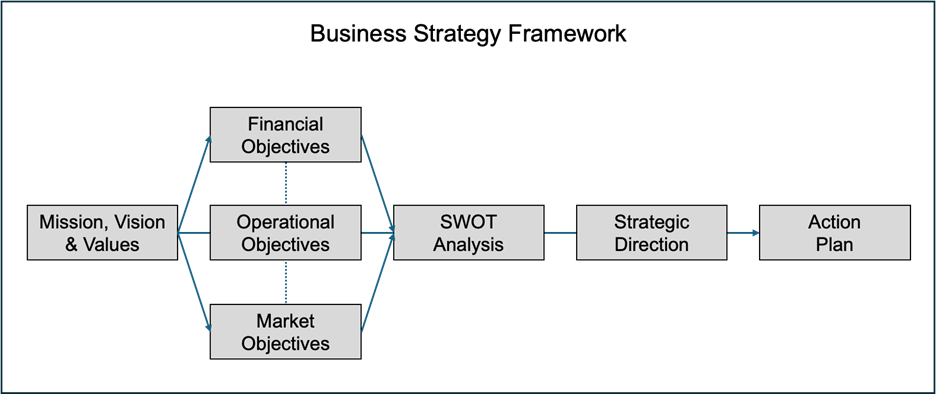
1. VISION, MISSION, AND VALUES
Establishing a shared mission and vision is crucial for any successful business strategy. Companies that clearly express their mission and vision tend to perform better and have a deeper understanding of their business’s key dynamics. This has been especially true over the past two decades—a period which has seen the notion of “purpose-driven business” (and brands) become mainstream.
Typically, a company’s mission is expressed through a concise statement. It defines the organization’s purpose or reason for existing (beyond making a profit). It outlines what the company does, who it serves, and how it creates value. It often focuses on the needs of customers, employees, and investors, incorporating core values like respect, enthusiasm, or environmental responsibility. When well-crafted, a mission statement should also provide a clear guide for the organization’s daily operations, decisions, and activities.
Conversely, a vision statement describes the desired future state of the organization — what the company aspires to achieve in the long term. It should serve as a source of inspiration and motivation for the organization, providing a long-term direction for the company. It helps align organizational efforts toward achieving a common goal.
When combined, mission and vision provide a high-level roadmap to achieve goals and objectives, and to help guide the strategic plan. While they are by no means static (they need to evolve with changing market dynamics and organizational needs), mission and vision also should not be changing on a frequent (e.g., quarterly or annual) basis.
Finally, values are the fundamental beliefs and guiding principles that dictate the behavior and decision-making of an organization. They establish a moral and ethical framework for employees and management, shaping the company culture and influencing decisions, actions, and strategies. In this sense, business have a core set of values in much the same way people do.
With these definitions in mind, it’s easy to see how a business strategy is often most aligned with vision, which includes the organization’s goals. However, both mission and values statements are fundamental in developing and sustaining an effective business strategy. And frequently, pursuing one helps a company achieve the other.
2. FINANCIAL OBJECTIVES
With high-level mission, vision and values established, it’s possible to define more specific, measurable, and time-bound business goals. Often, these goals are financial, operational, and market-based in nature.
To achieve long-term business success, it is essential to set clear financial objectives, including targets for revenue, earnings, and market value. Financial clarity typically involves minimizing volatility and risk and aiming for steady growth. It also seeks to increase economic profit and maintain investor loyalty.
Financial goals are usually concrete, but they can reflect diverse perspectives on strategy and the market environment. It’s important to remember that maximizing profit isn’t always the primary focus. For example, priorities may shift in response to competitive pressures, economic changes, and shareholder demands, thus placing other financial objectives above profit maximization. As such, high-performing companies often balance multiple financial objectives, each representing different aspects of the business, like capital, fixed assets, human resources, or product lines.
It is important to be realistic when setting financial objectives, taking into consideration available resources, competitive constraints, and market conditions. Financial objectives are often dynamic and interrelated, involving trade-offs between different priorities and changing over time. Frequently, past strategic choices influence current financial objectives, as companies operate within existing market segments, partnerships, and contractual commitments. Unsurprisingly, external conditions (e.g., economic, societal, market, competitive) shape financial goal-setting.
3. OPERATIONAL OBJECTIVES
Operational objectives, though often more specific and shorter-term, are crucial in providing the direction needed for long-term business success. Operations management typically encompass key areas such as materials, facilities, equipment, labor, and processes—all with an eye toward gaining a competitive edge.
As with financial, operational objectives should be specific, measurable, and timebound. Examples include optimizing HR processes, improving production output and quality, or enhancing IT and social media capabilities.
Although operational goals tend to focus on shorter-term outcomes—often measured against daily, weekly, or monthly benchmarks—they need to align with a cohesive mission and overarching operational strategy to be effective. As such, it’s important to break down higher-level objectives and strategies into actionable steps (a task that typically occurs later in the business strategy process). This makes operational objectives more tangible, measurable and achievable.
4. MARKET OBJECTIVES
Of the three types of objectives in this business strategy framework—financial, operational, and market—market objectives clearly have the greatest impact on brand strategy. Market objectives play a vital role in strengthening a company’s competitive position by enhancing customer value through better quality, superior functionality, lower costs, or wider distribution. To develop effective values-based strategies, businesses must understand what their customers and prospects truly value. And as will be demonstrated in the Workshop #2, understanding these critical customer values (along with their corresponding attitudes and behaviors) also helps shape the development of brand strategy, specifically, brand positioning.
The primary goal here should be to establish a long-term competitive position in the market. Most strategic objectives are designed to outperform competitors, with various routes to market dominance. Some companies focus on enhancing their reputation and customer engagement to foster long-term brand loyalty. Others may pursue growth through international expansion or innovation in products or services, emphasizing superior customer service and satisfaction.
Regardless of the approach, companies should prioritize delivering more value than their competitors and ensure their strategies are sustainable in the long-term. Importantly, given they are objectives like financial and operational, they should be specific, measurable, and timebound (even if some are not necessarily quantifiable).
5. SWOT ANALYSIS
Effective management involves planning, organizing, motivating, and controlling different business elements. SWOT analysis—which stands for strengths, weakness, opportunities, and threats—is a well-regarded tool that has proven effective in various contexts, particularly for business strategy development.
By its very nature, SWOT helps identify both the internal and external factors that impact a business. Internal factors include strengths, such as competitive advantages, and weaknesses, which represent areas needing improvement. External factors, like opportunities and threats, are often beyond an organization’s control but must be understood and addressed.
A SWOT analysis can be applied to an entire organization, a specific project, market segment, or even an individual. It aids in decision-making for both immediate challenges and long-term strategic plans. To be most effective, SWOT results should be analyzed from multiple perspectives, and across multiple departments and functions. SWOT analyses provide a clearer picture of the company’s current state and help it shape future strategic direction.
6. STRATEGIC DIRECTION
With business goals and objectives in place—and a solid understanding of strengths, weaknesses, opportunities and threats—we can turn our attention to developing strategic direction. This essentially is a high-level plan designed to achieve one or more long-term or overall objectives. The operative phrase here is “high-level,” which is what distinguishes it from the more detail-oriented action plan that takes place in the next and final step in the business strategy process.
Strategic direction provides a roadmap that guides decision-making and resource allocation. A strategy determines where the organization is heading and how it plans to get there by setting priorities and establishing a general approach or methodology. It typically involves choosing from one of several potential different directions or paths forward—namely the one believed to give the company the greatest likelihood of achieving long-term objectives. Specific tactics, initiatives, activities, etc. will naturally flow from the chosen strategic direction in the form of action plans.
7. ACTION PLANS
Action plans help identify and organize the steps necessary for achieving strategic objectives. Importantly, these action plans need to be closely aligned with the strategic direction previously determined.
Unsurprisingly, action plans differ greatly based on business type. For example, they may include supply chain logistics, storage, and distribution for companies that manufacture physical products, whereas this type of action plan is inappropriate (or at minimum, far less relevant) for a professional services firm.
Management plans usually encompass administrative tasks, employee management, and project timelines. Contingency plans are prepared to allow for unforeseen events, integrating realistic assumptions based on past experiences. Combining SWOT analysis with action plans can help businesses anticipate potential disruptions by identifying internal and external factors.
Overall, action plans serve as a blueprint for translating vision and strategy into reality, guiding businesses toward achieving their strategic objectives.

CASE STUDY: BUSINESS STRATEGY
The following provides an example of the above business strategy framework loosely populated for a real-world company: Tesla. There are two important caveats to keep in mind when reviewing this case study.

First, it is not official documentation from the company. Rather, it was “reverse-engineered” based on information available in the public domain. Stated differently, we are providing this more as an illustration than to provide a representation of Tesla’s actual business strategy.
Second, this illustration is intentionally high-level, brief and abbreviated. It uses a bullet point format rather than a lengthier and more formal “prose” format that is typically used by companies for strategic planning purposes. It also does not include quantifiable measures—which as we stated earlier is important—and the company’s actual business strategy surely does.
1. Vision, Mission, and Values
• Vision: To create the most compelling car company of the 21st century by driving the world’s transition to electric vehicles
• Mission: To accelerate the world’s transition to sustainable energy
• Values: Innovation, sustainability, and quality
2. Financial Objectives
• Achieve consistent profitability while investing in expansion (e.g., Gigafactories)
• Maintain a strong balance sheet to fund future innovations and expansions
• Grow revenue by increasing sales volumes and entering new markets (e.g., Asia, Europe)
3. Operational Objectives
• Scale production efficiently through the construction of Gigafactories
• Improve battery technology to lower costs and increase vehicle range
• Enhance the supply chain to ensure the availability of critical materials
4. Market Objectives (Creating Customer Value)
• Lead the market in electric vehicle sales by offering superior technology and customer experience
• Provide integrated energy solutions, such as solar panels and energy storage products, to broaden the company’s market reach
• Continuously innovate the product line, such as with the introduction of the Cybertruck, to appeal to a broader audience
5. SWOT Analysis
• Strengths: Strong brand recognition, innovative technology, first-mover advantage in the EV market, and vertical integration
• Weaknesses: High production costs, dependency on a single product line, and potential quality control issues
• Opportunities: Growing global demand for sustainable energy solutions, expansion into new geographic markets, and advancements in autonomous driving
• Threats: Increased competition from traditional automakers, regulatory changes, and supply chain disruptions
6. Strategic Direction
• Drive mass adoption of electric vehicles (EVs) globally
• Expand into renewable energy solutions for homes and businesses
• Continue to innovate in autonomous driving technology to lead in the self-driving car market
7. Action Plans
• Increase production capacity by building more Gigafactories globally, including in China and Germany
• Continue to invest in R&D for battery technology to reduce costs and improve vehicle performance
• Expand the product portfolio with new models and energy solutions, such as the Tesla Semi and solar roof tiles
• Strengthen the direct-to-consumer sales model by expanding the Tesla Store network and enhancing the online purchasing experience
• Accelerate the deployment of the Full Self-Driving (FSD) software to lead the autonomous vehicle market

EXERCISE 1.8: BUSINESS STRATEGY PRIMER
1) Mission, Vision, Values
• To the best of your ability, please articulate what you believe to be your company’s mission
2) Financial Objectives
• Can you cite one or more financial objectives for your company (and/or specific brands) within this fiscal year?
3) Operational Objectives
• What is your company seeking to accomplish operationally to achieve a competitive advantage in the market?
4) Market Objectives
• In what way(s) does your company (and/or individual brands) create value for its customers or consumers?
5) SWOT Analysis
• How would you articulate your company’s unique strengths? What weaknesses need to be overcome?
6) Strategic Direction
• What is one specific strategy the company (or brand) is pursuing to achieve business objectives?
7) Action Plans
• What is the single most important initiative this fiscal year for fulfilling the above strategic direction and accomplishing business and financial objectives?

Course Manual 11: Brand Assessment
The purpose of this course module is to apply the knowledge and information we’ve covered in previous modules to assess the current state of your brand relative to business strategy. Said differently, you’ll apply what you learned about “brand” (i.e., modules 1-9) to assess your brand’s fit with business strategy (i.e., module 10). Please note that although both the business strategy framework and brand strategy framework are introduced in the previous and current course modules, respectively—neither framework will be formally completed by your team until after the workshop.
As a reminder, below is the framework we just reviewed for business strategy. The content that follows demonstrates how you can evaluate the current state of your brand within the context of the seven components of the business strategy framework.
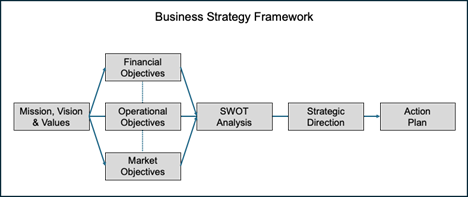
As you go through this exercise, please realize that not every question and consideration will be relevant to your specific company, brand, and situation. They are meant to be illustrative and high-level so they can accommodate as broad an array of businesses and industries as possible. As such, they should be used, adapted, or omitted accordingly to better serve your company’s and brand’s specific needs.
1. MISSION, VISION, AND VALUES ALIGNMENT
Cultural Fit: Assess the extent to which the brand is embedded in the internal culture of the company.
Employee Advocacy: Evaluate whether employees, from frontline staff to executives, authentically embody and advocate for the brand’s values and purpose.
Consistency Across Touchpoints: Examine whether the mission, vision, and values are consistently communicated and experienced across brand touchpoints (e.g., customer service, product design, digital presence).
Illustrative Questions to Consider:
• How does the brand influence decision-making, behavior, and communication within the organization (if at all)?
• Are internal stakeholders (employees, leadership, partners) well-versed in the brand’s connection to the mission and values? Can they articulate this connection clearly?
• How is the brand’s purpose operationalized in daily business decisions, employee behavior, and customer interactions?
• Do internal training programs and performance management systems reinforce brand-aligned behavior, or is there a gap between what the brand promises and how employees deliver it?
• How well do the brand’s core values translate into specific customer experiences? Are the promises of inclusivity, sustainability, or quality upheld in every customer interaction?
• How well does the brand balance the need to reflect core values with adapting to different cultural contexts in diverse markets?
2. Financial Objectives Alignment
Revenue Mix and Profitability: Consider how the brand influences product or service pricing, cost structure, and revenue models.
Long-Term Financial Sustainability: Evaluate whether the brand’s value proposition supports long-term financial sustainability or if it forces the company into costly, short-term tactics like heavy discounting or expensive customer acquisition campaigns.
Investor Perception: Assess whether the brand positioning enhances or detracts from the company’s attractiveness to investors.
Illustrative Questions to Consider:
• Does the brand allow for premium pricing, or does it force reliance on volume-based strategies?
• Does the brand strategy contribute to long-term shareholder value, or is it viewed as too risky or overly niche?
• Does the brand provide a framework for effectively managing price elasticity? How does the brand’s positioning influence customers’ willingness to pay?
• Are there identifiable revenue streams or profit centers directly attributable to the brand strategy (e.g., loyalty programs, subscription models, or partnerships)?
• How does the brand influence the company’s ability to manage costs (e.g., lower marketing spend through strong organic reach, reduced customer churn, or operational efficiencies)?
• Does the brand appeal to investor sentiment? For example, does the brand’s focus on innovation or sustainability improve access to capital or favorable financial terms?
• How does the brand handle economic downturns or shifts in customer purchasing power without eroding profitability?
3. Operational Objectives Alignment
Operational Scalability: Assess whether the brand supports scalability.
Supply Chain Integration: Evaluate how well the brand integrates with supply chain strategies.
Technology and Innovation Alignment: Examine whether the brand is supported by the company’s technology infrastructure and innovation agenda.
Illustrative Questions to Consider:
• Is the company’s operational infrastructure flexible enough to uphold the brand promise during periods of growth or market expansion?
• Is the supply chain capable of delivering the brand’s promise (e.g., ethical sourcing, fast delivery)?
• Can the operational capacity support the brand’s growth ambitions without sacrificing quality or customer experience? How does the brand influence operational decision-making during periods of rapid scaling?
• Are operational investments in technology aligned with the brand’s promises around customer experience, personalization, or speed?
• Are the brand’s sustainability or ethical claims backed by verifiable and transparent supply chain practices? How is this monitored and communicated to customers?
• How does the brand enable or constrain operational innovation? For example, does the brand demand costly customization, or does it allow for standardization that supports operational efficiency?
• Does the brand compel the organization to adopt new technologies (e.g., AI-driven personalization, blockchain for transparency) to deliver on its promises?
• How do operational KPIs (e.g., delivery times, customer service response, defect rates) reflect the brand’s core promise to customers?
4. MARKETING OBJECTIVES ALIGNMENT
Customer Journey Mapping: Assess the extent to which the brand shapes the customer journey.
Segmentation and Personalization: Evaluate the brand’s effectiveness in enabling highly targeted segmentation and personalization.
Customer Lifetime Value (CLV): Measure how the brand drives customer lifetime value by encouraging repeat purchases, fostering loyalty, or facilitating cross-selling.
Illustrative Questions to Consider:
• How are key touchpoints along the customer journey branded, and how does that branding influence customer behavior?
• Does the brand resonate with distinct customer segments while maintaining coherence across the broader audience?
• How does the brand shape marketing tactics such as content strategy, ad creative, or social media engagement? Are these aligned with the broader marketing goals of customer acquisition and retention?
• Does the brand facilitate differentiation in competitive markets? How does it help the company stand out in a crowded marketplace while appealing to the target customer base?
• How are data-driven insights about customer behavior integrated into the brand strategy? Does the brand provide actionable data for refining marketing campaigns?
• Are customer retention strategies (e.g., loyalty programs, rewards, memberships) aligned with the brand’s value proposition, or are they at odds with customer expectations?
• How effectively does the brand build long-term emotional connections with customers, beyond transactional engagement?
5. SWOT ANALYSIS ALIGNMENT
Strength Exploitation: Assess the brand’s ability to fully exploit the company’s competitive strengths.
Weakness Mitigation: Evaluate whether the brand strategy actively addresses or compensates for the company’s weaknesses, or if it exacerbates them by creating false perceptions.
Threat Response: Analyze how well the brand is equipped to respond to external threats such as changing regulations, new competitors, or shifting consumer behaviors.
Opportunity Preparedness: Determine the extent to which the brand in a position to capture market opportunities as they arise.
Illustrative Questions to Consider:
• Does the brand overemphasize weaker areas while under-leveraging stronger ones?
• Does the brand clearly communicate and leverage the company’s core competencies, such as unique technologies, patents, or superior service levels?
• How does the brand minimize the impact of the company’s weaknesses? Does it strategically de-emphasize areas where the company may struggle (e.g., lack of digital presence) while amplifying strengths?
• How is the brand prepared to respond to market disruptions (e.g., new competitors, regulatory changes)? Does it allow for agile responses, or is it too rigid?
• Are there hidden strengths that the brand is underutilizing? For instance, could the brand better leverage its customer base for advocacy or innovation?
• How does the brand insulate the company from emerging threats, and are there preemptive actions in place to address them?
6. STRATEGIC DIRECTION ALIGNMENT
Alignment with Long-Term Strategy: Examine how well the brand facilitates the long-term strategic goals of the company, such as becoming an industry leader or expanding into new product categories or geographies.
M&A Impact: If mergers and acquisitions are part of the strategy, assess how well the brand can absorb or coexist with acquired brands.
Competitive Advantage Sustainability: Evaluate how well the brand ensures the sustainability of competitive advantages over time.
Illustrative Questions to Consider:
• Can the brand strategy accommodate multiple entities, or will it create confusion and dilution?
• How does the brand enable the company to achieve its strategic goals in terms of market leadership, product diversification, or global expansion?
• Does the brand strategy provide a clear and consistent framework for evaluating potential mergers and acquisitions? Will it absorb other brands effectively without losing its own identity?
• How does the brand maintain and reinforce the company’s competitive advantages over time? For instance, does it allow for continuous innovation or market repositioning in response to industry changes?
• Are there strategic blind spots where the brand fails to support long-term goals, such as underestimating the need for agility or failing to capture new market trends?
• Does the brand actively drive the organization toward future-focused goals, or is it overly anchored in the present or past?
7. ACTION PLAN ALIGNMENT
Operational Readiness: Assess the operational readiness of the brand to support detailed action plans.
Cross-Departmental Integration: Evaluate how well the brand strategy is integrated across departments such as sales, marketing, operations, and customer service.
Agility and Responsiveness: Test how agile the brand is in adapting to new or changing action plans.
Illustrative Questions to Consider:
• Can the brand scale, adapt, or shift in response to evolving operational demands without diluting its identity?
• Are the brand’s tactical initiatives (e.g., marketing campaigns, product launches) in line with the company’s strategic priorities? Are these initiatives well-sequenced to avoid brand fatigue or misalignment?
• How well does the brand guide cross-departmental action plans? Is the brand a central pillar that informs decisions across sales, operations, HR, and customer service?
• How does the brand contribute to the successful implementation of short-term and long-term action plans? For instance, does the brand strategy accelerate market entry or help to streamline product launches?
• Can the brand quickly pivot without losing coherence in response to market shifts or organizational changes?
• How effectively can the brand adapt to unforeseen disruptions in the action plan, such as supply chain delays, shifts in consumer demand, or regulatory changes?
• Are there sufficient resources allocated to ensuring the brand remains strong and consistent through the execution of each stage of the action plan?

CASE STUDY: BRAND ASSESSMENT (vs. BUSINESS STRATEGY)
Perhaps the best way to demonstrate how to assess brand alignment with business strategy is through a case study. Below is an illustrative (and reverse-engineered) application of how one might evaluate Amazon’s brand against its business strategy.

1. MISSION/VISION/VALUES
• Amazon’s Mission: “To be Earth’s most customer-centric company, where customers can find and discover anything they might want to buy online, and endeavors to offer its customers the lowest possible prices”
• Vision: “To be Earth’s best employer and Earth’s safest place to work”
• Values: Innovation, customer obsession, operational excellence, and long-term thinking
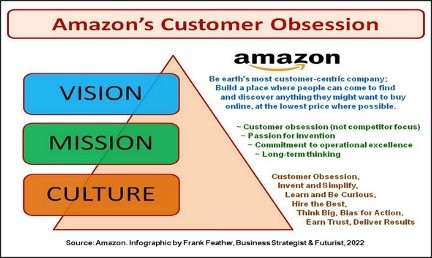
Brand Fit:
• Amazon’s brand centers around convenience, innovation, and customer-centricity. The company’s mission to offer a vast selection of products at competitive prices strongly aligns with this brand promise. The focus on customer obsession aligns with the mission and vision, emphasizing convenience and satisfaction
• Amazon’s vision statement, emphasizing being the best employer and safest workplace, complements the internal cultural values. Although this is more internally focused, it contributes to building the brand as an ethical and responsible company, which can foster trust in the marketplace
Overall Assessment:
• Strong Fit: The mission and vision clearly reflect Amazon’s brand essence, focusing on customer satisfaction, innovation, and operational superiority. However, the emphasis on being the best employer introduces new values that have yet to be fully reflected in Amazon’s external brand narrative
2. FINANCIAL OBJECTIVES
• Amazon’s financial objectives are centered on revenue growth, profitability, and increasing shareholder value. The company consistently focuses on reinvesting earnings into strategic areas such as cloud computing, logistics, and entertainment
Brand Fit:
• Amazon’s brand is tied to scalability, reinvestment, and innovation. The aggressive pursuit of financial objectives through acquisitions, infrastructure development (such as AWS), and investment in new markets aligns with its brand image of being forward-thinking and expansive
• The brand’s commitment to delivering value to customers aligns with its financial objectives by focusing on driving efficiencies to maintain low prices and customer satisfaction, ultimately boosting financial performance
Overall Assessment:
• Strong Fit: Amazon’s brand complements its financial objectives, reinforcing its identity as a financially disciplined, growth-oriented, and innovative company
3. OPERATIONAL OBJECTIVES
• Amazon aims for operational efficiency, innovation in logistics (e.g., drone delivery, automation), and expansion of its fulfillment network to improve delivery times and reduce costs. AWS also plays a key role in operational objectives, driving scalability
Brand Fit:
• Amazon’s operational objectives directly support its brand promise of delivering fast, reliable service and unparalleled convenience. The operational focus on efficiency and scalability is well-aligned with its brand, as these elements are critical to maintaining Amazon’s competitive edge in e-commerce and cloud computing
• Innovations like same-day delivery and seamless technology integrations (e.g., Alexa, automation) enhance the brand’s image as a tech-forward, customer-focused leader in retail and cloud services
Overall Assessment:
• Strong Fit: Amazon’s operational excellence is a core part of its brand. Continuous improvements in logistics, technology, and scalability strongly reinforce its brand position as the most convenient and customer-focused retailer
4. MARKETING OBJECTIVES
• Amazon’s marketing objectives focus on increasing market share, enhancing customer loyalty (Prime membership), expanding globally, and leveraging personalized marketing. The company prioritizes data-driven marketing, product recommendations, and cross-selling opportunities
Brand Fit:
• Amazon’s marketing strategy is highly aligned with its brand identity of customer obsession and innovation. Prime membership, for instance, enhances brand loyalty by offering exclusive benefits that reinforce the customer-centric narrative.
• The use of data analytics to personalize marketing communications aligns with the brand’s promise of innovation, as it delivers tailored experiences for consumers, thereby deepening customer relationships
Overall Assessment:
• Strong Fit: Amazon’s marketing objectives bolster its brand identity by focusing on customer retention, data-driven personalization, and expanding its global reach. This approach solidifies its brand’s association with convenience and personalization
5. SWOT ANALYSIS
• Strengths: Global brand recognition, technological innovation (AWS, Alexa), dominant e-commerce platform, logistics capabilities, customer loyalty (Prime).
• Weaknesses: Labor practices criticisms, reliance on third-party sellers, regulatory scrutiny
• Opportunities: Expansion into new markets (healthcare, autonomous tech), further leveraging AI, sustainability initiatives
• Threats: Growing regulatory pressures, competition from other tech giants, public perception of labor conditions, cybersecurity risks
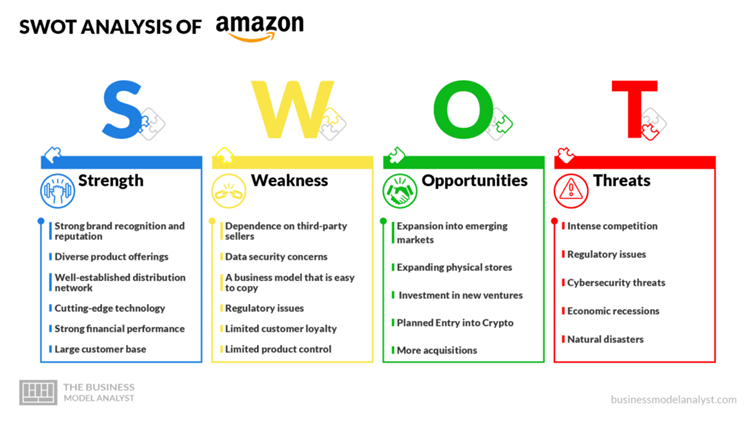
Brand Fit:
• Amazon’s strengths strongly align with its brand. Its innovations in technology, logistics, and customer experience underscore its market dominance and brand reputation
• Weaknesses, particularly concerning labor practices, pose risks to its brand reputation as a customer-centric and ethical company. The brand’s emphasis on operational efficiency can clash with public perception of its treatment of employees
• Opportunities for expansion into new industries and sustainability efforts could enhance Amazon’s brand, especially if the company improves its public image regarding ethical business practices
Overall Assessment:
• Moderate Fit: While Amazon’s strengths align well with its brand, weaknesses, especially those related to labor practices and regulatory scrutiny, could pose challenges to brand integrity. However, opportunities in emerging technologies and sustainability efforts could enhance its brand positioning
6. STRATEGIC DIRECTION
• Amazon’s strategic objectives focus on expanding AWS dominance, enhancing Prime membership benefits, expanding into new markets like healthcare, and increasing automation and AI-driven capabilities
Brand Fit:
• These strategic objectives are well-aligned with Amazon’s brand promise of innovation and convenience. AWS plays a crucial role in driving scalability and innovation, while enhancing Prime membership reinforces customer loyalty. Expansion into new sectors like healthcare extends Amazon’s reputation as a disruptor and innovator
• Increased automation and AI capabilities align with the brand’s commitment to operational excellence and customer-centricity, though there is potential tension with its employee-centric vision if automation leads to workforce displacement
Overall Assessment:
• Strong Fit: Amazon’s strategic objectives reflect its brand’s core themes of innovation, expansion, and customer focus. The alignment of its growth strategies with its brand identity is clear, though potential risks exist in balancing automation with its employee vision
7. ACTION PLAN
• Amazon’s action plan includes scaling its cloud services (AWS), enhancing logistics and fulfillment, expanding product and service offerings (e.g., in healthcare), and integrating advanced technologies (AI, automation) across its operations
Brand Fit:
• Amazon’s action plan supports its brand image by reinforcing its leadership in technology, scalability, and customer experience. Expanding AWS and enhancing logistics are key pillars of the action plan that directly support the company’s brand promise of convenience and innovation
• Expanding into new product categories and services also reinforces the brand’s commitment to offering everything customers need. However, the action plan needs to carefully address issues around employee treatment to fully align with Amazon’s stated vision of being the best employer
Overall Assessment:
• Strong Fit: Amazon’s action plan effectively supports its brand strategy of leadership in customer experience, innovation, and convenience. There is, however, room to improve alignment with its internal brand narrative focused on employee well-being
In general, Amazon’s brand and business strategy exhibit a strong strategic fit across most dimensions. The company’s focus on customer obsession, innovation, operational excellence, and growth aligns seamlessly with its business objectives and operational goals. However, areas like labor practices and employee well-being introduce potential friction between Amazon’s internal brand values and its external brand perception. As Amazon continues to expand and evolve, it will need to address these areas to ensure full alignment between its strategic objectives and its brand promise.

EXERCISE 1.9: BRAND ASSESSMENT
1) Mission/Vision/Values _____
2) Financial Objectives _____
3) Operational Objectives _____
4) Marketing Objectives _____
5) SWOT Analysis _____
6) Strategic Direction _____
7) Action Plan _____

Course Manual 12: Knowledge Base
In Workshop #2, you will be developing a brand positioning for your brand. This exercise may (or may not) require conducting new primary market research. The type of research that can be conducted—and a plan for conducting it—will be the subject of Workshop #3 on Market Intelligence.
Ultimately, the decision on whether to conduct new primary market research following Workshop #3 depends on two things: 1) the nature and depth of your existing information and 2) your company’s risk tolerance when it comes to decision-making. Simply put, some companies require a higher burden of proof (i.e., market validation) when finalizing strategy. Those are the companies that will likely opt to conduct new primary market research prior to finalizing their brand positioning.
The reason for waiting until after Workshop #3 to potentially conduct new market research is so you can first see what brand positioning entails prior to determining whether new primary market research is warranted or required. Please see below for Phase 1 Process Flow.
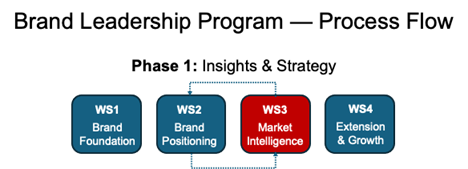
Prior to making that important decision, it also makes sense to take inventory of your existing knowledge base. It’s quite possible that any information gaps you may identify in the next workshop can be addressed through information resources that exist in your organization, or that can be easily and affordably acquired from third-party suppliers.
Given locating (or potentially purchasing) some of these data sources may require time and effort, we’re introducing this course module now, so you have time to secure them following this workshop, and you will have them at your disposable for Workshops #2 and #3.
The exhibit below highlights the type of market intelligence we’ll be reviewing in this course module, and that you will be asked to locate or source following this workshop.
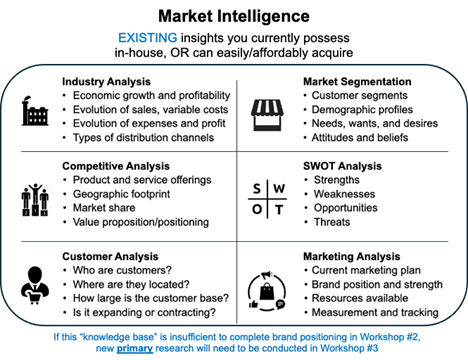
It is also important to point out that information sources that are identified at this point (whether existing inhouse or purchased externally) may have a useful life beyond brand positioning. Specifically, numerous workshops in the second and third phases of the Brand Leadership program (i.e., Phase 2—Expression & Experience and Phase 3—Operationalization & Oversight) may also benefit from the sources uncovered (or acquired) now.
The remainder of this module will illustrate the two broad categories of sourcing information mentioned above: 1) existing intelligence contained in-house), and 2) data and information that can be purchased at relatively low cost from external suppliers.
Regardless, the content that follows is purely illustrative and meant to stimulate your thinking. The appropriateness of these potential resources obviously varies greatly by your type of business (e.g., industry sectors, product categories).
LEVERAGING EXISTING IN-HOUSE RESOURCES
1. Brand Guidelines and Internal Documents
Brand guidelines and internal documents are foundational for crafting a brand positioning strategy. These documents define the core identity of the brand, including its mission, values, and personality. A brand positioning strategy must be aligned with these guidelines to ensure consistency in how the brand is perceived by its target audience. For example, if the brand emphasizes innovation, the positioning should highlight this in all communications, making it a key differentiator. By leveraging brand guidelines, companies can ensure that every marketing effort, from visual elements to messaging, reflects the desired position in the marketplace. Internal documents also offer insights into the brand’s cultural foundations, ensuring the positioning aligns with the internal ethos. In essence, brand guidelines serve as a blueprint for positioning, helping create a distinct and consistent brand identity that resonates with both customers and employees.
2. Sales and Market Performance Data
Sales and market performance data provide valuable insights into how well the brand resonates with its target audience, directly informing brand positioning strategy. By analyzing which products or services are selling the most, companies can understand which aspects of the brand are currently the most compelling to customers. If certain regions or segments show higher performance, this data can guide more targeted positioning efforts. For instance, if sales data shows strong performance in sustainability-related products, the brand could position itself as a leader in eco-consciousness. Market performance data also reveals how the brand compares to competitors, helping refine positioning to highlight areas where the brand outperforms or offers unique value. By understanding customer preferences and market trends through sales data, brands can craft a positioning strategy that reflects their strengths and differentiates them from competitors.
3. Customer and Consumer Data
Customer and consumer data are essential for developing a brand positioning strategy that deeply resonates with the target audience. By understanding customer demographics, behaviors, and preferences, brands can tailor their positioning to align with the values and needs of their ideal customer base. For example, if the data reveals that customers are primarily motivated by affordability, the brand can position itself as offering the best value in the market. Similarly, understanding consumer lifestyles and psychographics can help in creating a more emotional or aspirational positioning. This data also informs segmentation strategies, allowing for more precise positioning efforts that cater to distinct customer groups. Ultimately, leveraging customer and consumer data ensures that the brand is positioned in a way that is both relevant and compelling to its audience, enhancing brand loyalty and market penetration.
4. Competitor Analysis and Market Intelligence
Competitor analysis and market intelligence provide crucial insights for positioning a brand uniquely in the marketplace. By analyzing competitors’ strategies, strengths, and weaknesses, companies can identify gaps or opportunities that the brand can exploit. For example, if competitors are all emphasizing product quality, a brand may choose to position itself based on superior customer service or innovation. Market intelligence, including emerging trends and technological advancements, also informs positioning by identifying future opportunities or threats. This ensures that the brand is not only differentiated from current competitors but is also future-proofed against evolving market dynamics. By leveraging both competitor analysis and market intelligence, brands can craft a positioning strategy that sets them apart and anticipates shifts in consumer expectations or competitive pressures.
5. Financial Data and Brand P&L Statements
Financial data, including brand P&L (Profit and Loss) statements, play a critical role in shaping a brand positioning strategy by revealing the financial viability of different brand strategies. For instance, analyzing the profitability of different product lines can highlight areas where the brand may want to focus its positioning efforts. A highly profitable product might be central to the brand’s positioning, while underperforming products may prompt a repositioning to improve market perception. Additionally, understanding the costs associated with marketing and branding efforts can inform whether certain positioning strategies are sustainable. For example, if the brand’s financial data reveals high marketing costs with low returns, a repositioning may be necessary to better communicate the brand’s value proposition. By aligning financial objectives with brand positioning, companies can ensure that their branding efforts not only resonate with customers but also contribute to long-term profitability.
6. Marketing and Communication Assets
Marketing and communication assets are the practical tools through which a brand’s positioning strategy is brought to life. These assets—ads, social media content, websites, and more—must consistently reflect the desired brand position in both messaging and design. For example, if a brand is positioned as a luxury option, the marketing materials must reflect high-end imagery, sophisticated language, and premium storytelling. Additionally, these assets offer real-time feedback on how well the brand’s positioning is resonating with the target audience, based on customer engagement and conversion rates. By continuously aligning marketing assets with the positioning strategy, brands can reinforce their market position and build stronger connections with their audience. Ensuring that communication assets align with brand positioning is key to maintaining coherence across all customer touchpoints.
7. Employee Insights
Employee insights are invaluable for ensuring that internal culture aligns with external brand positioning. Employees are often the first touchpoint for customers, especially in service industries, and their behavior directly impacts how the brand is perceived. If employees feel connected to the brand’s mission and values, they are more likely to embody those principles in their interactions with customers, reinforcing the brand’s positioning. For example, if a brand positions itself as customer-centric, employee insights can reveal whether staff feel empowered and trained to deliver on that promise. By leveraging employee insights, companies can refine their internal processes to ensure that employees act as true ambassadors of the brand, creating a consistent and authentic customer experience that aligns with the brand’s market position.
8. Digital Analytics and Social Listening
Digital analytics and social listening provide real-time feedback on how the brand’s positioning resonates with its online audience. Metrics such as website traffic, social media engagement, and customer sentiment offer valuable insights into how well the brand’s messaging and positioning are being received. For example, if social listening tools reveal that customers frequently associate the brand with innovation, the company can double down on this positioning in its marketing efforts. Conversely, if negative sentiment arises around a particular aspect of the brand, digital analytics can signal a need for repositioning. By closely monitoring digital and social channels, brands can adapt their positioning in real-time to reflect customer expectations and emerging market trends, ensuring that they remain relevant and compelling.
9. Historical Customer Feedback and Research
Historical customer feedback and research provide a wealth of information that can help refine brand positioning over time. By analyzing patterns in customer complaints, praise, or requests, companies can adjust their positioning to better align with customer needs and expectations. For instance, if feedback consistently praises a brand’s product durability, the company may want to position itself as a leader in long-lasting, high-quality products. Similarly, historical research may reveal changing customer preferences, allowing the brand to proactively adjust its positioning to stay ahead of market trends. This data helps ensure that the brand’s position is not only relevant to current customers but also anticipates future shifts in consumer sentiment. Continuous analysis of customer feedback helps brands fine-tune their positioning to maintain customer satisfaction and loyalty.
10. Product Development and Innovation Insights
Product development and innovation insights are crucial for positioning a brand as forward-thinking and responsive to customer needs. These insights come from market research, customer input, and competitor analysis, revealing opportunities for new products or product improvements. By integrating innovation into its brand positioning, a company can differentiate itself as a leader in its category. For example, if the brand consistently develops cutting-edge technology or eco-friendly solutions, it can position itself as an innovator or a sustainability champion. Innovation insights also help in repositioning if market demands shift. For example, if new competitors emerge with superior features, innovation can allow the brand to pivot and reclaim its competitive advantage. Using product development insights to inform brand positioning ensures that the brand remains dynamic, relevant, and aligned with consumer needs.
(POTENTIALLY) ACQUIRING LOW-COST SECONDARY DATA & RESEARCH
The following resources can prove to be invaluable not only for completing brand positioning in Workshop #2, but also for upcoming workshops throughout the remainder of this program. If this is the case, it may be beneficial to acquire some of these resources given the extent to which they may be leveraged for multiple upcoming decisions.
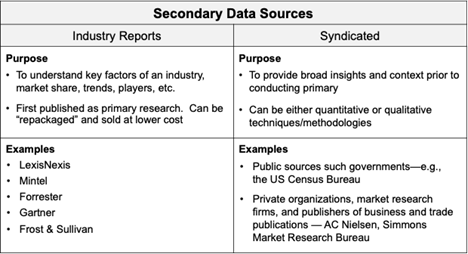
1. Market Research Reports
Comprehensive overviews of specific industries, including market size, growth forecasts, key players, and competitive dynamics. Even though these tend to be high-level, and not necessarily specific to your company, they can still be valuable.
• Key Providers: Mintel, Euromonitor International, IBISWorld, MarketResearch.com, Nielsen, Kantar
• Potential Application:
o Market Positioning: Understand where the brand fits within the broader market landscape and identify opportunities for growth or repositioning
o Competitive Landscape: Gain insights into competitors and emerging market trends that could impact brand strategy
2. Consumer Insights Reports
Detailed data on consumer preferences, behaviors, attitudes, and trends across different demographics. Much of this is syndicated data, which is market research that is collected and sold by third-party companies to multiple clients.
• Key Providers: Nielsen, GfK, Ipsos, YouGov, Pew Research Center
• Potential Application:
o Align with Consumer Trends: Adjust brand positioning and messaging to better resonate with target consumer segments
o Identify Segment Opportunities: Discover new consumer segments or underserved needs that the brand could address
3. Brand Equity and Value Reports
Rankings and assessments of brand strength, equity, and value across various industries. This can help assess not only your own company’s position, but those of your key competitors.
• Key Providers: Interbrand (Best Global Brands), BrandZ (Kantar), Brand Finance, Forbes
• Potential Application:
o Benchmark Against Competitors: Understand how the brand compares in terms of equity and value and identify areas for improvement
o Strengthen Brand Position: Use insights to enhance brand strength through targeted marketing or strategic adjustments
4. Category and Industry Trend Reports
Current trends, drivers, and consumer behaviors within specific product categories or industries. This information can be particularly helpful in rounding-out understanding of your business strategy.
• Key Providers: McKinsey & Company, Deloitte Insights, PwC, BCG, Accenture, Statista
• Potential Application:
o Stay Ahead of Trends: Anticipate changes in the market and adjust the brand portfolio strategy accordingly
o Identify Growth Areas: Spot emerging trends that could represent opportunities for new brand positioning or product launches
5. Competitive Analysis Reports
Detailed analyses of competitors’ market share, positioning, and strategic moves. This information—especially to the extent it includes perspectives on brand positioning—is clearly beneficial for brand strategy.
• Key Providers: Euromonitor International, Nielsen, MarketLine, IBISWorld
• Potential Application:
o Understand Competitive Position: Compare brand performance against competitors to identify gaps or opportunities (e.g., Perceptual Maps)
o Refine Differentiation Strategy: Use insights to better differentiate the brand from competitors
6. Digital and Social Media Analytics Reports
Data on digital marketing performance, social media engagement, and online brand sentiment. This type of data will likely be more beneficial for upcoming workshops (digital marketing, artificial intelligence, content marketing and social media).
• Key Providers: SimilarWeb, Hootsuite, Sprout Social, Socialbakers, eMarketer
• Potential Application:
o Improve Digital Presence: Enhance brand visibility and engagement through digital channels
o Monitor Brand Health: Track online sentiment to understand consumer perceptions and address issues in real-time
7. Customer Loyalty and Engagement Reports
Insights into customer loyalty, engagement levels, and satisfaction metrics. This type of information is particularly helpful when it comes to assessing individual brands’ positioning.
• Key Providers: JD Power, Forrester Research, Bain & Company
• Potential Application:
o Improve Customer Retention: Focus on improving customer loyalty by understanding the drivers of satisfaction and loyalty
o Refine Targeting: Identify key drivers of engagement for different segments to refine targeting strategies
8. Retail and Channel Performance Reports
Data on retail trends, channel performance, and shopper insights. These sources are potentially applicable to the market assessment portion of business strategy.
• Key Providers: Nielsen, IRI, NPD Group, Euromonitor International.
• Potential Application:
o Optimize Channel Strategy: Adjust distribution and channel strategies based on performance insights
o Understand Shopper Behavior: Align brand strategies with consumer shopping preferences and behaviors
9. Innovation and Product Development Reports
Insights on product innovation trends, new product launches, and consumer adoption rates. These resources are slightly further removed from traditional brand strategy, however they may prove useful to leverage in Workshop #3 (Brand Extendibility and Growth Strategy).
• Key Providers: Mintel (Global New Products Database), Nielsen BASES, Kantar Worldpanel
• Potential Application:
o Drive Innovation: Identify opportunities for product innovation aligned with brand strategy
o Support Brand Positioning: Ensure new product developments align with the desired brand image and positioning
10. Macroeconomic and Demographic Reports
Macro-level data on economic conditions, demographic changes, and consumer spending. These sources pertain mostly to the business strategy portion of this workshop exercise.
• Key Providers: IMF, World Bank, OECD, U.S. Census Bureau, Eurostat
• Potential Application:
o Align with Broader Trends: Adjust brand strategy to align with macroeconomic conditions or demographic shifts
o Plan for Market Expansion: Use insights to support market entry or expansion decisions
11. Sustainability and ESG Reports
Information on sustainability trends, ESG practices, and benchmarks within industries. These can be potentially helpful for upcoming workshops on brand positioning strategy.
• Key Providers: MSCI ESG Research, Sustainalytics, CDP (Carbon Disclosure Project)
• Potential Application:
o Enhance Brand Value: Strengthen brand positioning by aligning with sustainability and ESG trends
o Meet Consumer Expectations: Ensure brand strategies align with consumer demand for responsible and sustainable practices

EXERCISE 1.10: ASSESSING YOUR KNOWLEDGE BASE
• Internal and external (third-party) sources
• Primary and secondary research
• Qualitative and quantitative data/information
• The ability to inform not only brand portfolio strategy, but also future workshops in the Brand Leadership program
Project Studies
Below is a list of action items and outputs that will be required to be completed prior to the start of Workshop #2. Completing these activities is important to ensure that future workshops are as productive as can be, and that a solid foundation is set for the remainder of the Brand Leadership program. The activities very closely align with this workshop’s course modules, so please make sure to refer to them to refresh your memory on the content.
#1: Team Members and Roles
Participants should identify the team composition for this program and secure their participation, if that has not already been done. As a rule of thumb, modest-sized teams (~3-6) people work best. If the team is too large, confusion and inefficiencies will occur. If the team is too small, they may struggle to get work done and to make important decisions on a timely basis. Additionally, in assembling the optimal team, consideration should be given to functional, level, and BU dynamics.
From a functional perspective, Marketing/Brand obviously needs representation. It may also be helpful to include someone with a Marketing Research/Insights background, if possible. Beyond that, it is up to the organization as to what other functions would be helpful (Finance, Operations, HR, etc.)
In terms of hierarchy/level, it’s important to include team members who have decision-making authority. Following virtually every workshop, decisions will need to be made on the path forward. Conversely, it’s also important to have team members who are more junior or mid-level, and who have the bandwidth to work on this program and complete exercises between workshops.
Depending on the nature of your business, thought also should be given to the BUs or divisions that need representation in this work. The easiest way to make this determination is to think about the breadth of your brand and the extent to which it impacts different business entities.
Finally, once the team has been identified, please assign specific roles and responsibilities to each team member (input, participation, decision-making, etc.). This should help to avoid confusion and misunderstandings down the road.
#2: Brand Definition
Course Module 2 presented 10 different lenses through which to define your brand. Now we’d like you to define YOUR brand through each lens. Please take some time to consider “definitions” for your brand through these various lenses, referring to the course module to refresh your memory on each concept.
• Brand as an identifier _____
• Brand as a perception _____
• Brand as an emotional connection _____
• Brand as a marketing tool _____
• Brand as a cultural construct _____
• Brand as an asset _____
• Brand as a customer experience _____
• Brand as a trademark _____
• Brand as a relationship _____
• Brand as a personal identifier _n/a_
#3: Brand Architecture
Course Module 8 is on brand architecture, which defines the relationship brands within a portfolio have with one another (especially the master brand). If you were unable to complete the exercise during the workshop, we’d like you to do so now. The exercise is repeated below for your convenience.
• Where on the brand portfolio structure continuum does your company reside (Branded House, House of Brands, Hybrid)? If Hybrid, which of the two other options does it more closely resemble?
• Given the principles discussed in this course module, do you think your current structure is optimal? Why or why not? If not, how could it potentially be improved? Please consider the following criteria when making this evaluation:
o Customer segments
o Breadth/range of offer
o Relevance of corporate brand
o Investment in branding
o Brand management competency
#4: Market Definition
Course Module 9 introduced three components that, at least in part, define the market in which the brand is deployed. The three components that typically comprise a market include: product/service categories, consumer/customer segments (or potentially industry verticals in B2B), and geographic regions. Please complete the following exercise for the brand that will be the subject of this program. Refer to Course Module 9 for definitions and examples of these components.
#5: Business Strategy
A critical activity following this first workshop is to articulate business strategy, which was the subject of Course Module 10. As mentioned during the session, the brand strategy we eventually develop must be inextricably linked to the business strategy it is intended to serve.
Also, as referenced during the workshop, hopefully there already is a business strategy in place that can be leveraged for our purposes. Assuming this is true, all that is required here is to extract the relevant portions of the strategy and populate our seven-component framework with its content.
To refresh your memory, please make sure to refer to the course module for definitions of the seven components, and for an illustrative case study that demonstrates its application.
#6: Brand Assessment
Course Module 11 illustrated how to evaluate the linkage between business and brand strategy. In the workshop, we asked you to provide a high-level rating indicating the approximate strength of linkage between business and brand across the seven components of the business strategy framework. Now, we’d like you to more formally assess that linkage for your brand. Please refer to the frameworks and tools provided in Course Module 11 for assistance.
Also, remember the “disclaimer” that prefaced the workshop exercise in Course Module 11. Specifically, as you go through this exercise, please realize that not every question and consideration will be relevant to your specific company, brand, and situation. They are meant to be illustrative and high-level so they can accommodate as broad an array of business and industry types as possible. As such, they should be used, adapted, or omitted accordingly to better serve your company’s and brand’s specific needs.
#7: Knowledge Base
Course Module 12 was about taking inventory on the knowledge and information you currently have on hand that can be leveraged for brand work—for this workshop or in any of the remaining 11 workshops. It details potential resources to consider. Some may currently exist within your organization, while others may be easily and affordably acquired from third-party sources. Importantly, what we’re NOT talking about here is commissioning new primary (i.e., “customized” research to inform strategy. Again, that will be covered in Workshop #3.
Refer to the content in Course Module 12 and identify potential resources to leverage to address either brand positioning strategy or content in any upcoming workshop. Also consider if there are any “secondary” third-party data, information, or insight sources you’d like to purchase now or potentially in the future.
Program Benefits
Marketing
- Portfolio clarity
- Superior positioning
- Customer experience
- Effective communication
- Market growth
- Increased ROI
- Increased productivity
- Competitive advantage
- Improved image
- Accelerated growth
Management
- Increased collaboration
- Leadership excellence
- Improved communication
- Energized team
- Empowered employees
- Positive environment
- Innovation culture
- Customer centricity
- Increased productivity
- Increased engagement
Human Resources
- Reduced Turnover
- Leadership Development
- Talent Assessment
- Talent Retention
- Targeted Recruitment
- Career Clarity
- Employee Development
- Reduced Stress
- Improved Coaching
- Employer Branding
Client Telephone Conference (CTC)
If you have any questions or if you would like to arrange a Client Telephone Conference (CTC) to discuss this particular Unique Consulting Service Proposition (UCSP) in more detail, please CLICK HERE.
















































